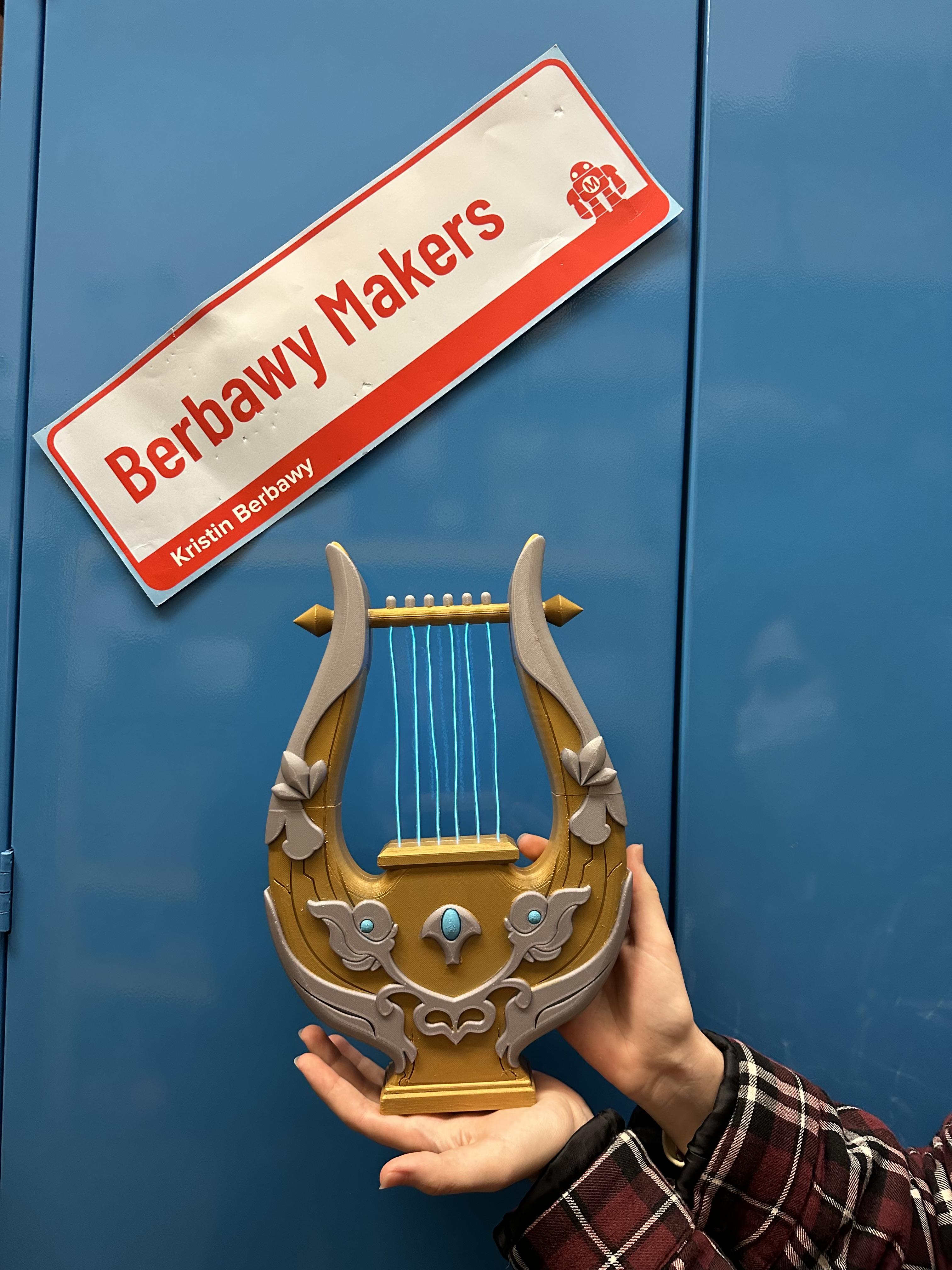Lyre Der Himmel From Genshin Impact
by EliaZ in Craft > Costumes & Cosplay
3811 Views, 37 Favorites, 0 Comments
Lyre Der Himmel From Genshin Impact
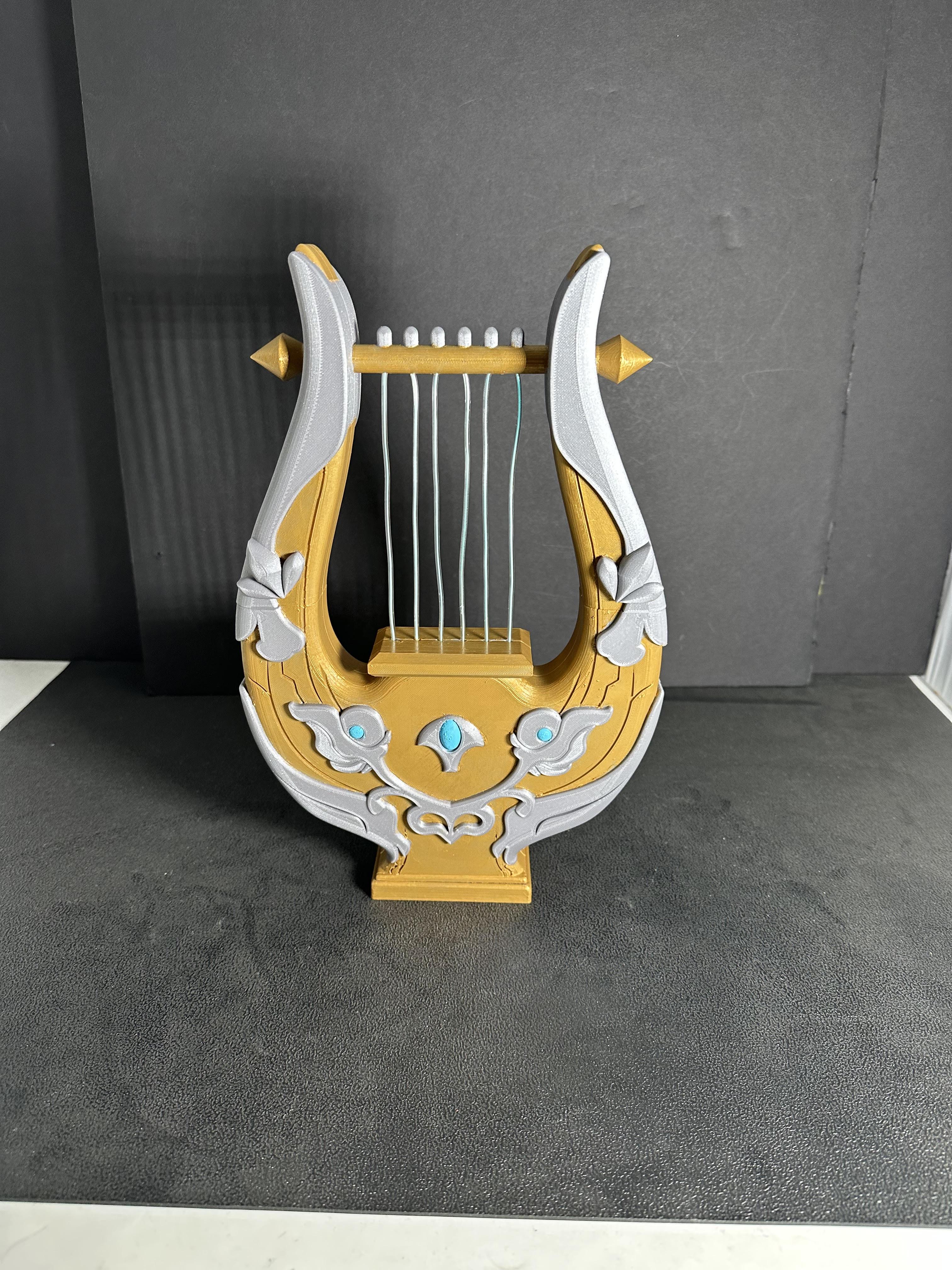
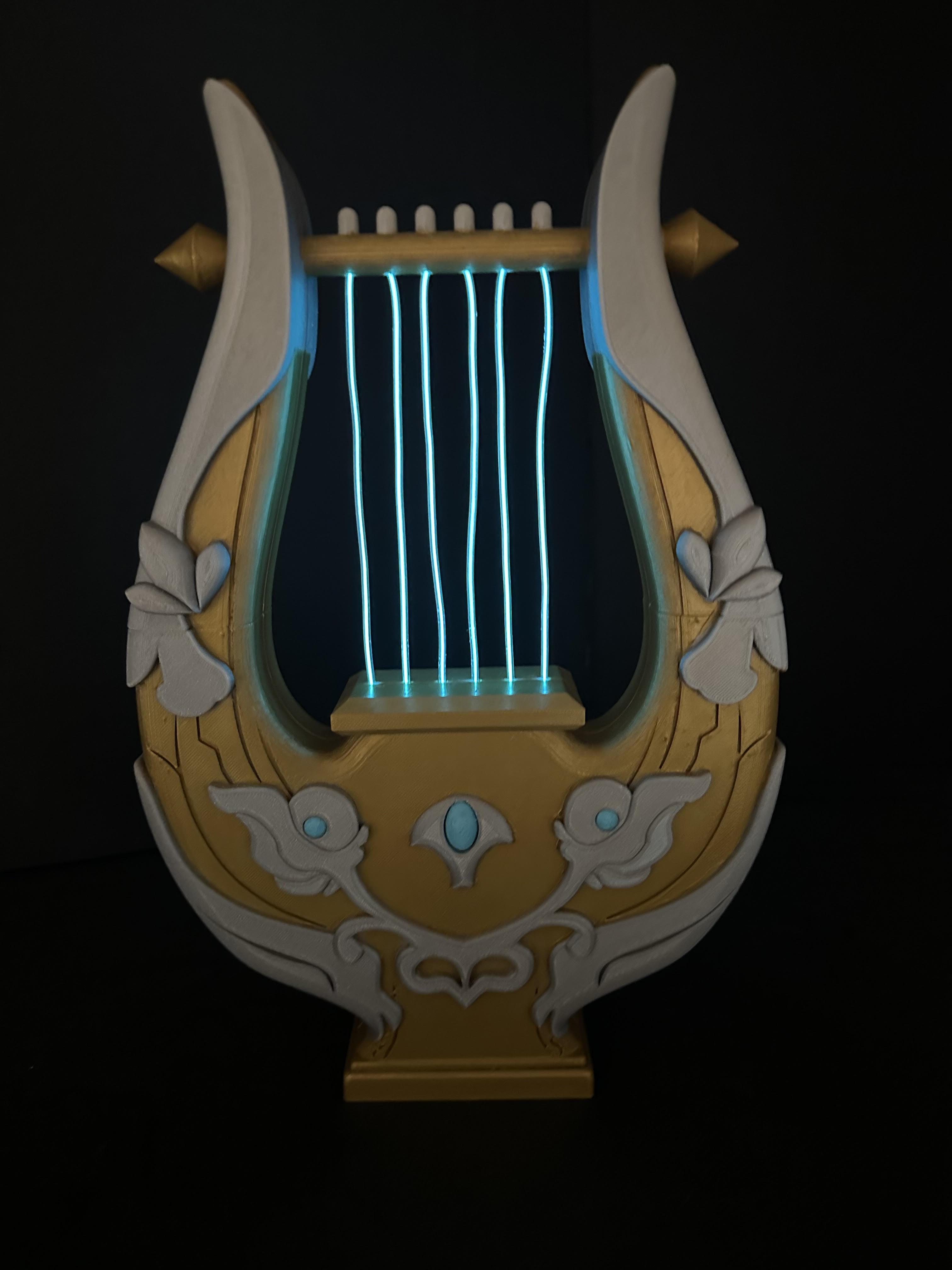
This project is a 3D-printed Lyre der Himmel from Genshin Impact. It's a fun project that involves a lot of CAD.
We created it for our SIDE project in Ms. Berbawy's Principles of Engineering class. We took inspiration from this creation by Jason Do on Etsy and referenced these 3-D models by yadhbil on sketchfab when creating the details.
- Elia Z. and Arsheen P.
Supplies
- CAD software, our instructions will be based around Fusion 360
- If you are brand new to cad this project may be difficult as it involves a lot of troubleshooting
- 3d printer, we used a Prusa MK3S+
- Long wooden dowels
- PLA filament (we used Prusament Galaxy Silver)
- Gold and light blue acrylic paint, or the color you want for the detailing
- Blue LED lights
- Paint brushes
- Super glue
Trace the Outline of the Lyre
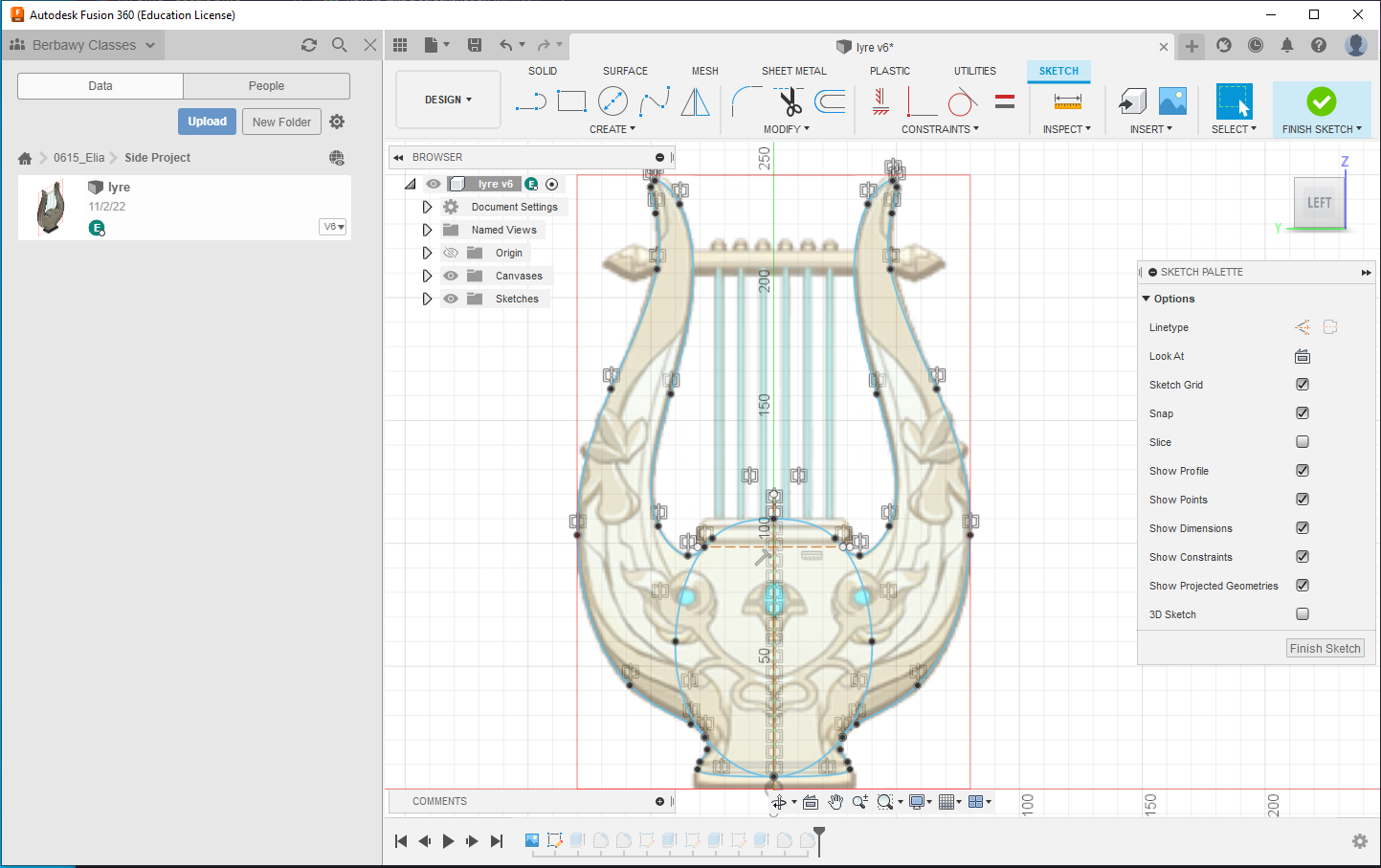
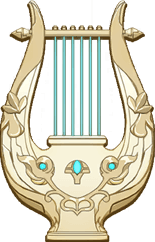.png)
- Use canvas tool in fusion and put in a picture of the lyre
- We have attached the photo that we used
- We sized it to be 250mm
- Start a sketch on the same plane as the canvas
- Make sure you don't start a plane on the canvas
- Using the curvature tool trace the outline of the lyre's main body as shown in our sketch
- Finish the sketch
Sketch the Shape
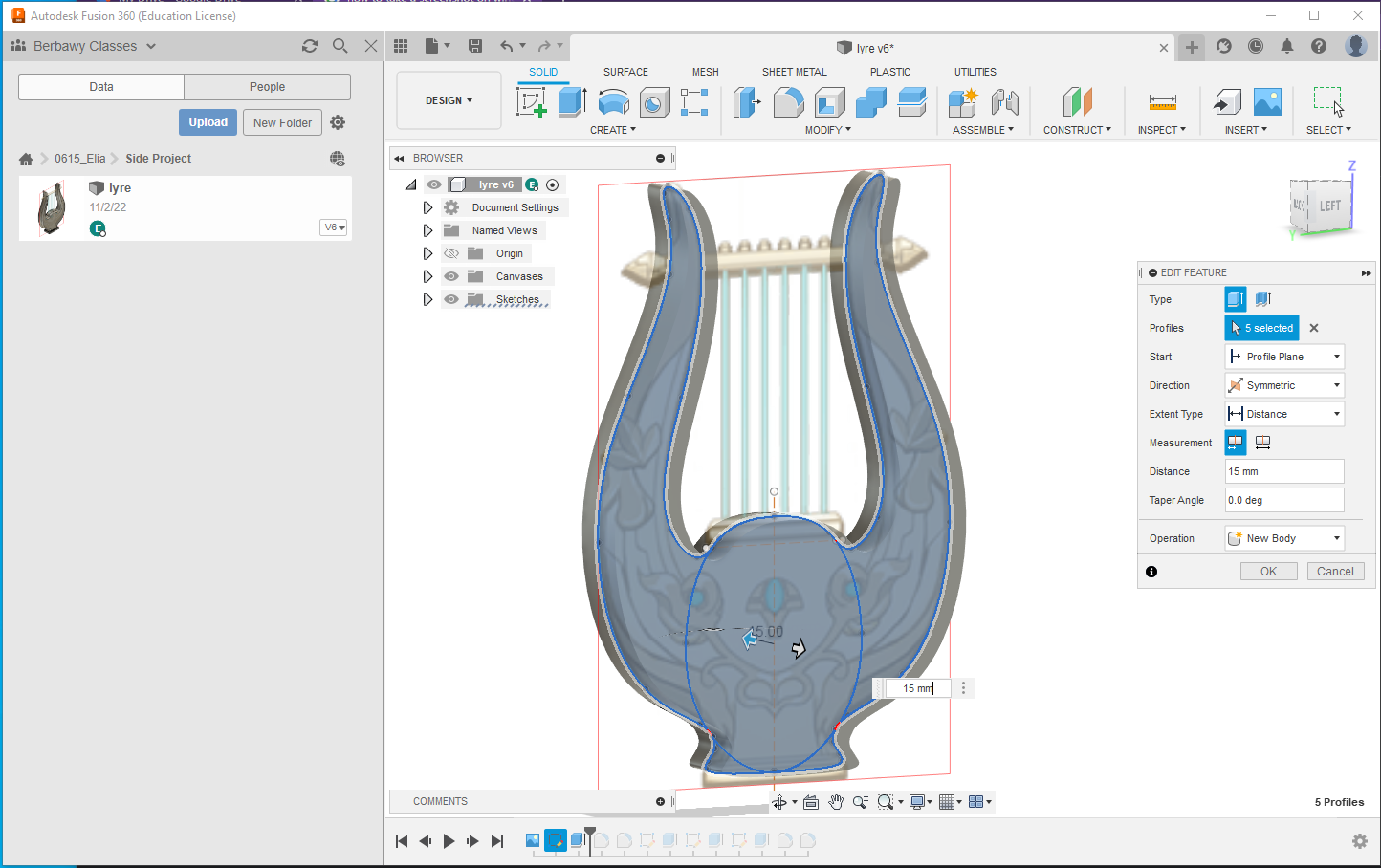
- Select the whole sketch
- Make a symmetrical extrusion of 15mm
- Total width will be 30mm
Extrude the Body
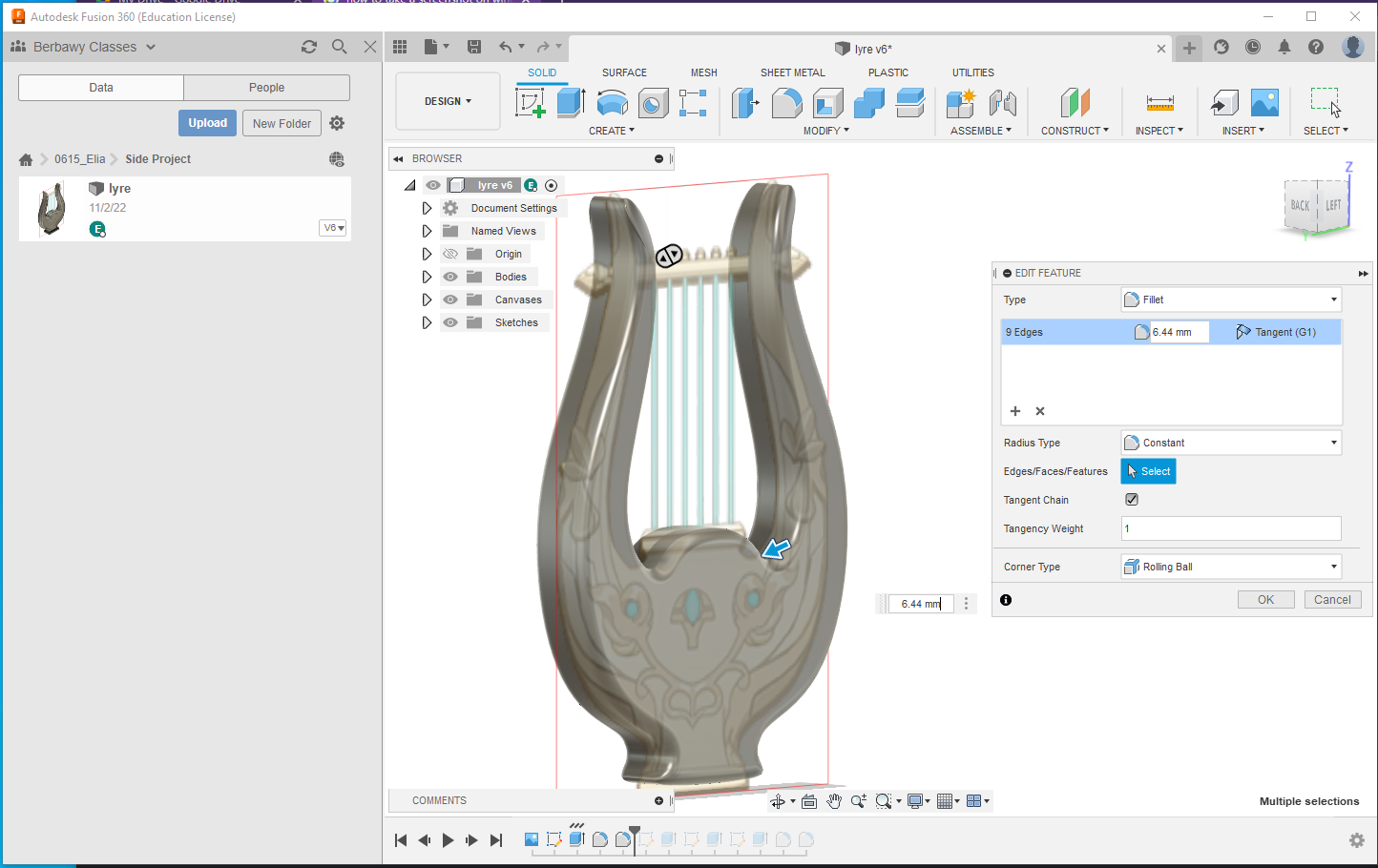
- Select the edges of the lyre and fillet them by anywhere from 6-7 mm
(You may encounter an error when trying to fillet the lyre. We couldn't find what exactly happens, but fusion sometimes has an issue filleting complicated shapes. The best thing to do is make sure the the shape of the lyre doesn't have any sharp angles and to play around with the fillet size. 6.44mm worked for us.)
Sketch the Base
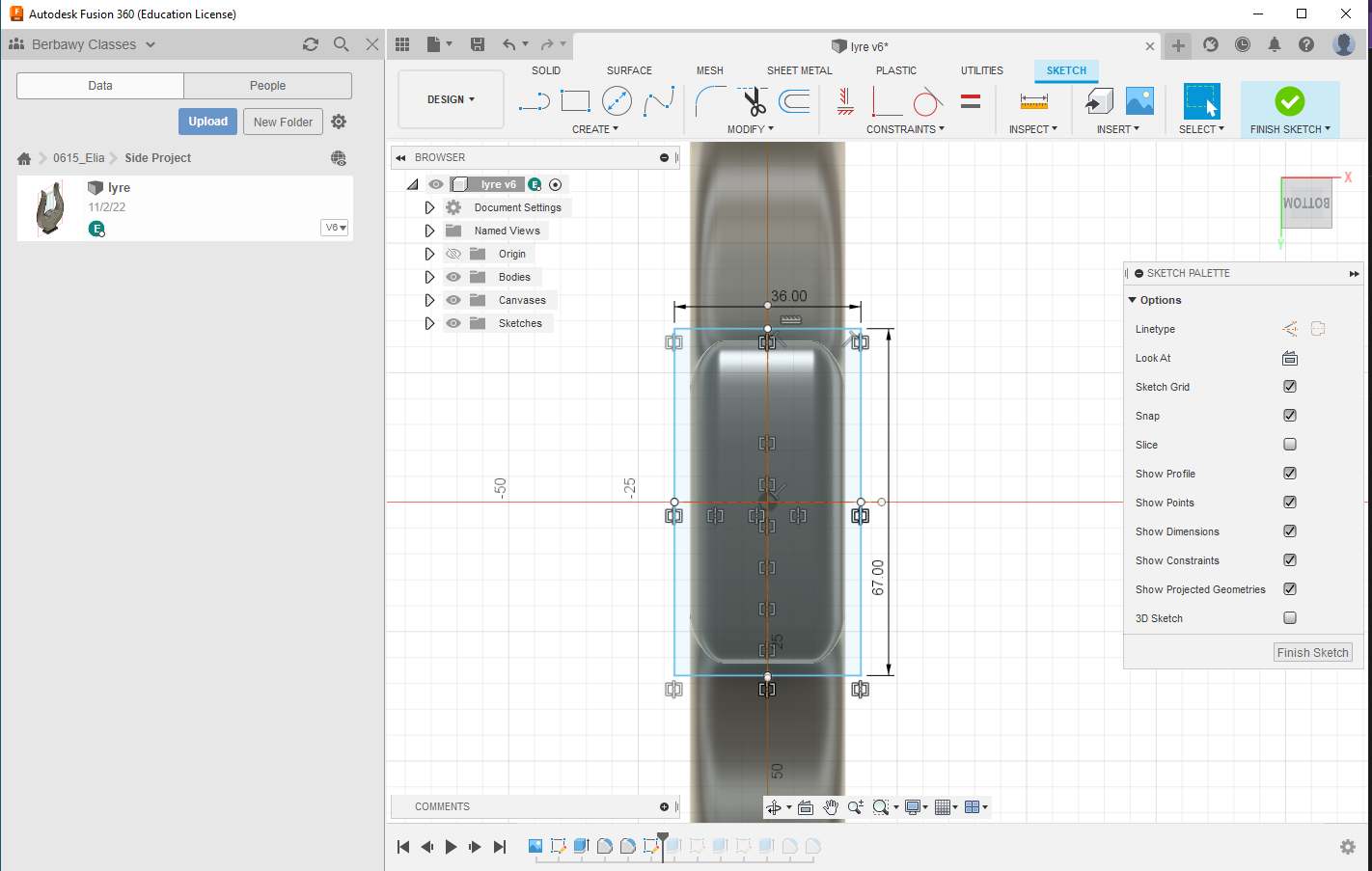
- Make a sketch on the plane parallel to the base of the lyre
- Create a 36mm by 67mm rectangle
- Finish the sketch
Extrude the Base
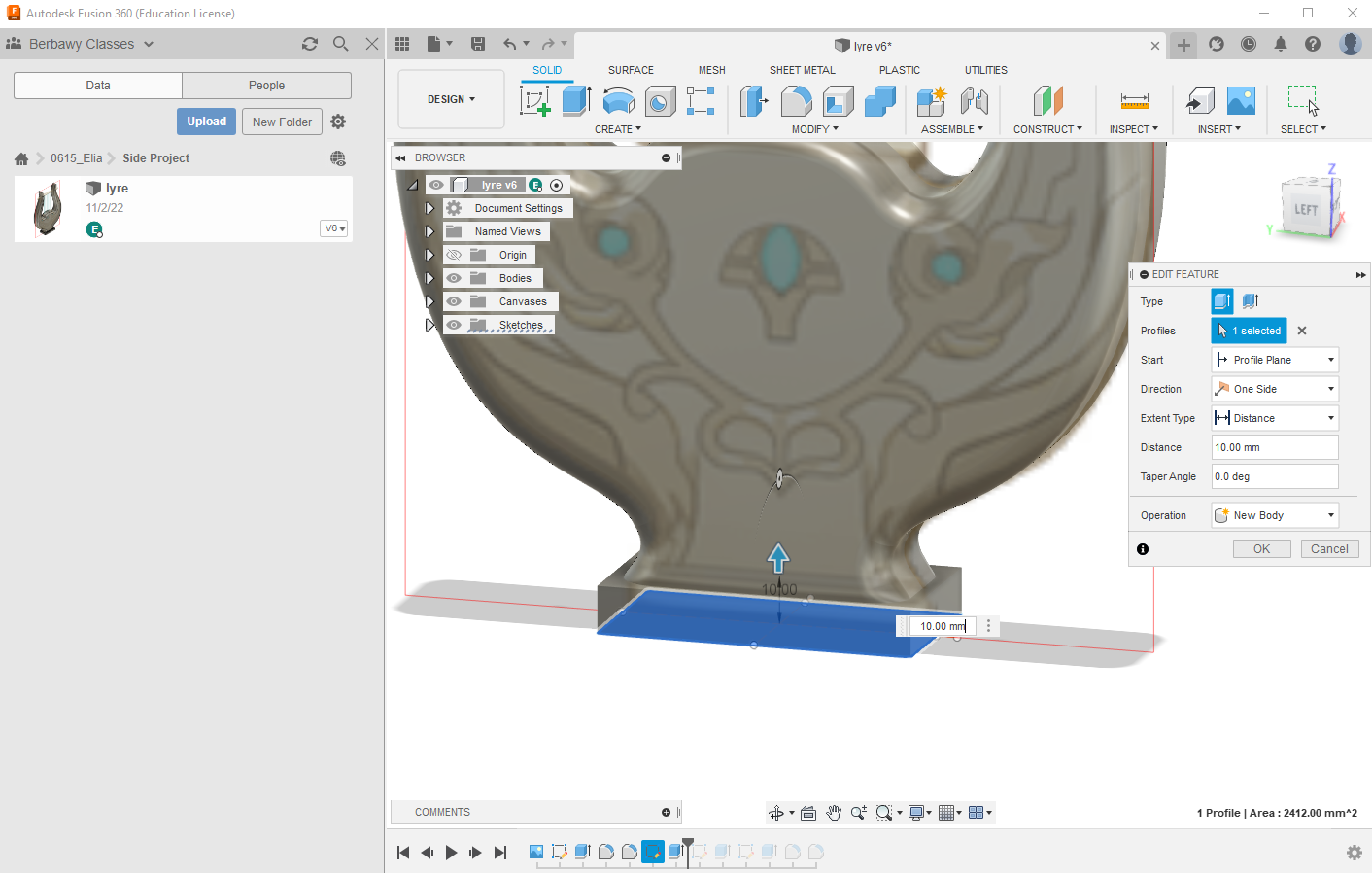
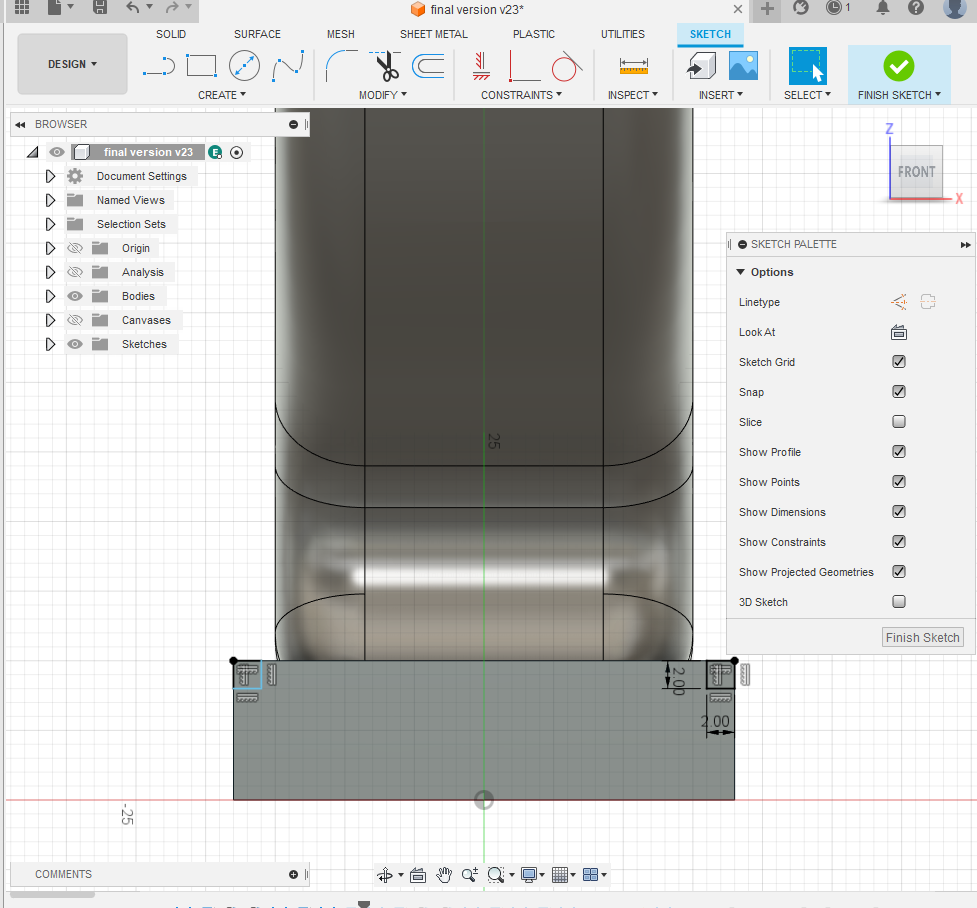
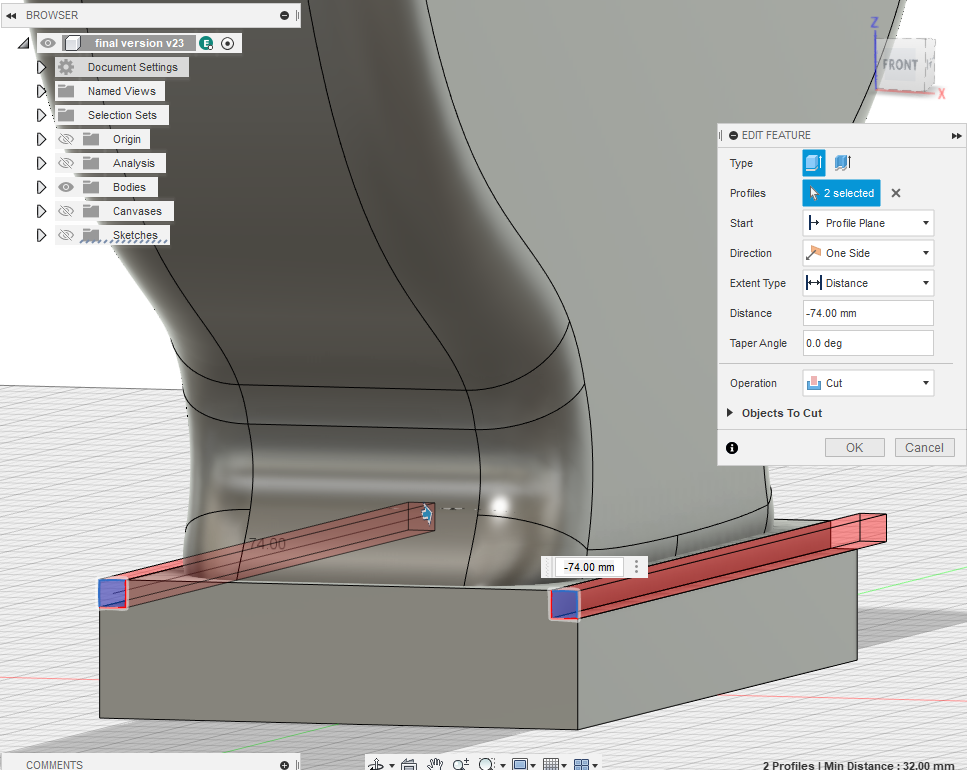
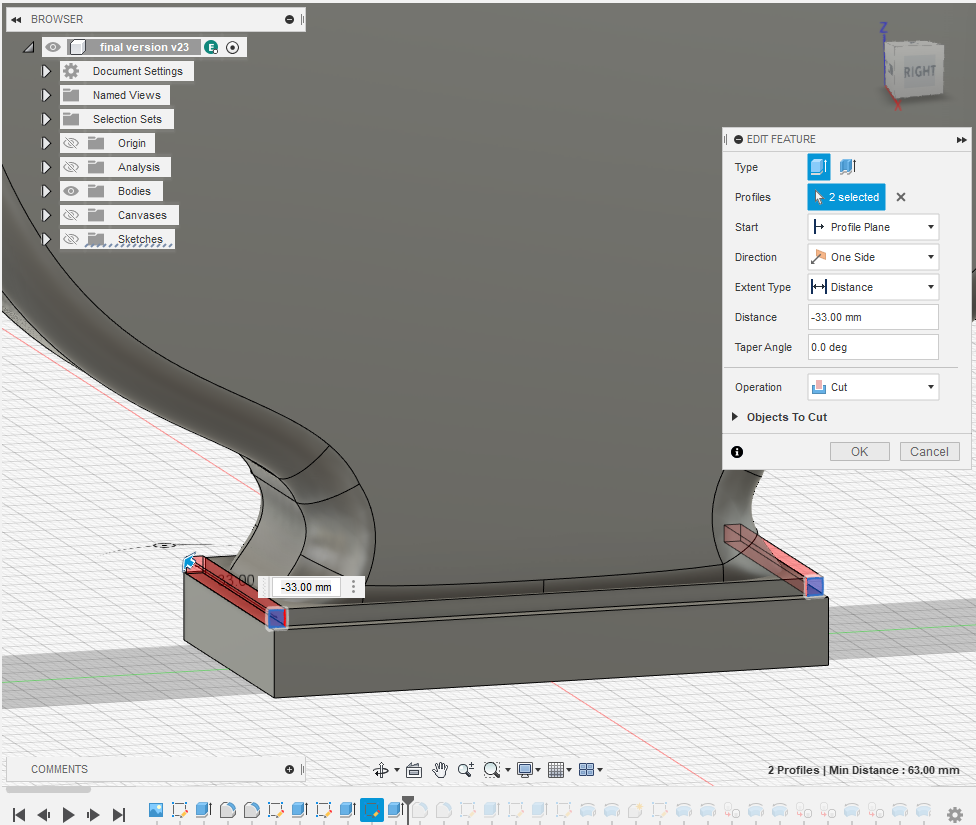
- Extrude the rectangle up 10mm
- Make a sketch on the front face of the block you have just created
- On the top right corner create a 2mm by 2mm square
- Repeat on top left corner
- Finish the sketch
- Create a new sketch on the right side face
- Repeat step 3
- Finish the sketch
- Make a cut that goes all the way through using each of the squares
Filet
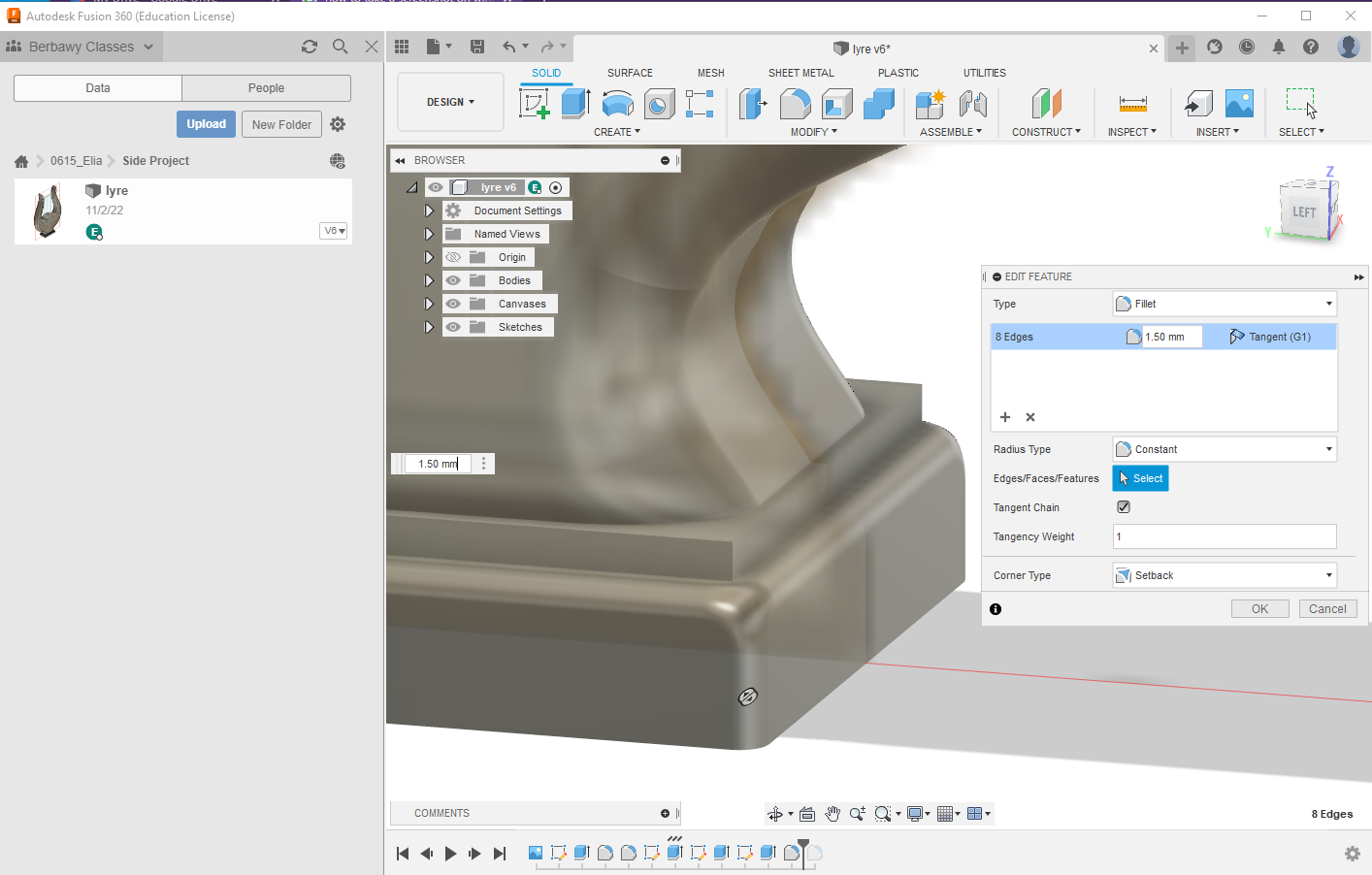
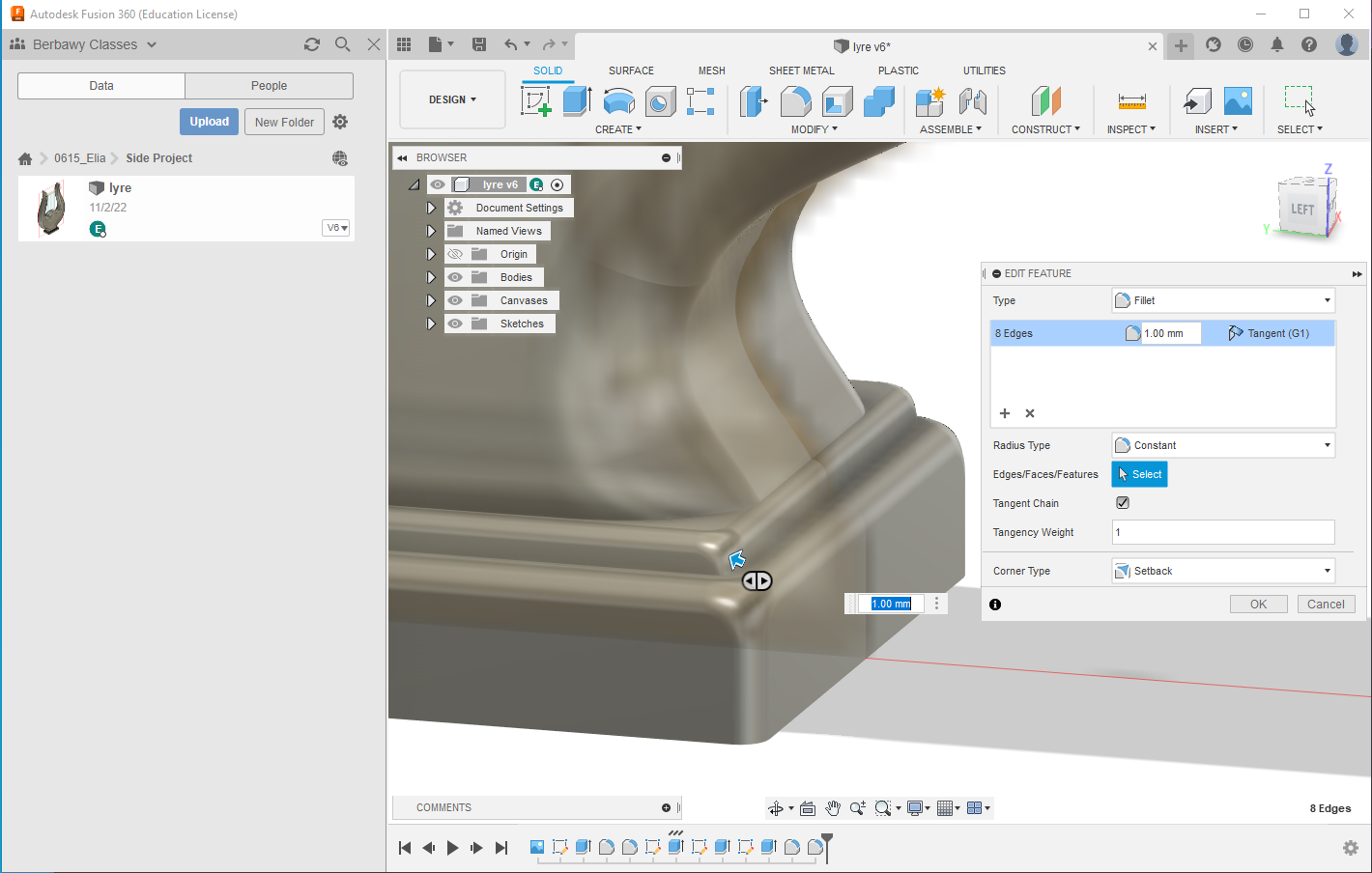
- Selected the edges around the bottom part of the base
- Fillet them by 1.5mm
- Select the edges around the top portion of the base
- Fillet them by 1mm
Create the Middle Part
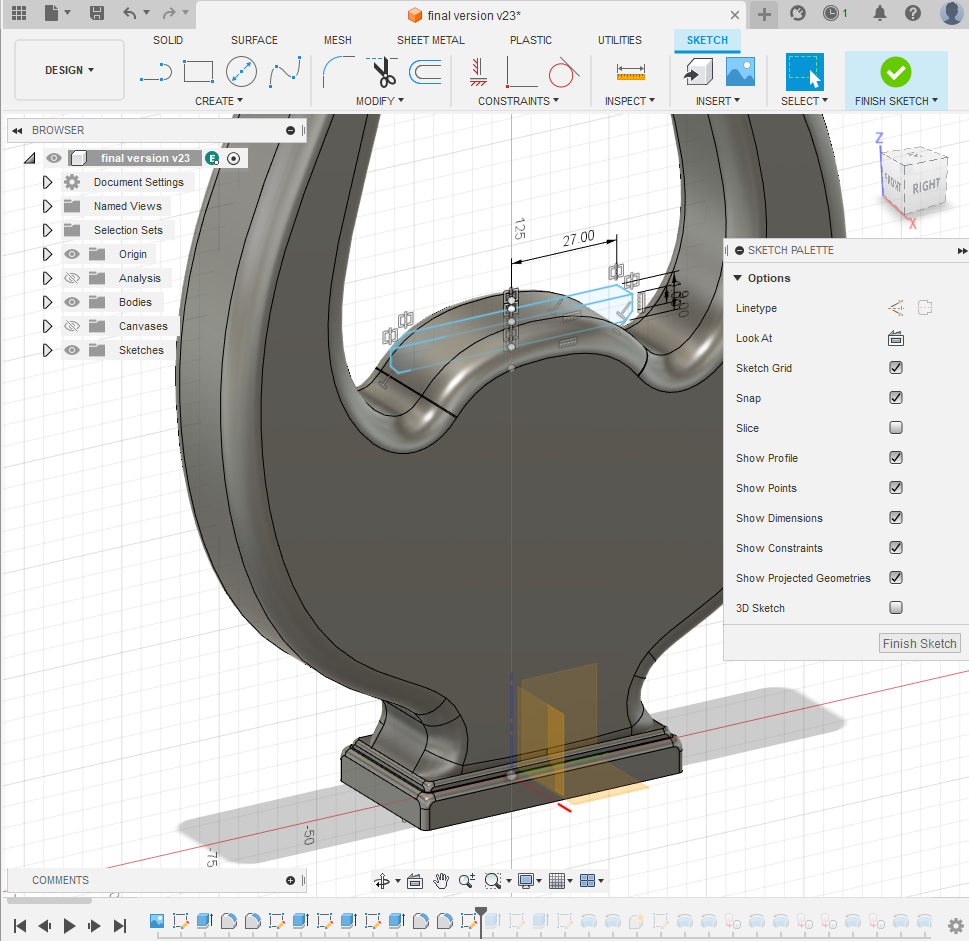
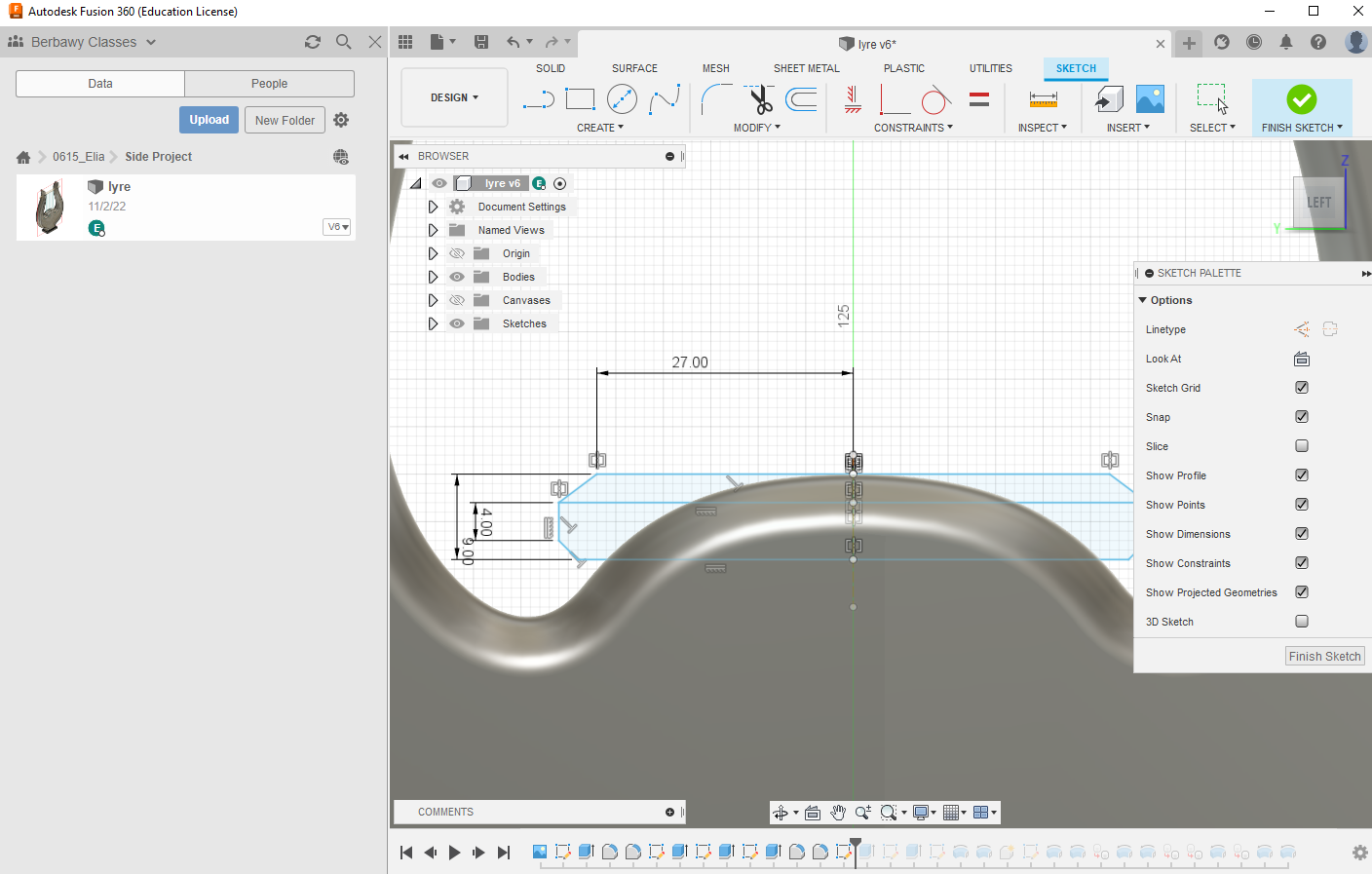
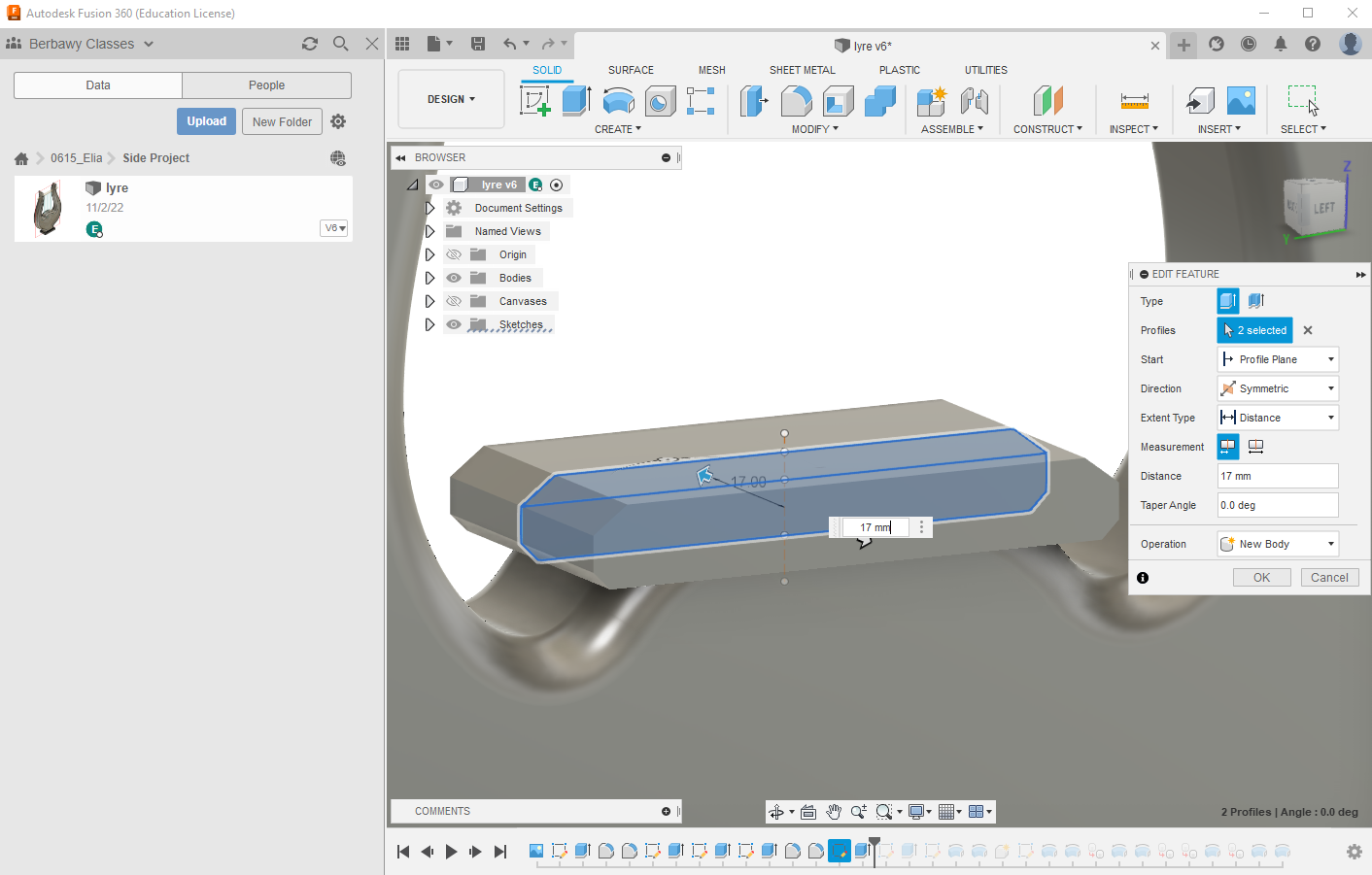
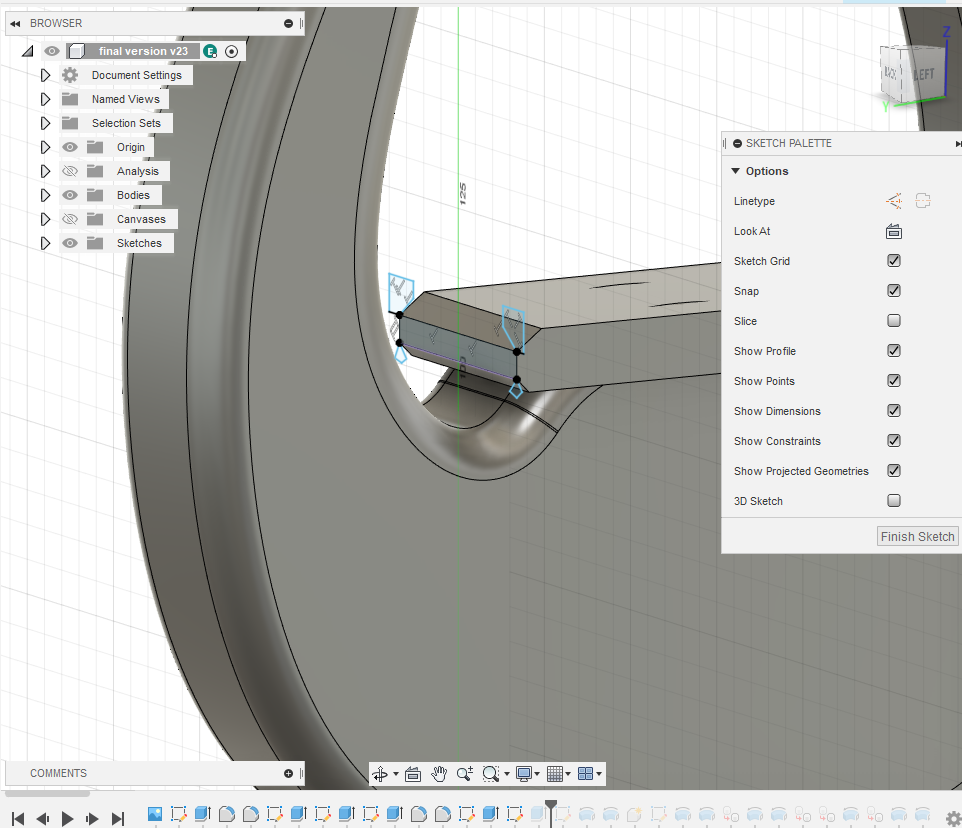
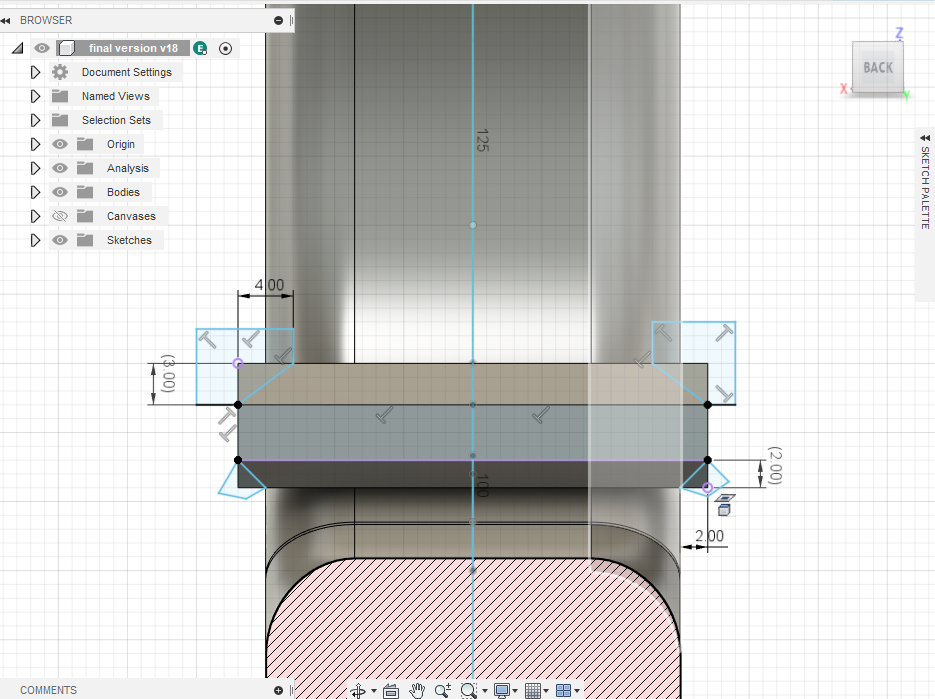
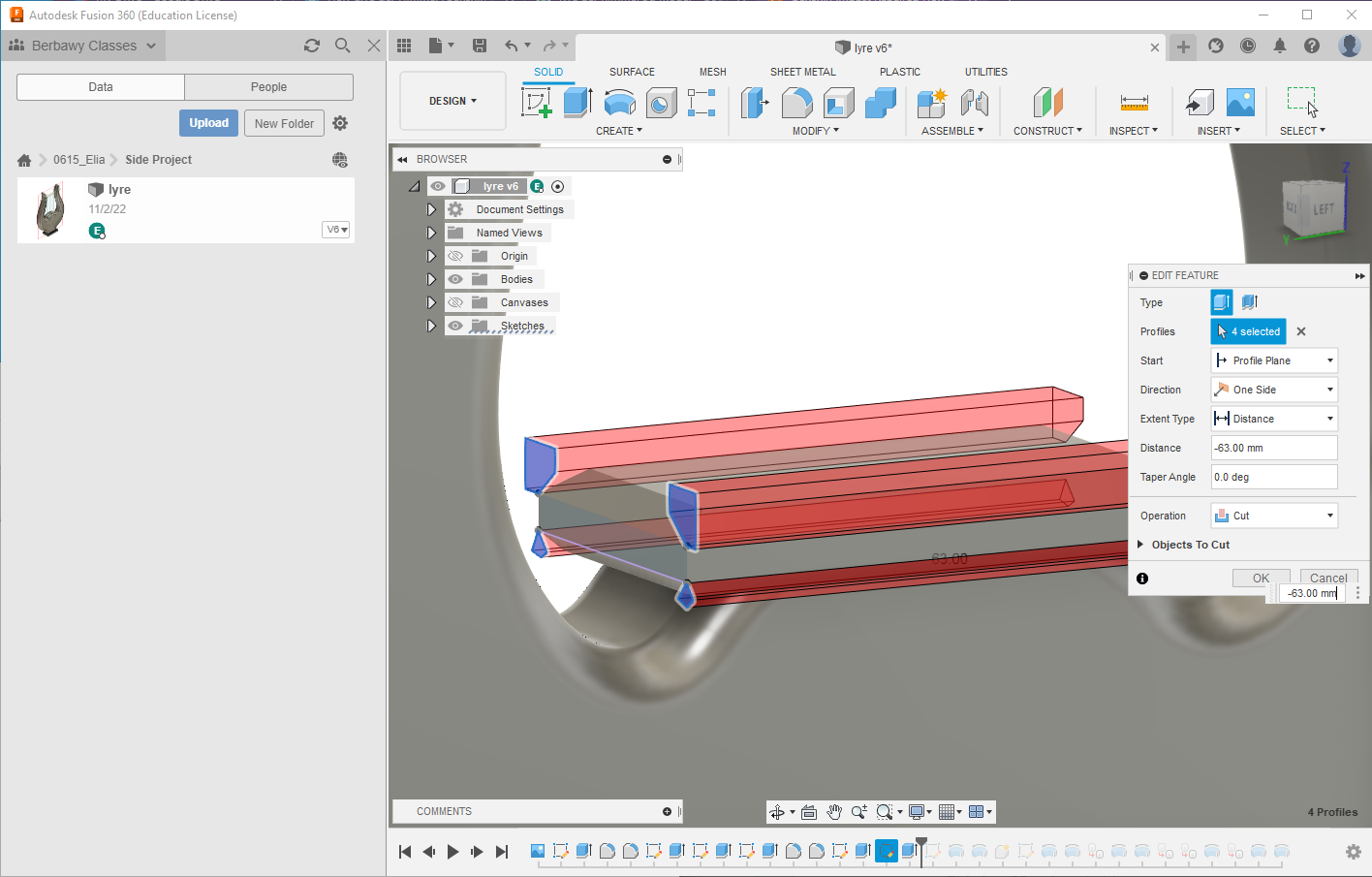
- Create a sketch on the plane that cuts the lyre in half parallel to the front of the lyre
- Use the line tool to create the shape shown above with the same dimensions
- It should be symmetrical across the centerline
- Do a symmetrical extrusion of 17mm
- Make a sketch on the side of the extrusion you just made
- Use the line tool to create the sketch as shown in image 2
- Finish the sketch and make a cut that goes through the entire block
Top Bar
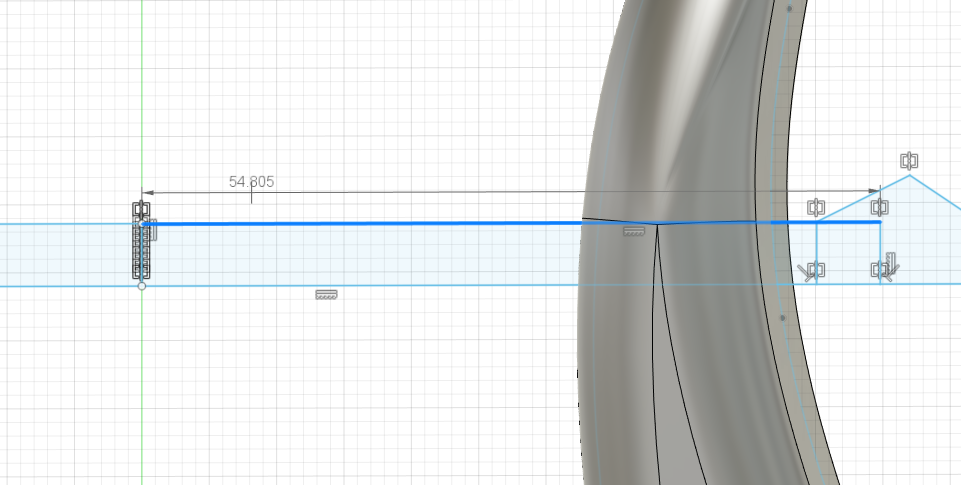
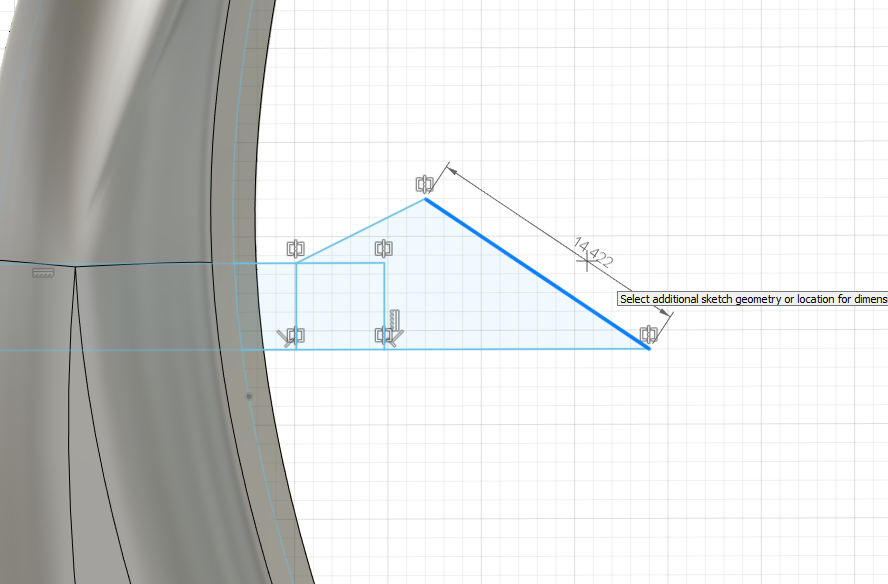
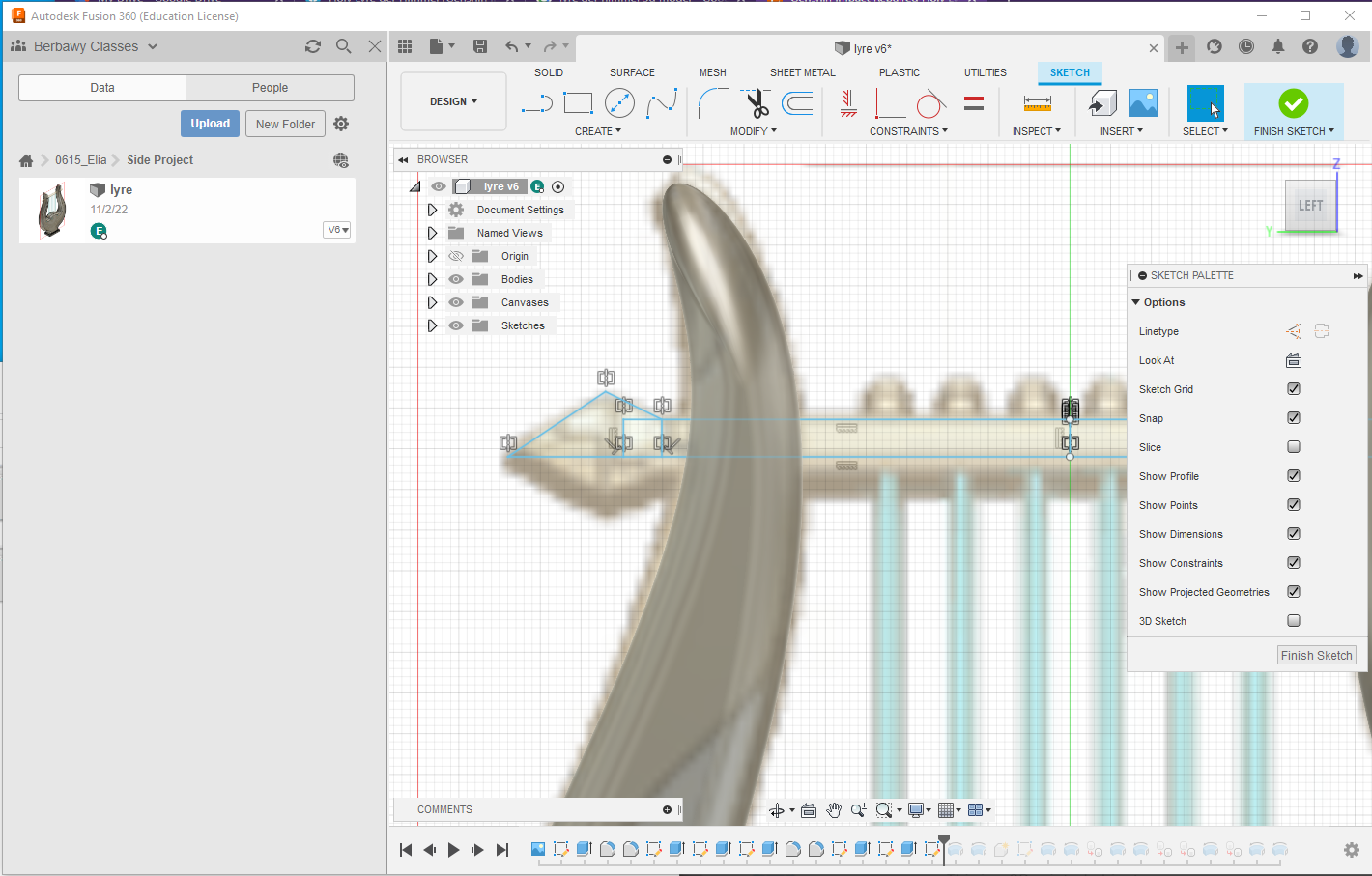
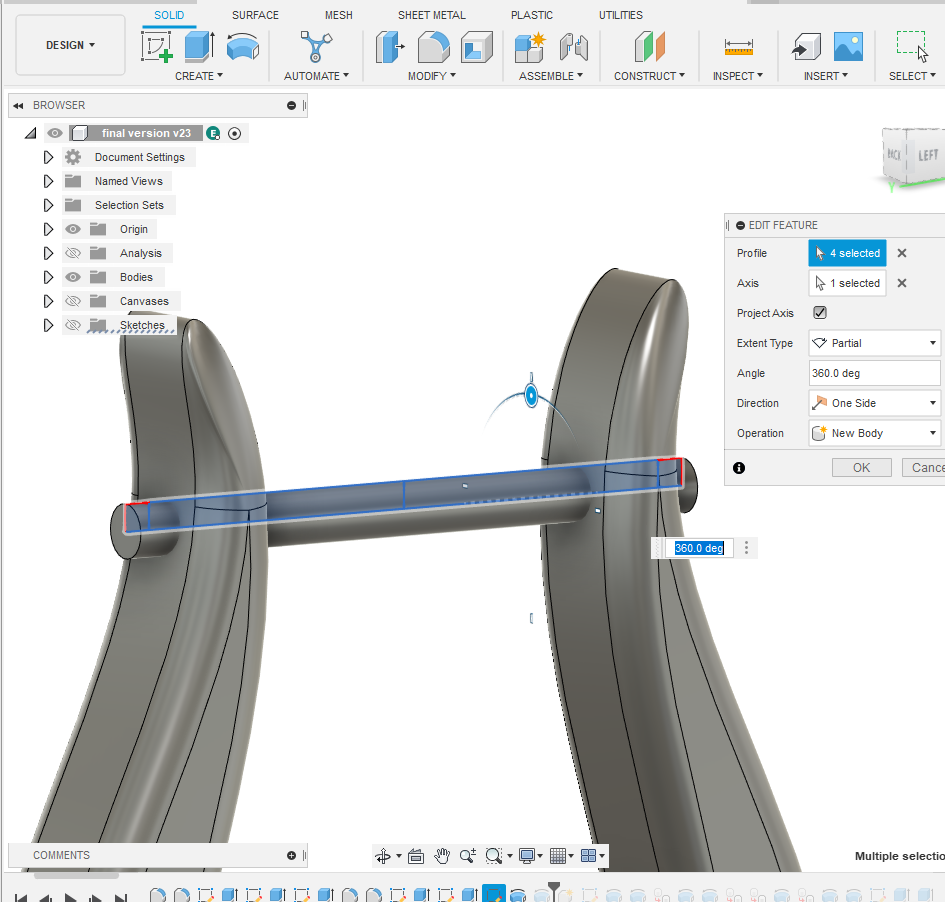
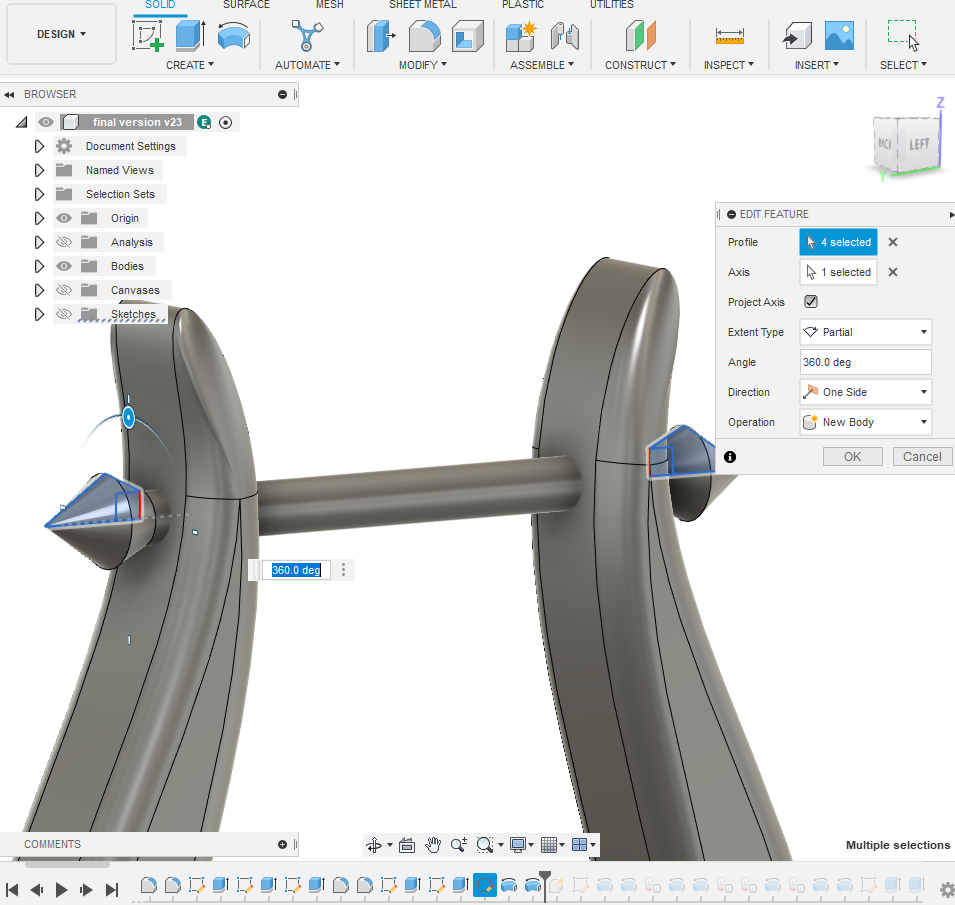
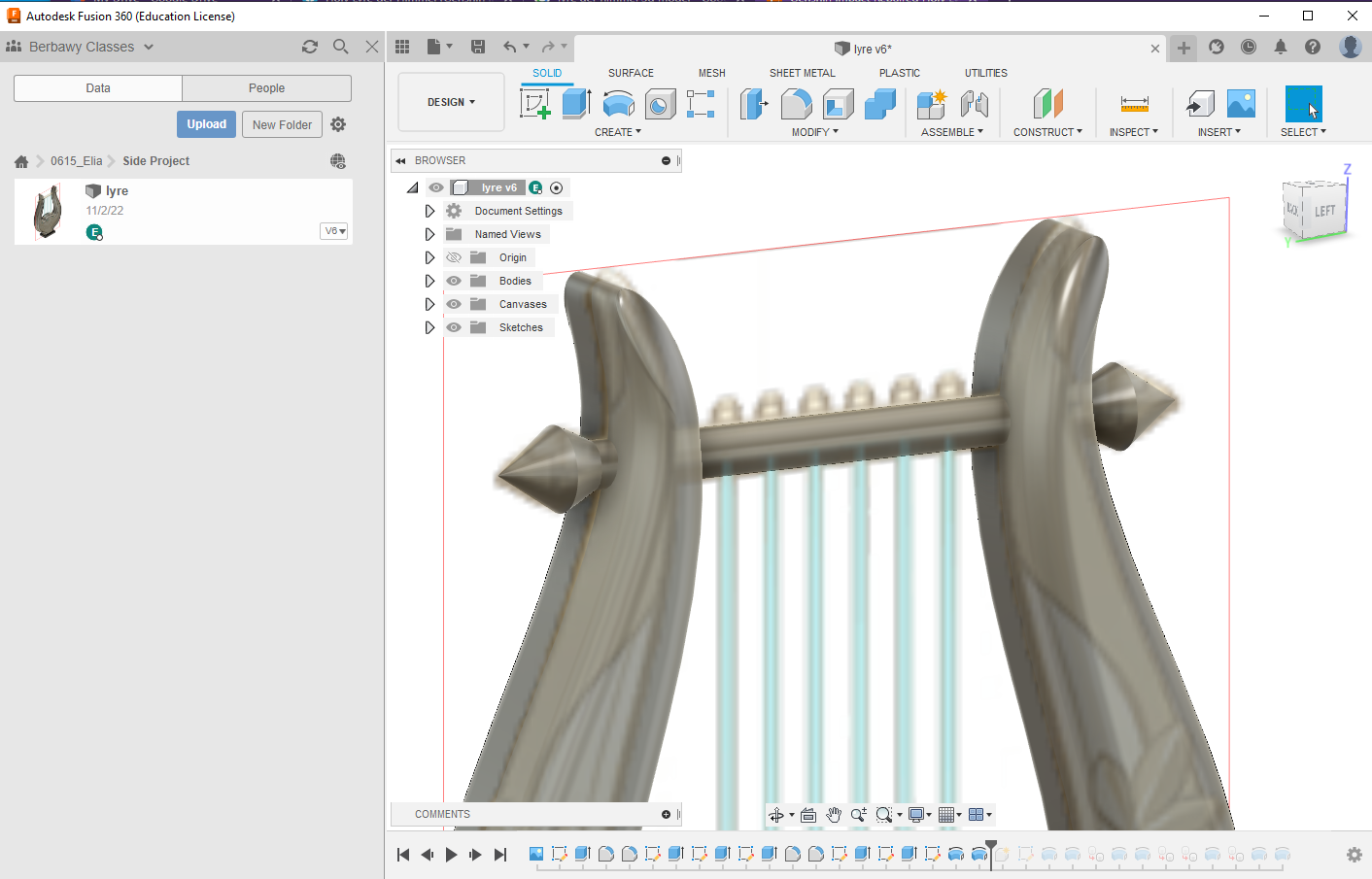
- Create a sketch on the plane that cuts the lyre in half parallel to the front of the lyre
- Create two parallel lines with the length of 54.805 mm. They should be 4.59 mm apart vertically.
- Create a triangle-like sketch for the edge arrow. The bottom length is 14.195mm. The top diagonal shorter-side is 6.91 mm. The top diagonal longer-side is 14.422 mm.
- Reflect both the sketches from step 2 and step 3 over the y-axis.
- Use the revolve feature and revolve the long middle piece 360º.
- Use the revolve feature and revolve the edge arrows 360º.
Nobs
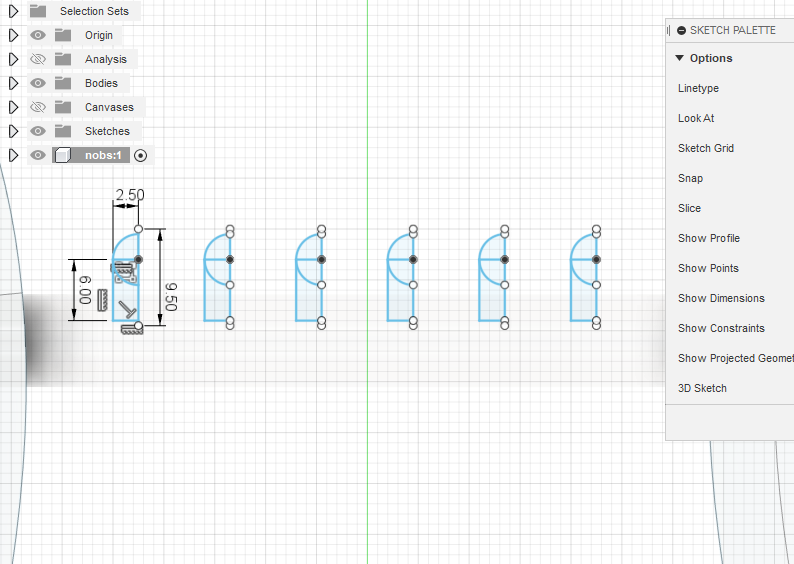
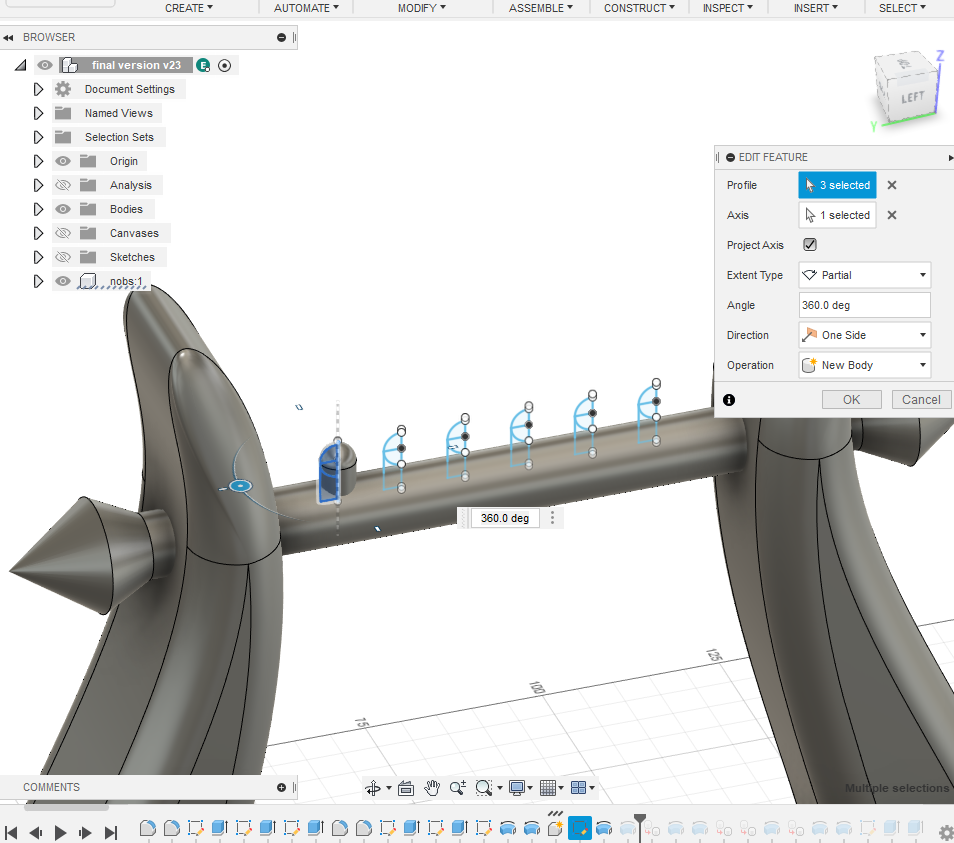
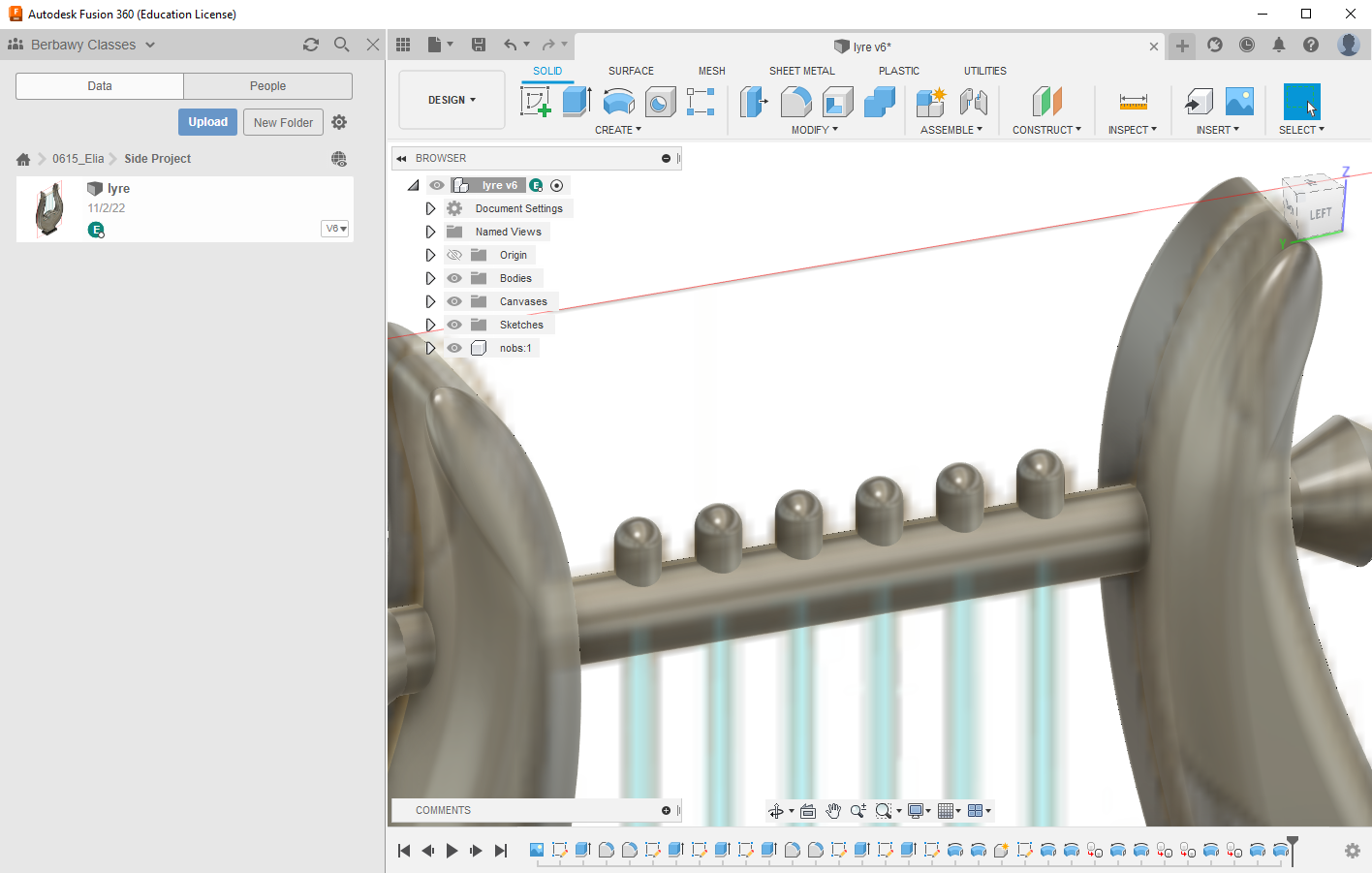
- Make a sketch on the plane that cuts the lyre in half parallel to the front of the lyre
- Create a nob with the dimensions shown
- Use the rectangular pattern tool and make 6 iterations all 6.5 mm apart
- The middle right nob should be about 2 mm from the centerline
- Finish the sketch
- Revolve each nob
Base Finished
From this point on we will be adding detailing for the lyre. No actual dimensions can be given as we usually used some combination of the line, curvature, and ellipse tool to sketch out the detailing before extruding it. This part of the project will require a lot of trial and error, make adjustments as you see fit.
Details Start
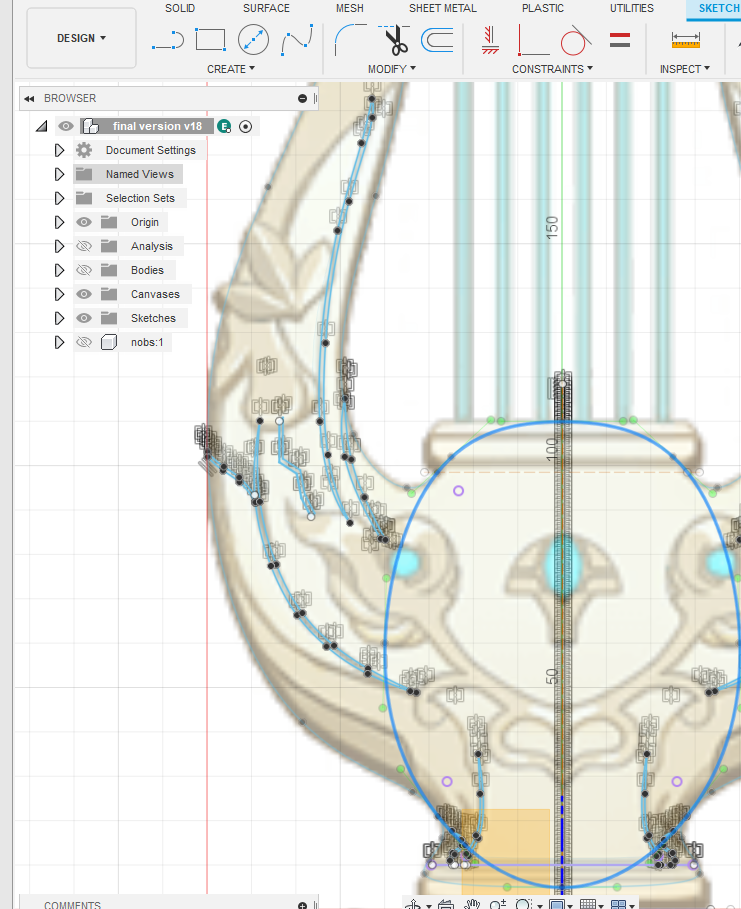
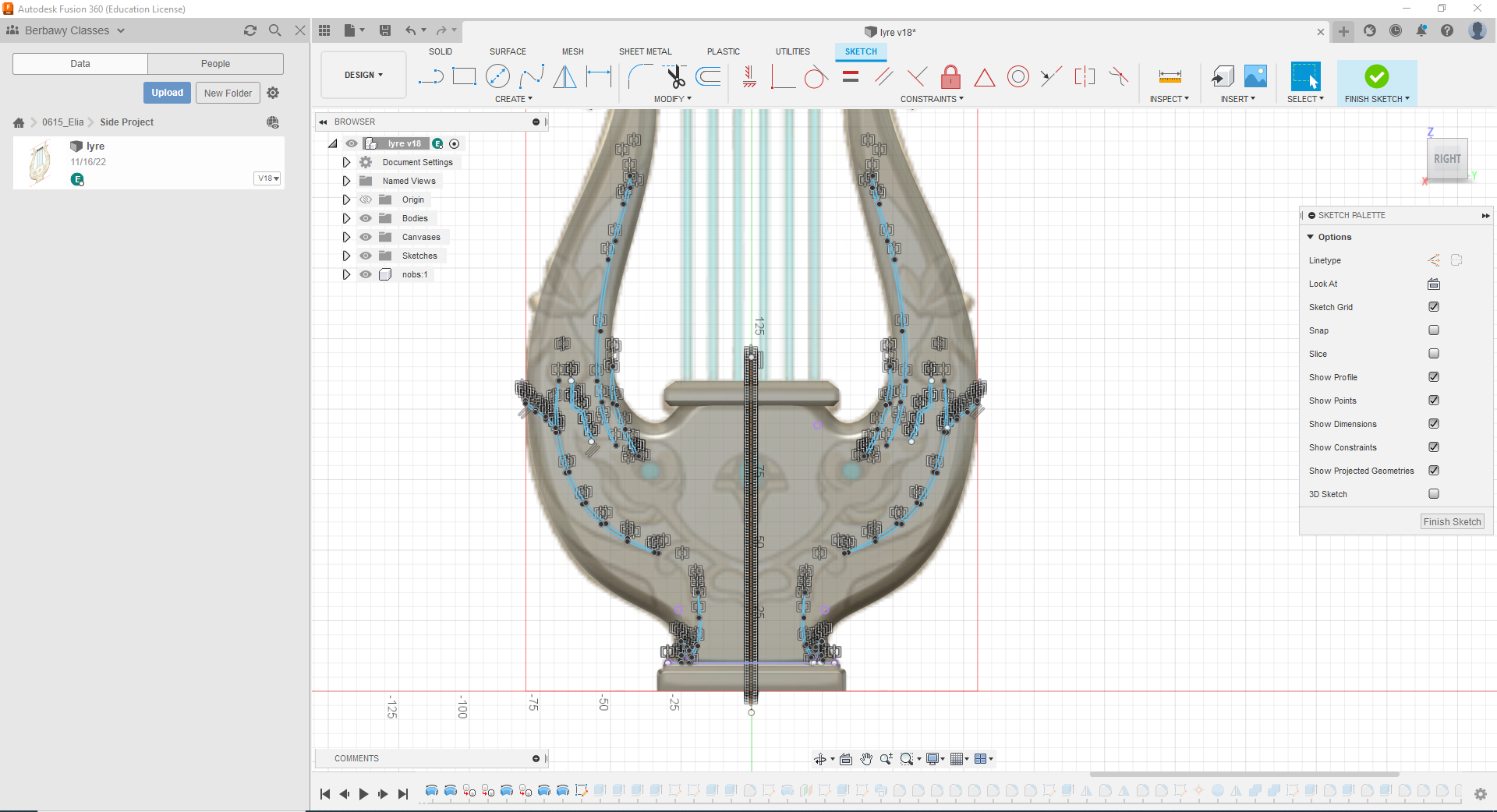
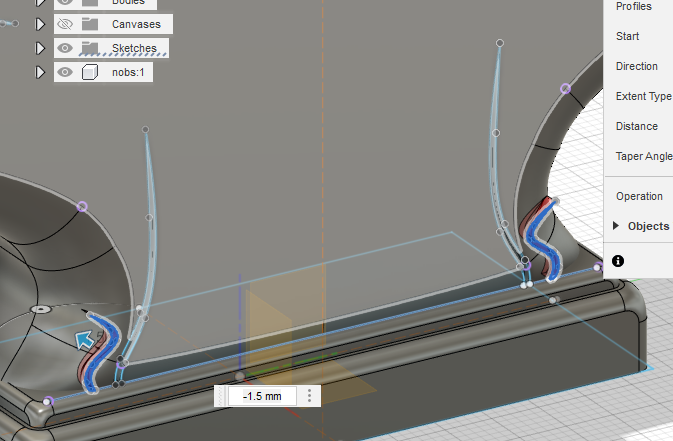
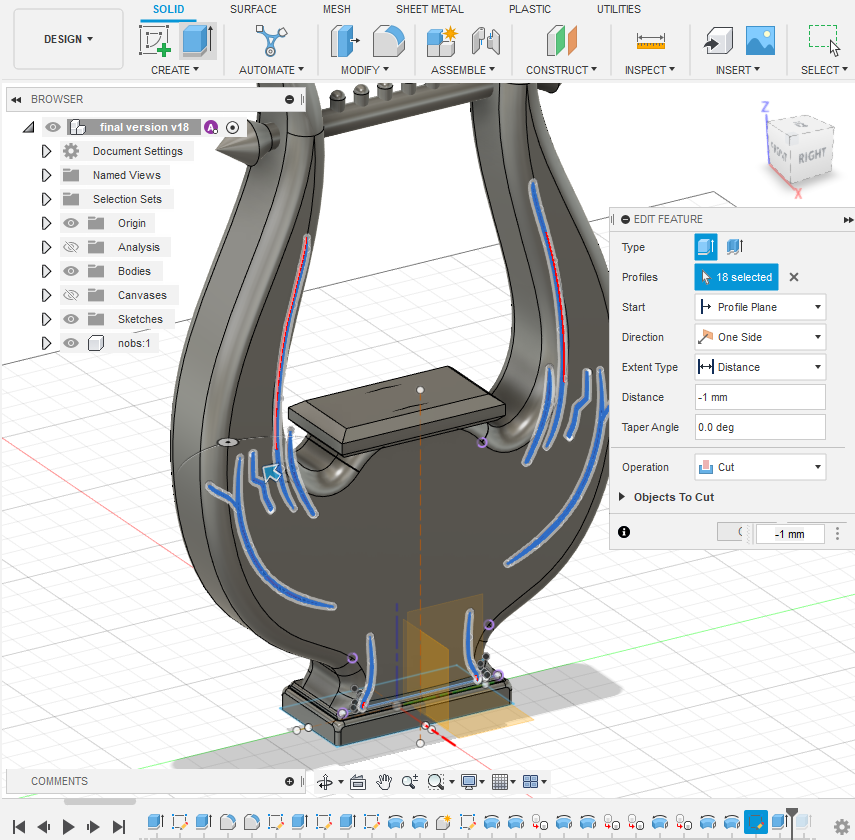
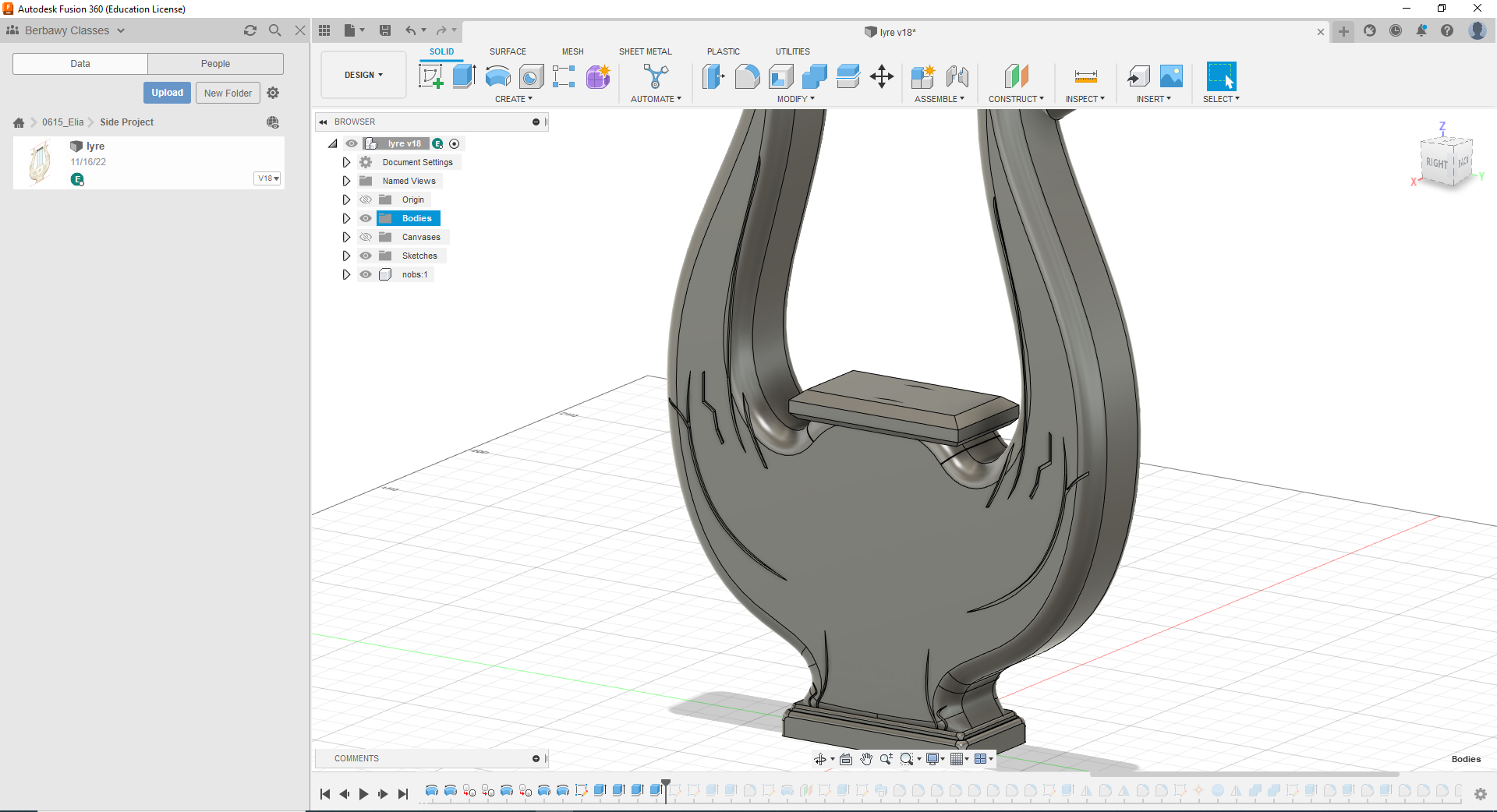
- Turn the canvas back to visible if you hid it at some point
- Start a sketch on the front face of the lyre
- Trace over the detailing shown using the line and curvature tools
- When finished reflect it across the center
- For the two small details at the bottom make a 1.5 mm
- Make a 1 mm cut for the rest of the detail
- When that is all done reflect the cuts to the other side of the lyre
- If fusion gives an error when that happens simply copy and paste the sketch onto the back of the lyre and make the same extrusions
Center Piece
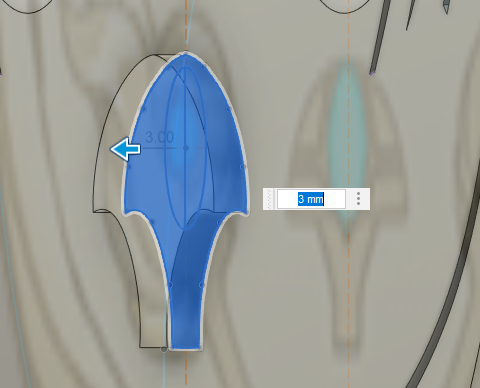
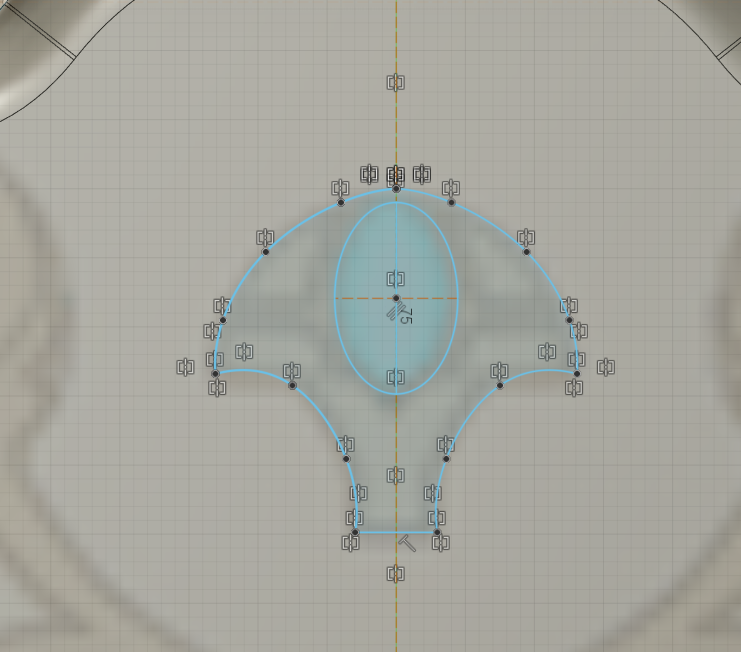
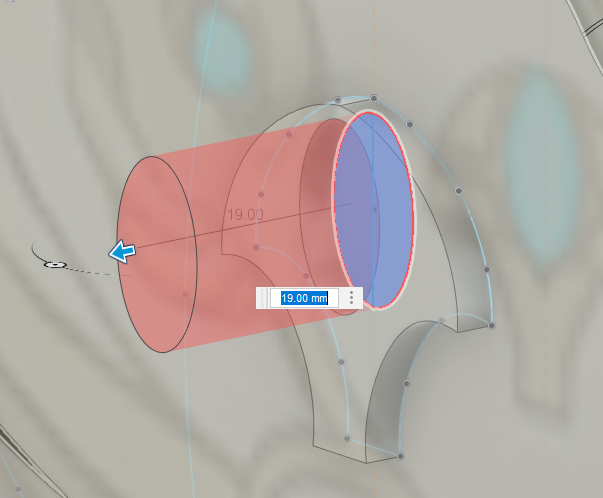
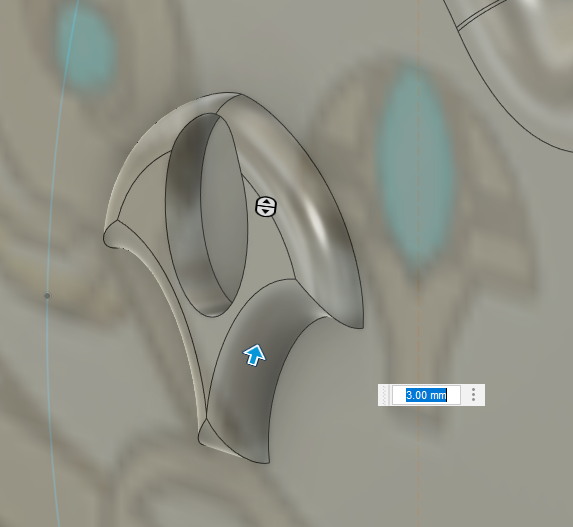
- Create a sketch on the front of the lyre.
- Trace the center gem piece with the curvature tool. Trace the bottom of the piece with the line tool. Trace the center gem with an oval. Only trace half of this piece so you can mirror it to create a symmetrical center-piece.
- Finish the sketch
- Extrude out the entire piece 3 mm.
- Make a cut 19 mm deep on the center gem piece.
- Fillet the outer edge 3 mm.
Center Gem
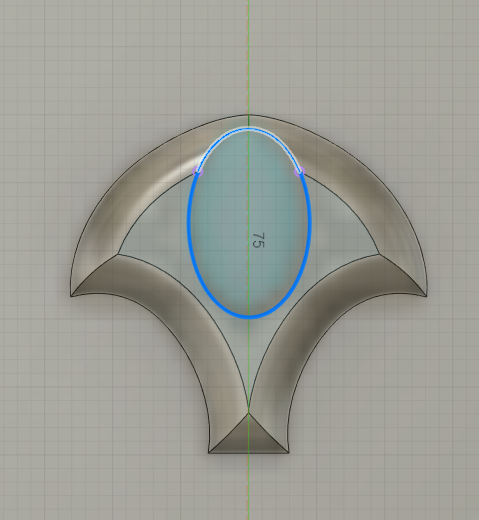
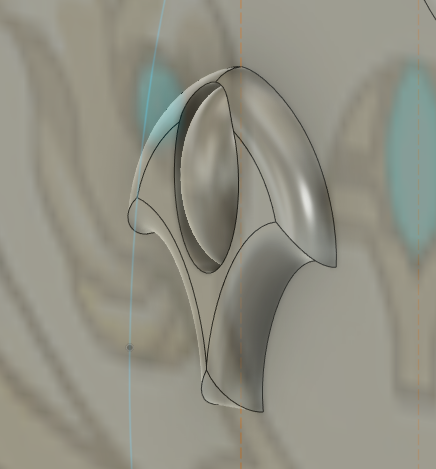
- Sketch a semi-circle where the gem is (make sure to keep the canvas on so you can easily trace the picture).
- Revolve the semi-circle 360º (it should have more of a 3D shape now).
- When finished with this reflect this entire piece to the back of the lyre
Face Detail
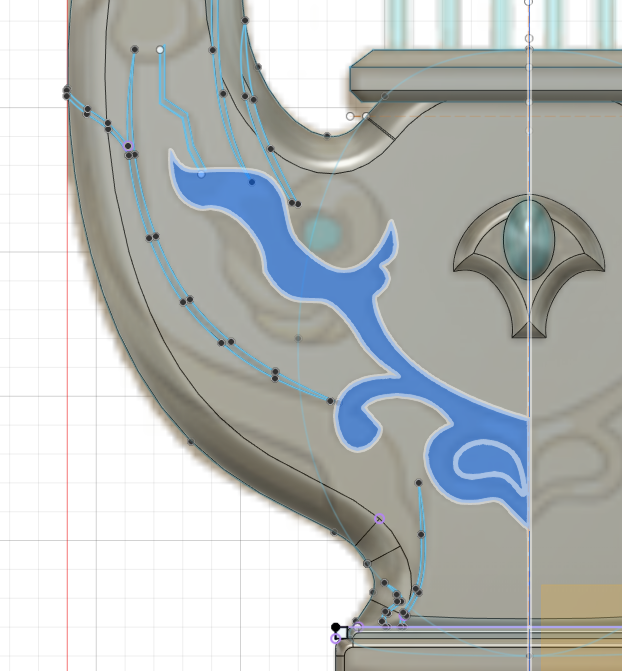
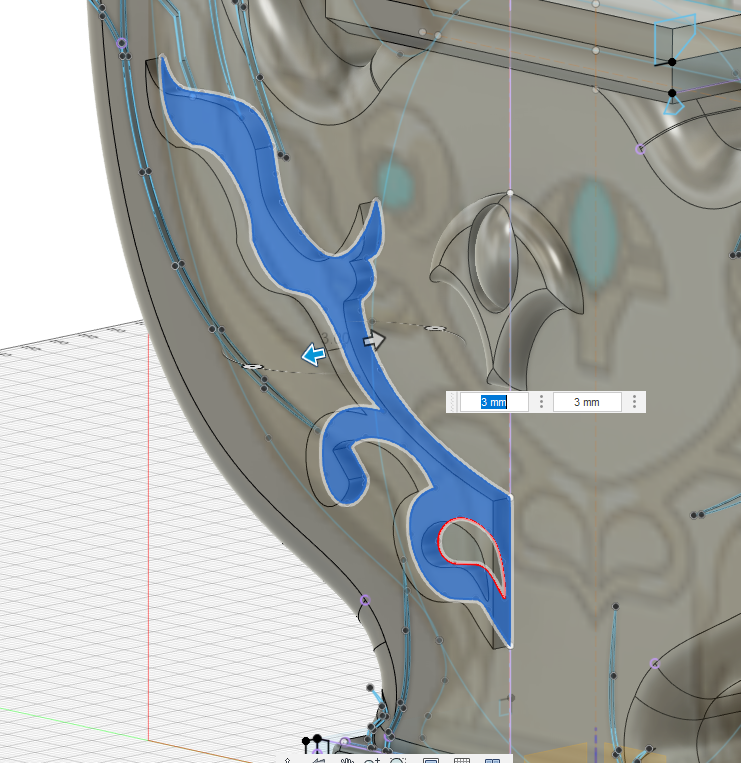
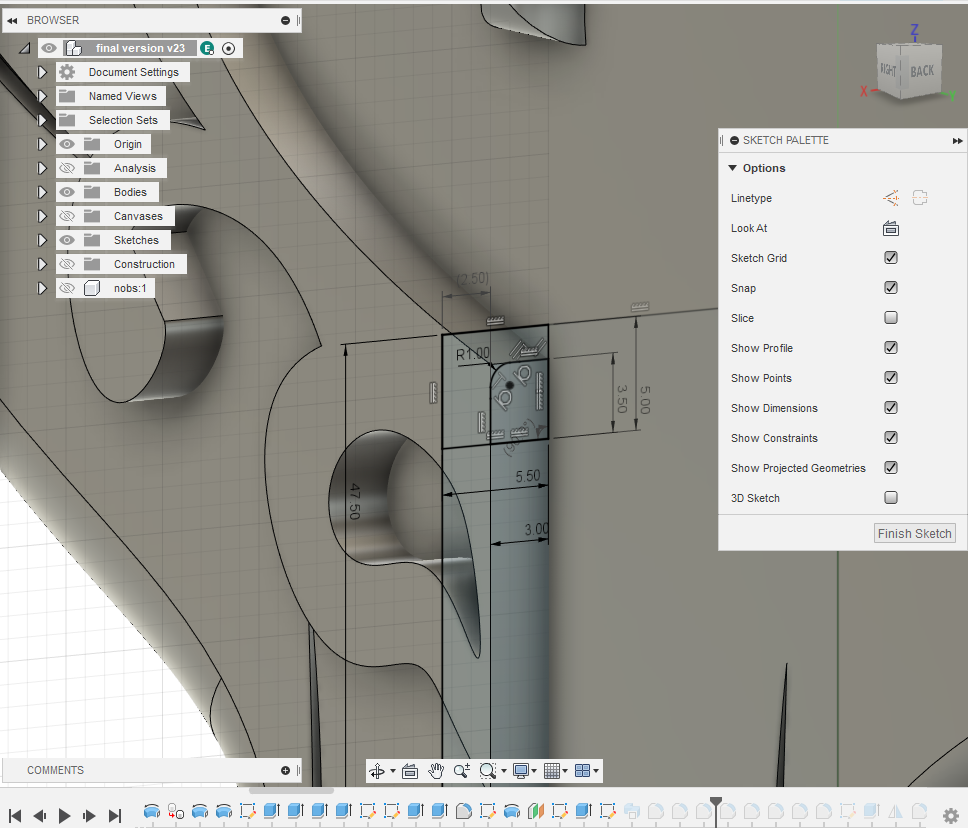
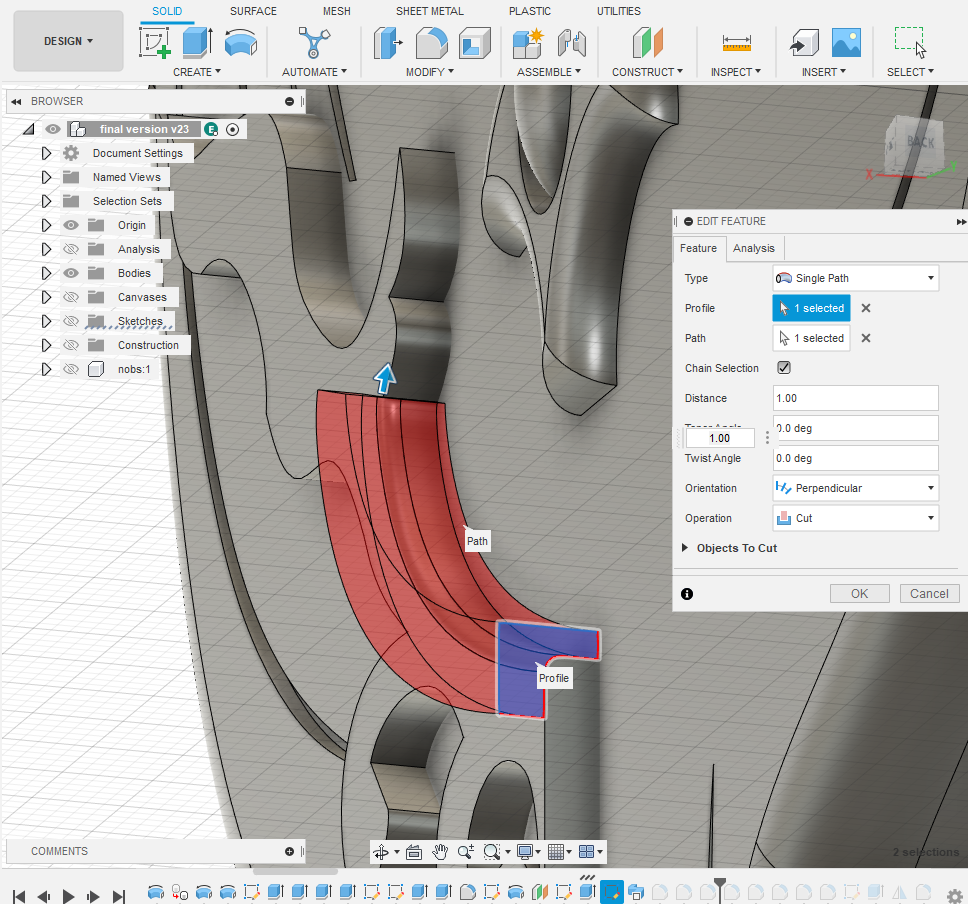
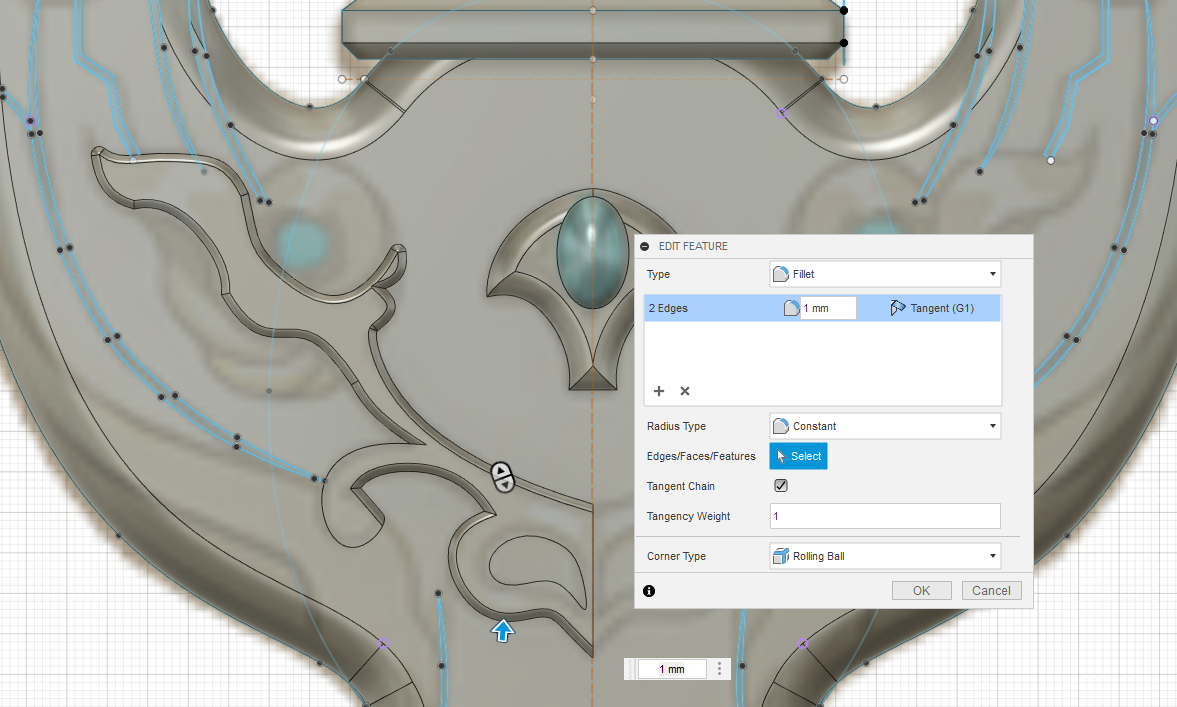
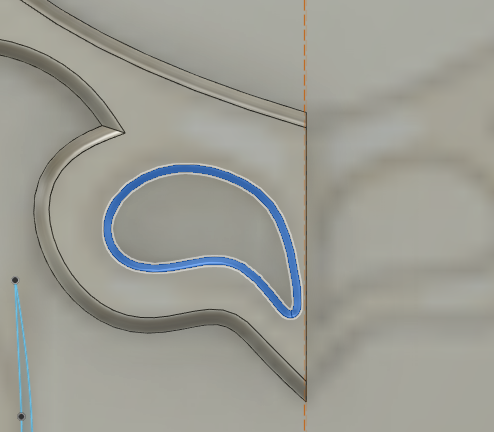
- Create a new plane parallel to the front of the lyre and extrude it out 15mm
- title it plane 2
- Create a sketch of the detail that is shown (the main center piece). Make sure to only trace half of this piece since the other half will be mirrored onto the other side.
- Extrude this piece out 3 mm.
- You will be unable to filet a part of the design so instead create a sketch as shown in image 3. It should have a filet of 1 mm on the corner of the detailing
- Select the part of the sketch that is outside of the filet and use the sweep tool and pull the path arrow until it won't go any further
- Fillet all sections of this piece 1 mm, except for the center circle of the design.
- Fillet the center circle of the design by 0.5 mm.
Part
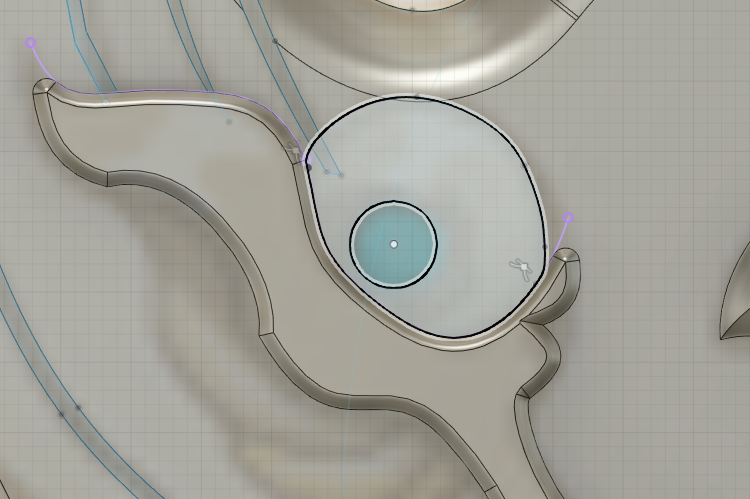
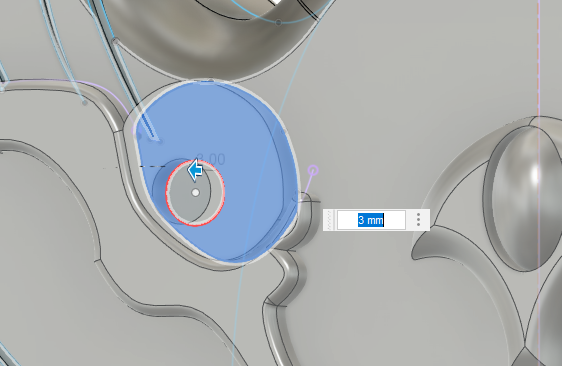
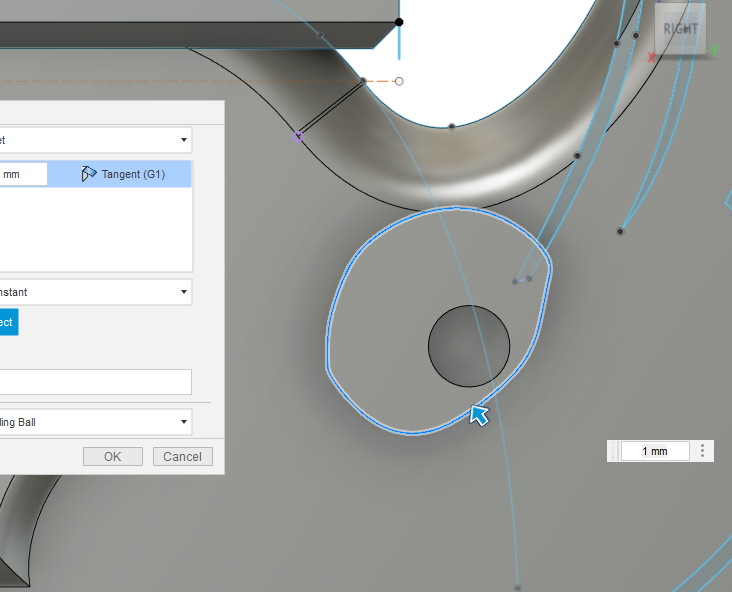
- Create a sketch on plane 2.
- Draw the shape shown above by tracing the canvas.
- Extrude that sketch out 3mm.
- Mirror this feature onto the other side of the lyre.
- Fillet this feature by 1 mm.
Extra Fillet
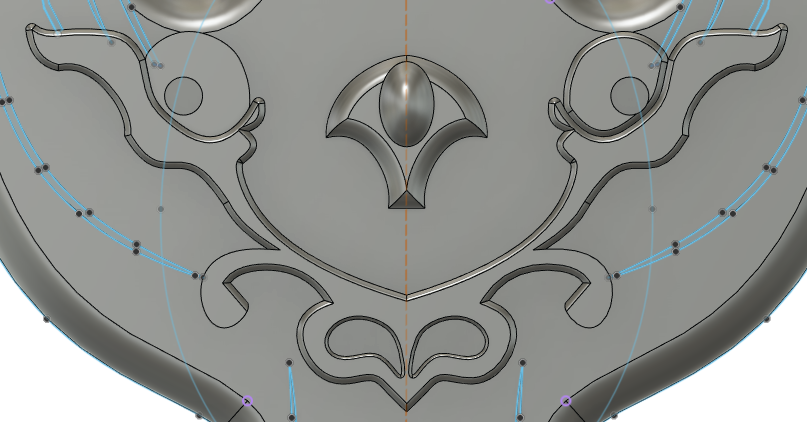
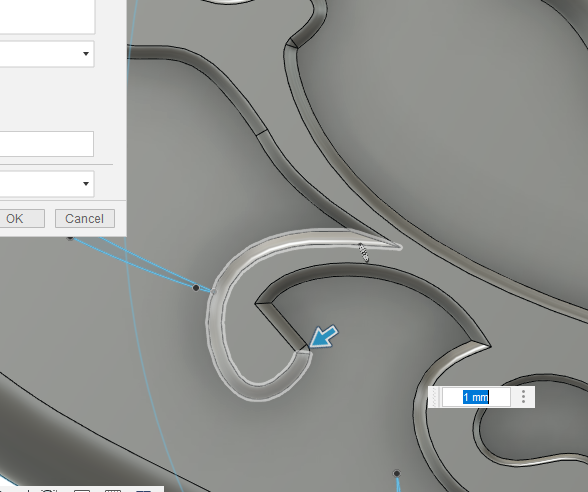
- Mirror the main front feature onto the other side (picture shown).
- Fillet the edge piece of this feature by 1 mm (picture shown).
Gem 2
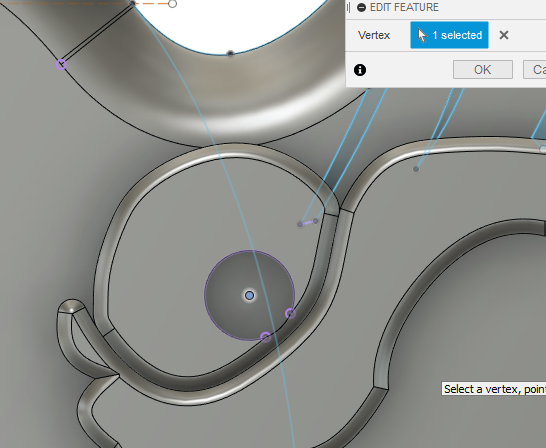
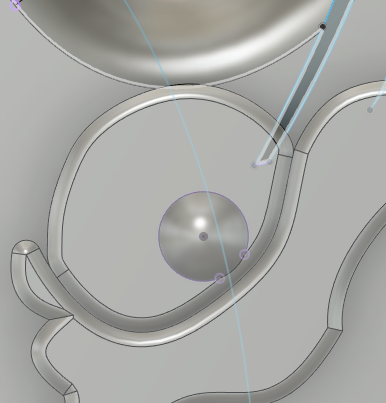
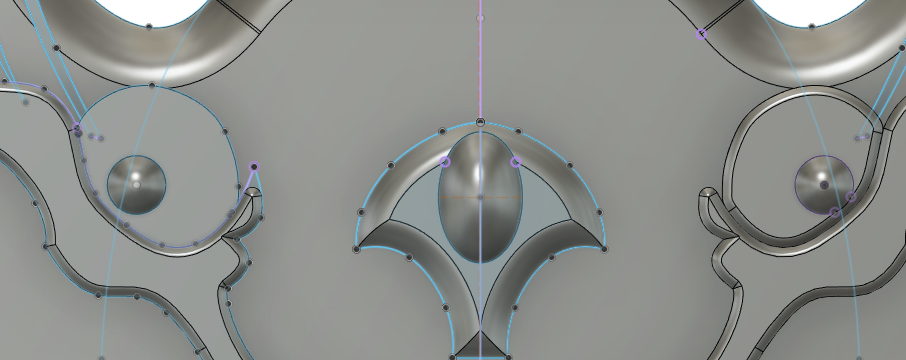
- Create a point in the middle of the circle feature (picture shown).
- Use the sphere feature to make that point into a sphere.
- Mirror that sphere detail onto the other side.
Feathers
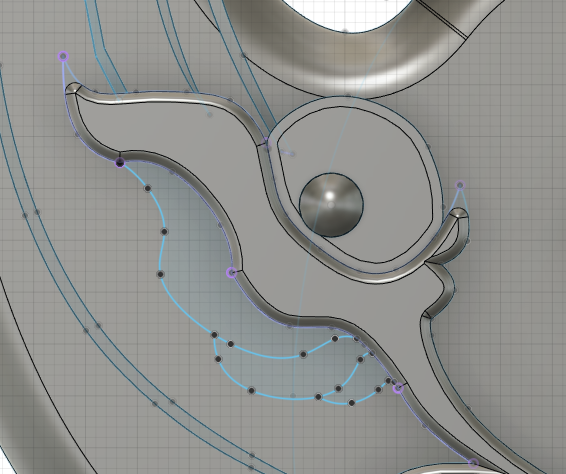
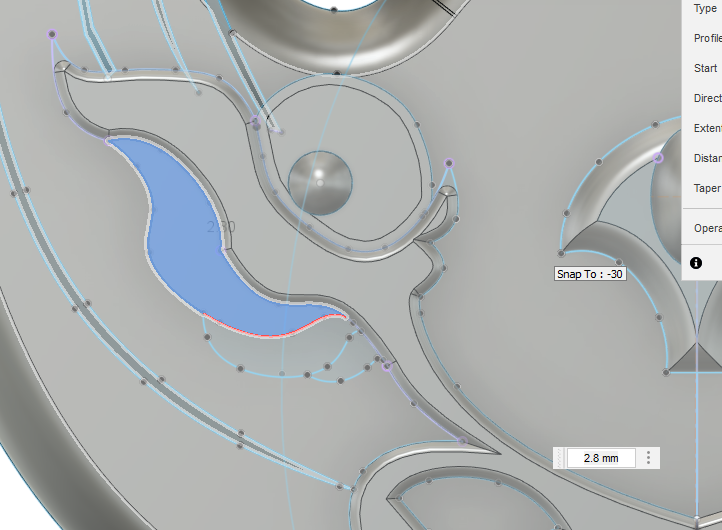
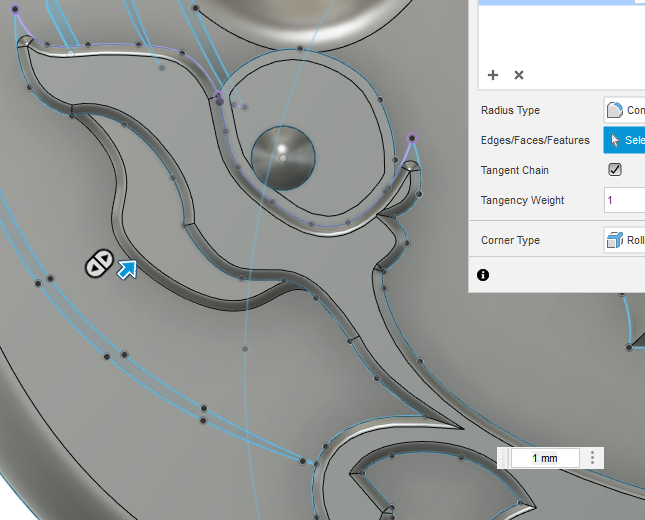
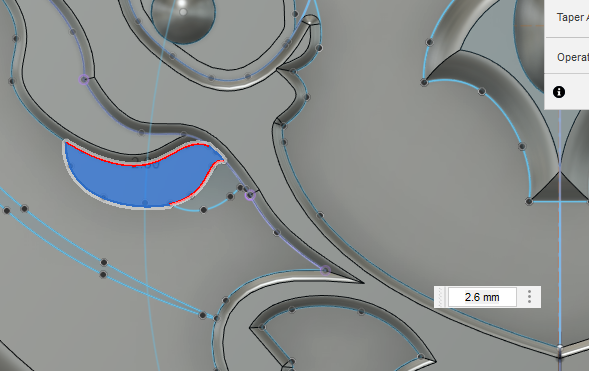
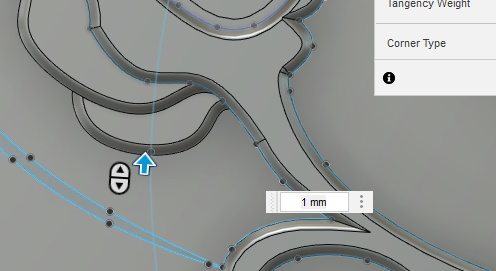
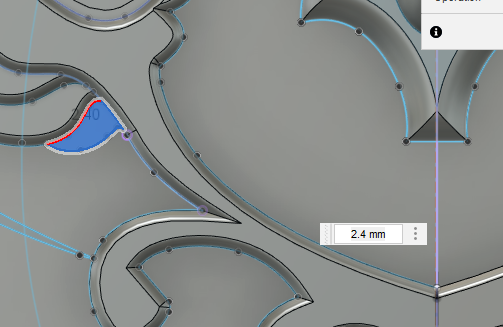
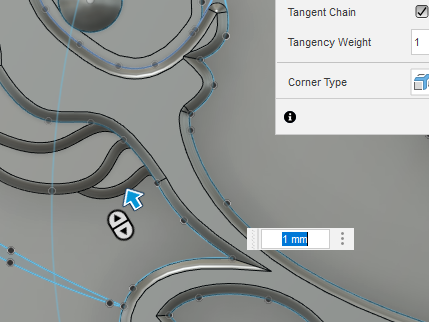
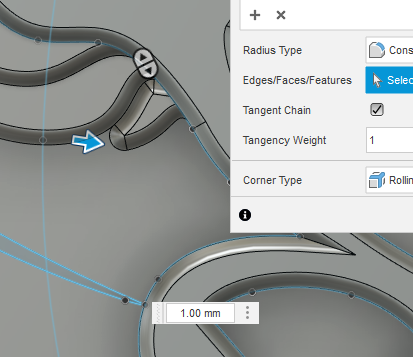
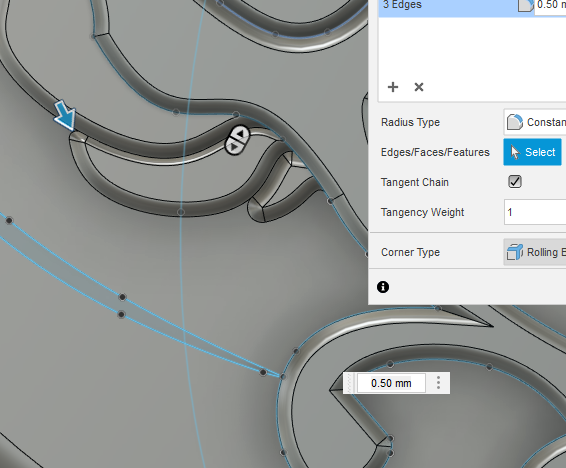
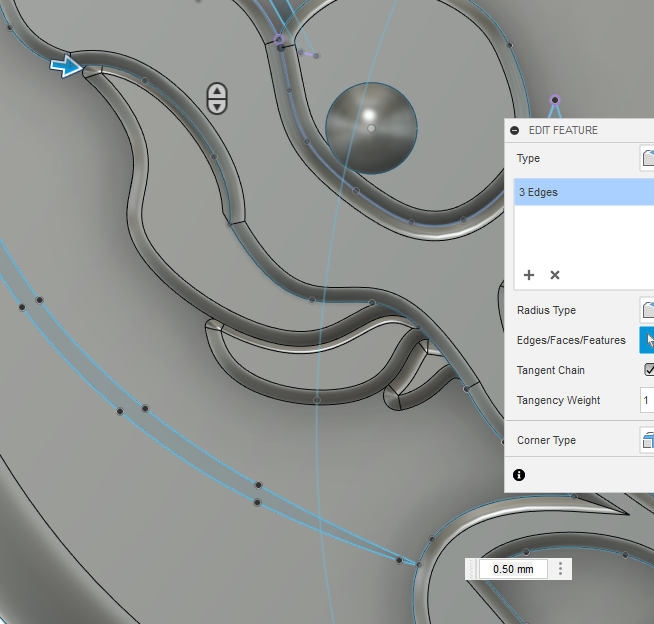
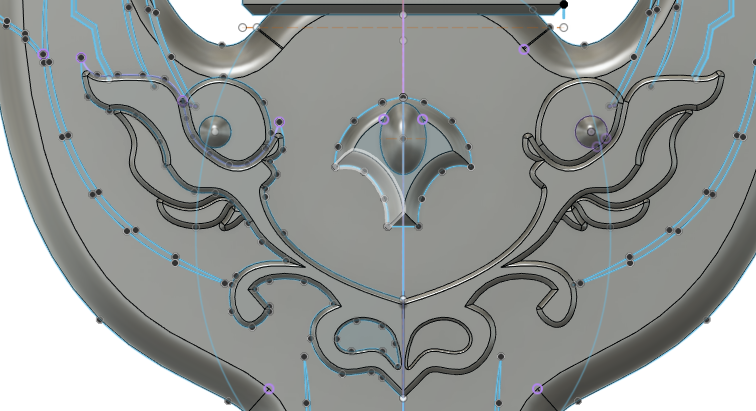
- Create a sketch of the wings under the main feature (picture shown).
- Extrude the first layer by 2.8 mm.
- Fillet that first layer by 1 mm.
- Extrude the second later by 2.6 mm.
- Fillet the second layer by 1 mm.
- Extrude the third layer by 2.4 mm.
- Fillet the third layer by 1 mm.
- Fillet the inside of the third layer by 1 mm (picture shown).
- Fillet the inside of the second layer by 0.5 mm.
- Fillet the inside of the first layer by 0.5 mm.
- Mirror everything in this step onto the other side of the lyre (final picture shown).
Top
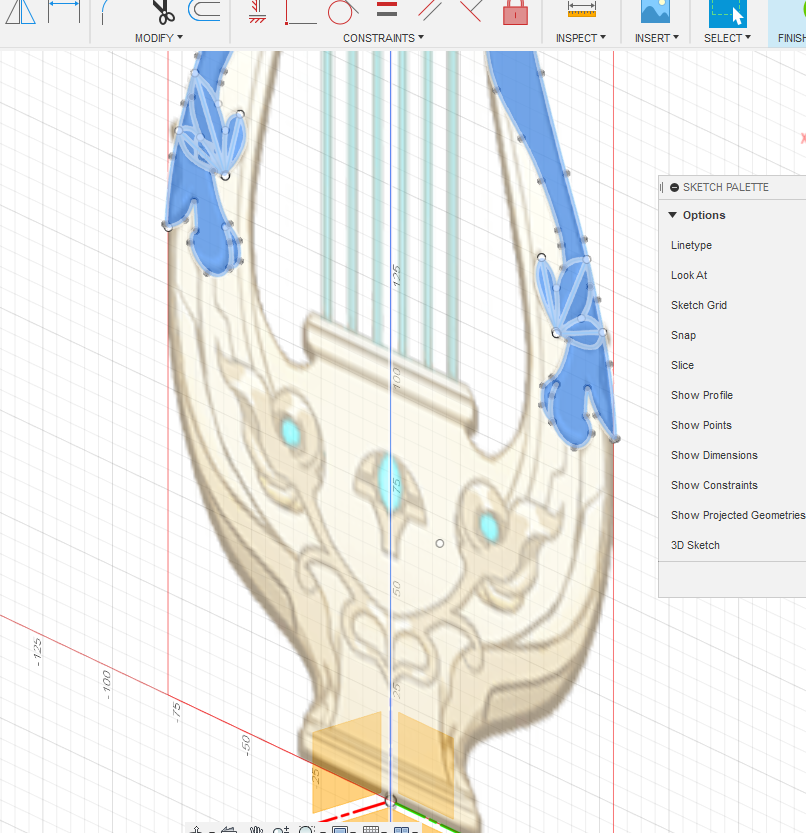
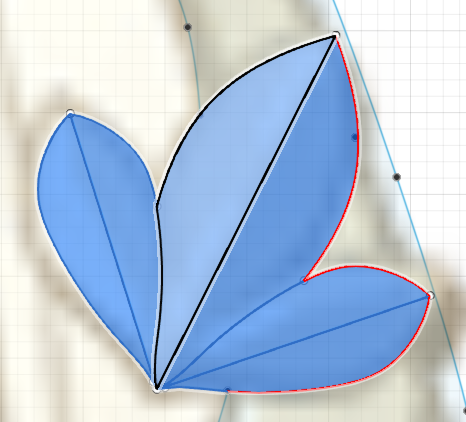
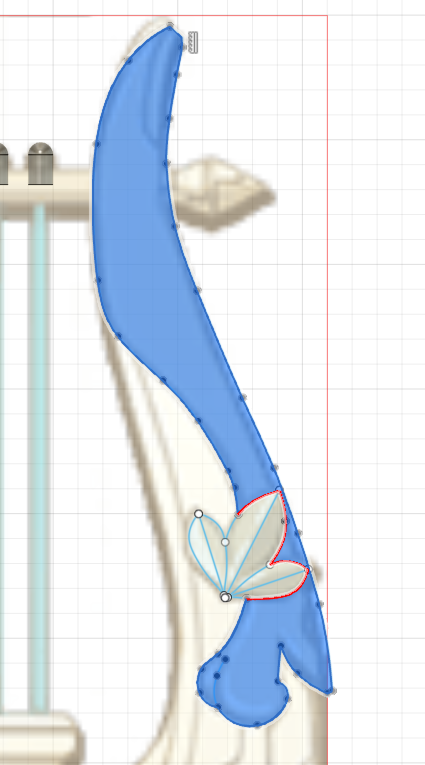
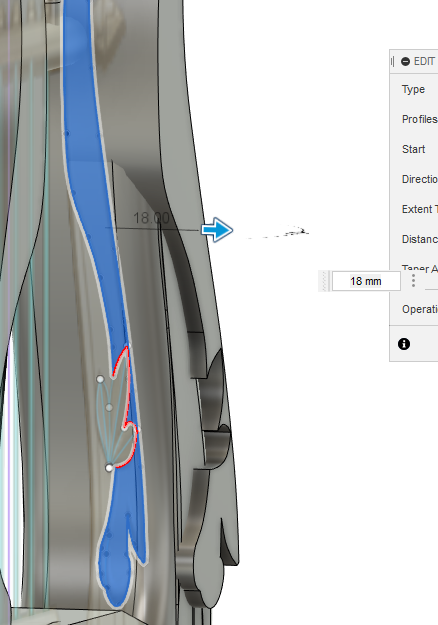
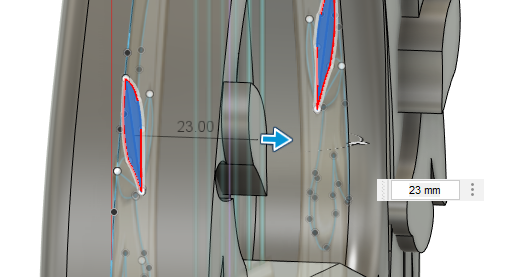

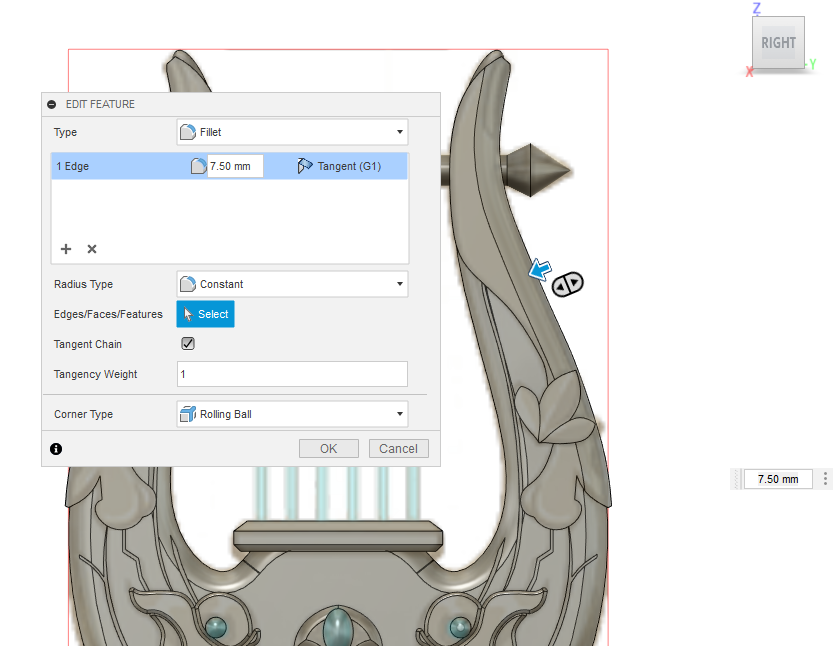
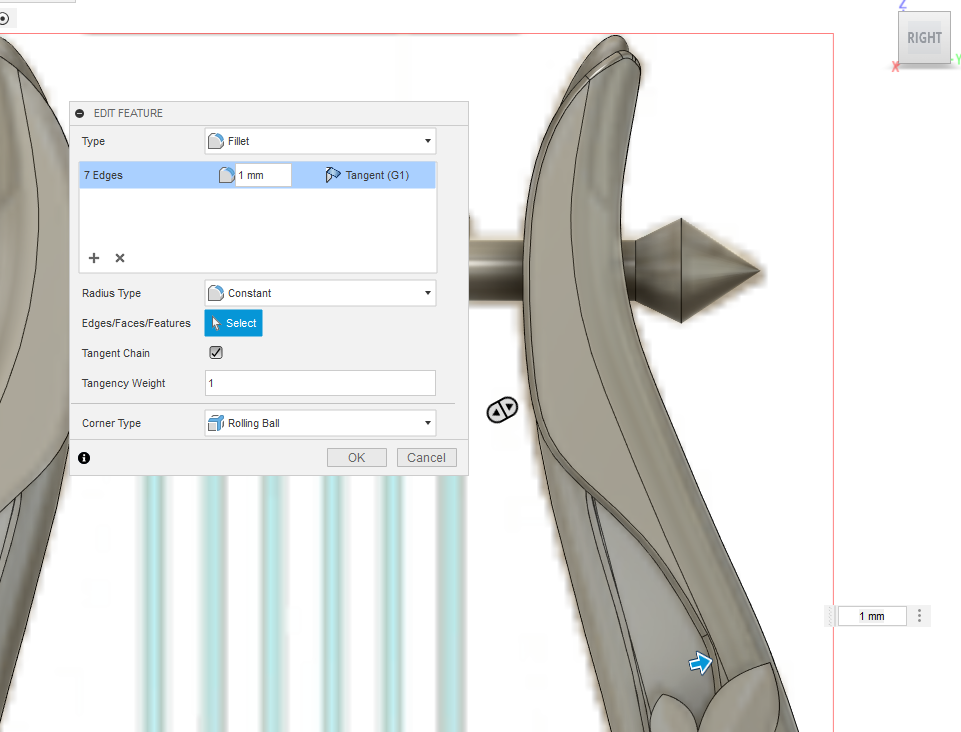
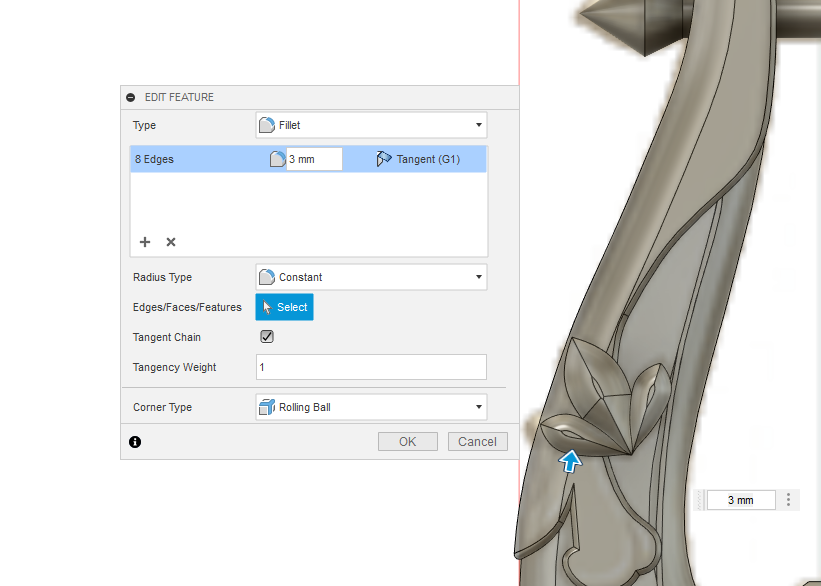
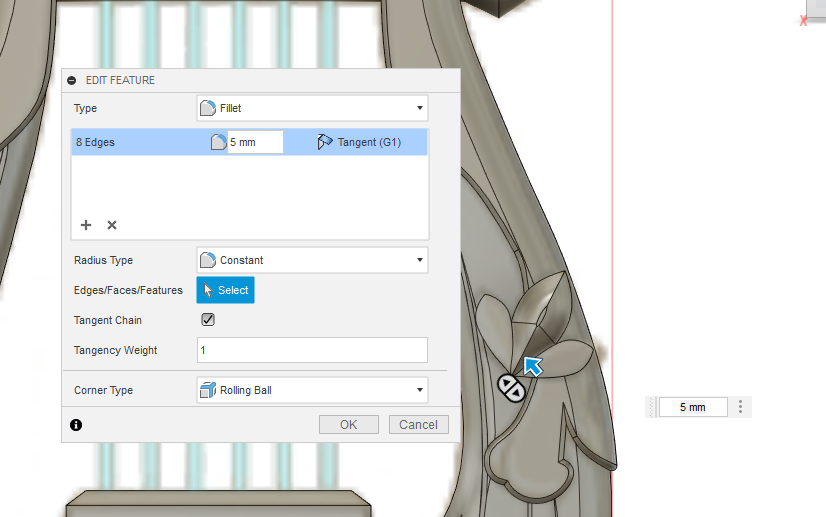
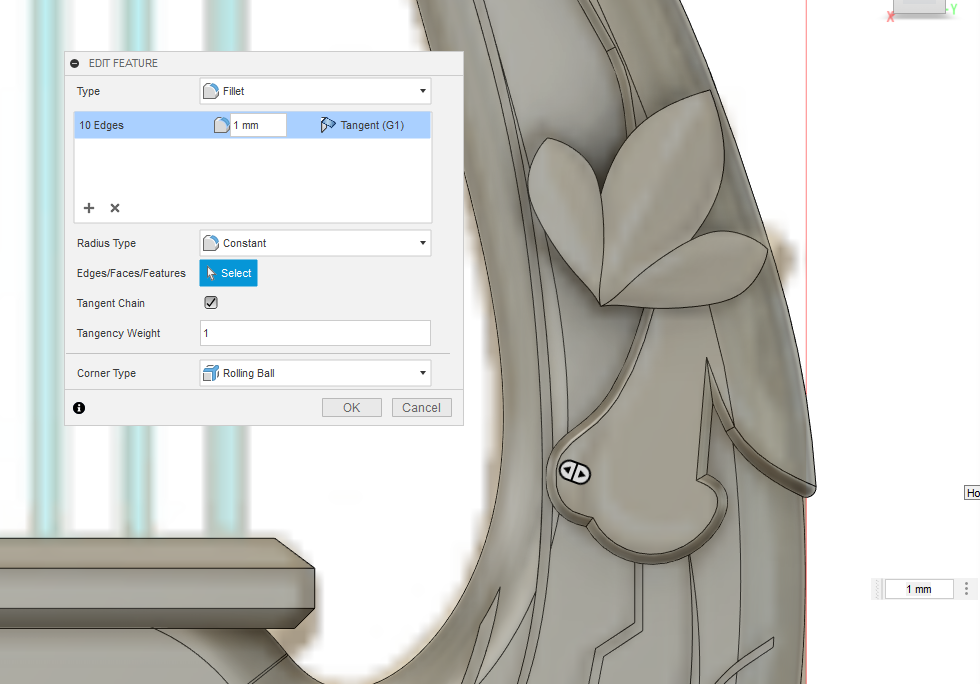
- Create a sketch at the same plane as the canvas for the flowers (picture shown).
- Create a sketch of the flower piece that is at the side of the lyre by tracing the canvas. There are 3 petals. For each petal, sketch half of it and mirror the other half so it is symmetrical (picture shown).
- Create a sketch of the piece that layers the side part of the lyre by tracing the canvas (picture shown).
- Mirror that completed sketch onto the other side of the lyre.
- Extrude the piece that layers the side out 18 mm.
- Extrude the middle petal of each flower out 23 mm.
- Extrude each of the side petals out by 21 mm.
- Fillet the outside of each piece that layers the side by 7.50 mm. (Make sure to keep doing a fillet until the top is rounded or else there will be errors, this depends on your initial sketch).
- Fillet the inside of each piece that layers the side by 1 mm.
- Fillet the bottom part of the piece that layers the side by 1 mm.
- Fillet the middle petal of each flower by 5 mm.
- Fillet each of the side petals by 3 mm.
Bottom
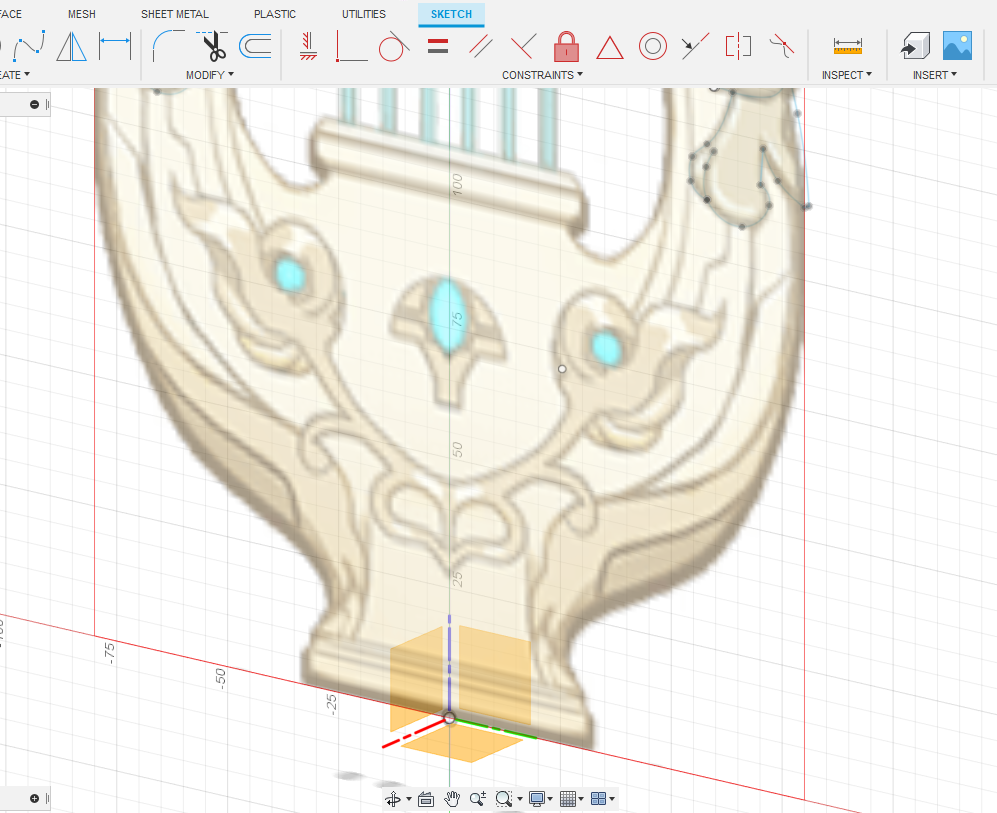
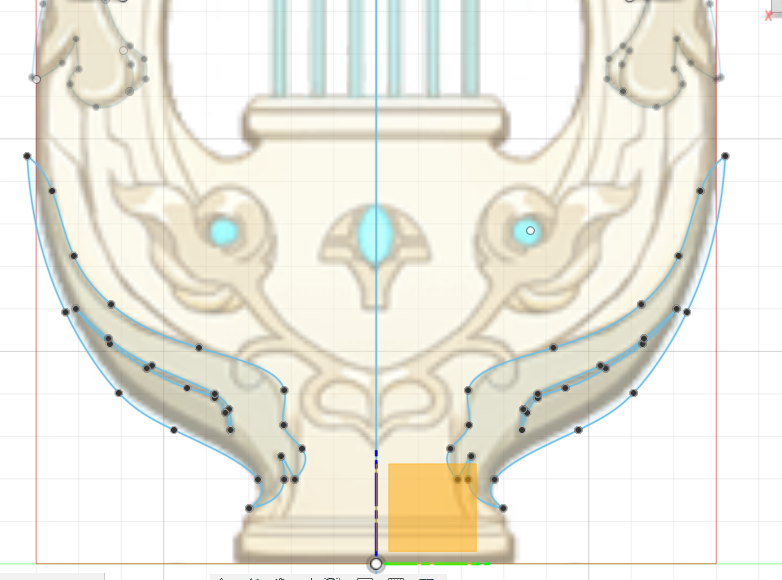
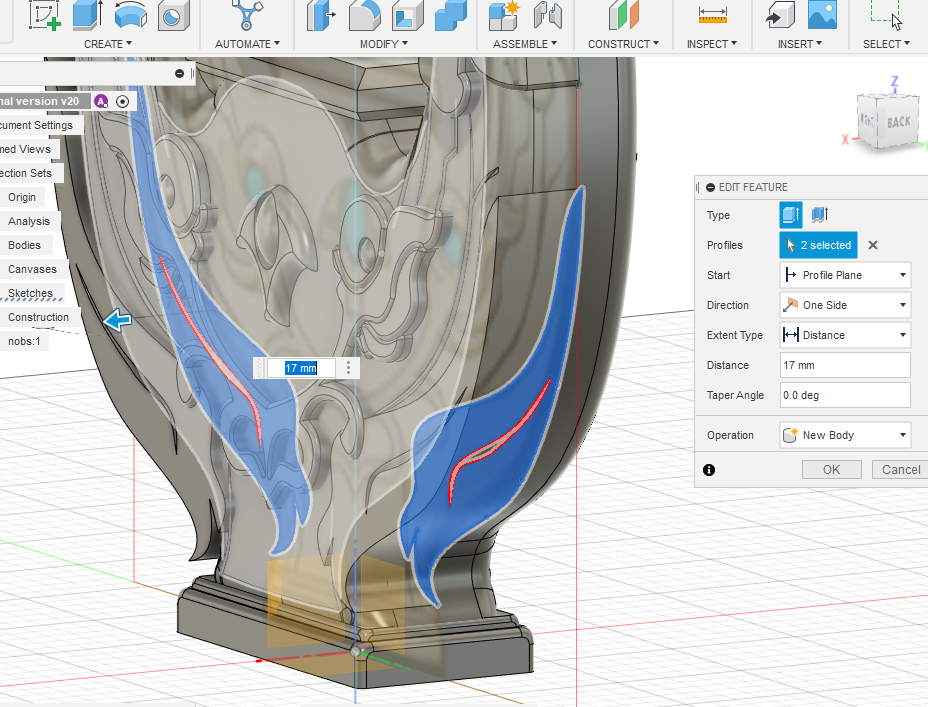
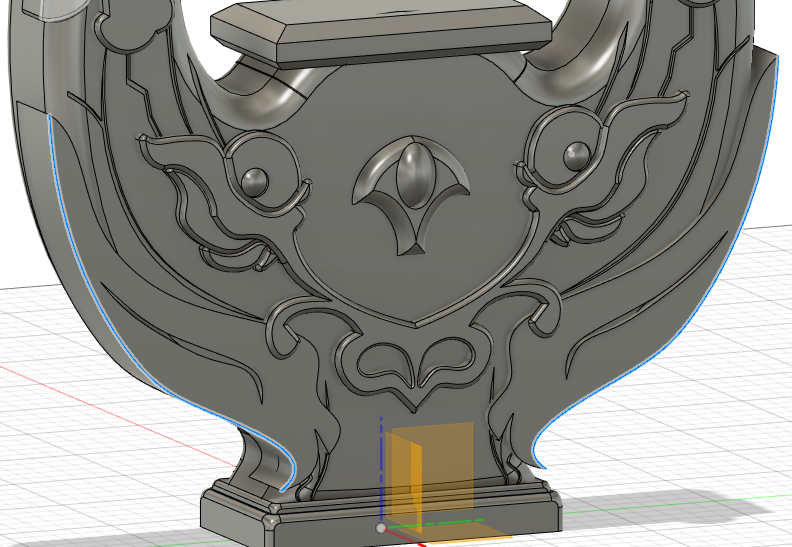
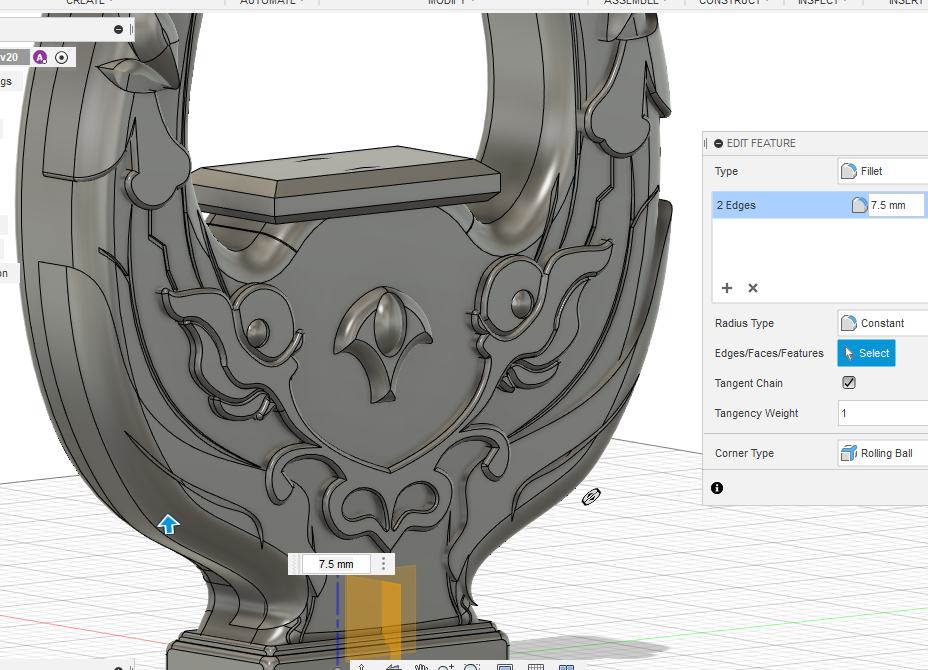
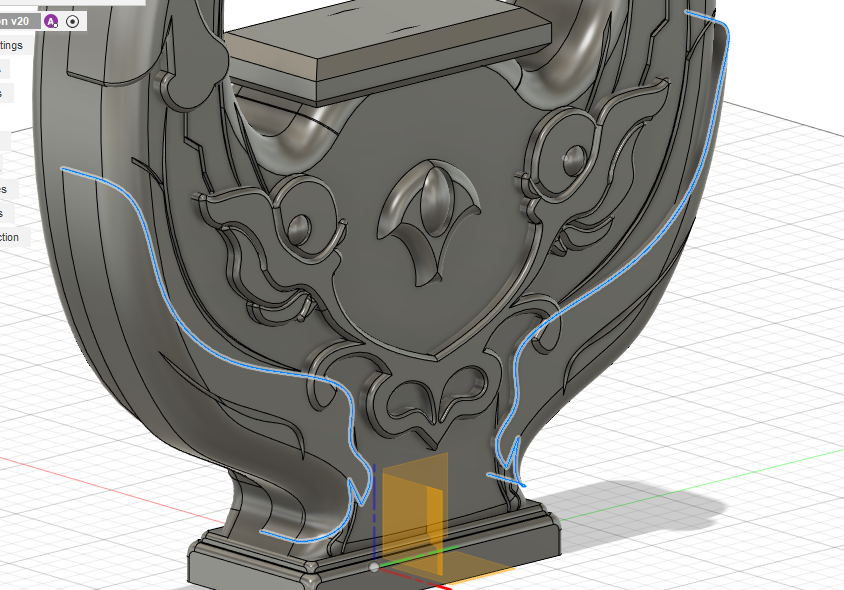
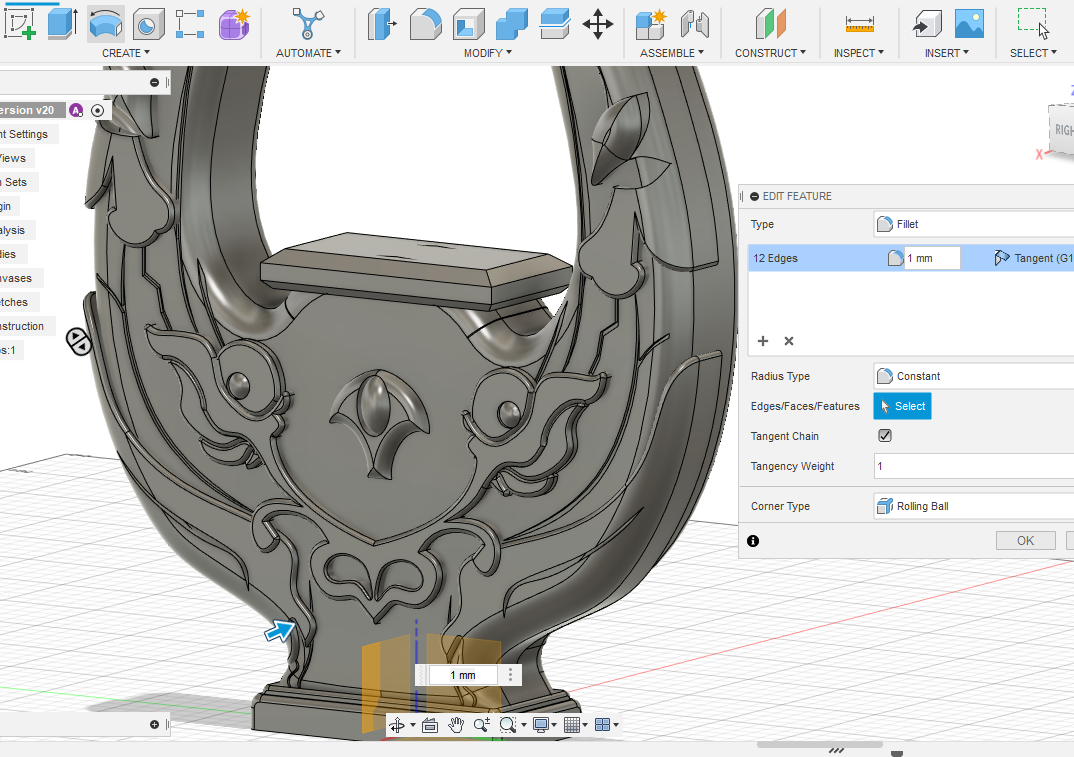
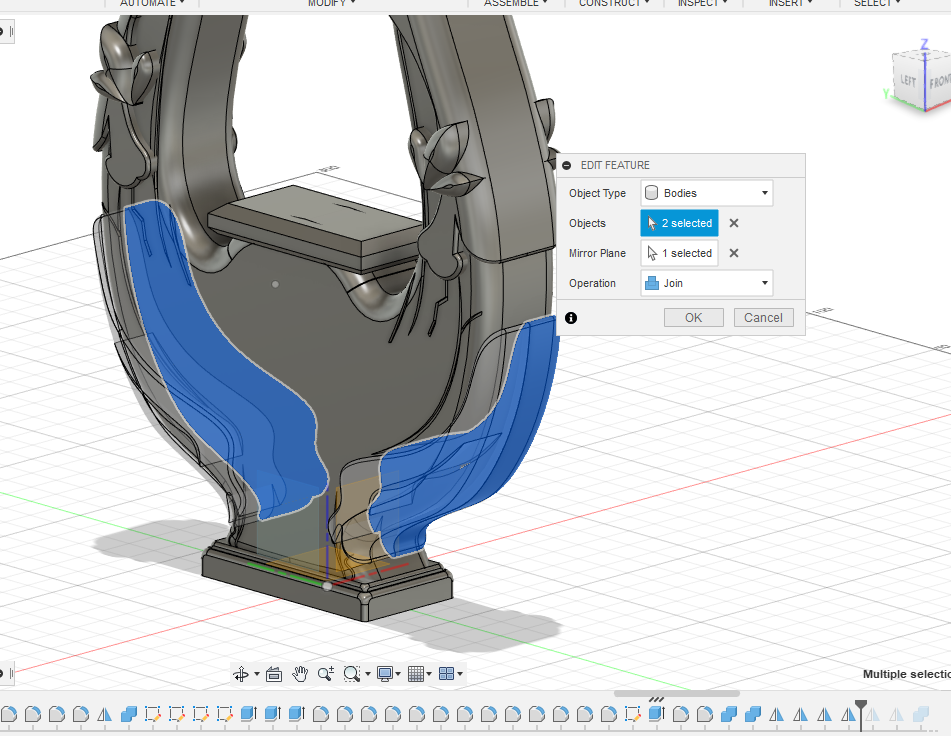
- Create sketch on middle plane
- Trace the bottom details as shown in image 2
- Extrude sketch out 17 mm
- Select the outside edges as shown
- Fillet them by 7.5 mm (if 7.5 mm doesn't work, adjust it for the biggest fillet it will allow)
- Select the inner edges as shown
- Fillet them by 1 mm
- Mirror these two bodies onto the other side of the lyre
Combining Bodies
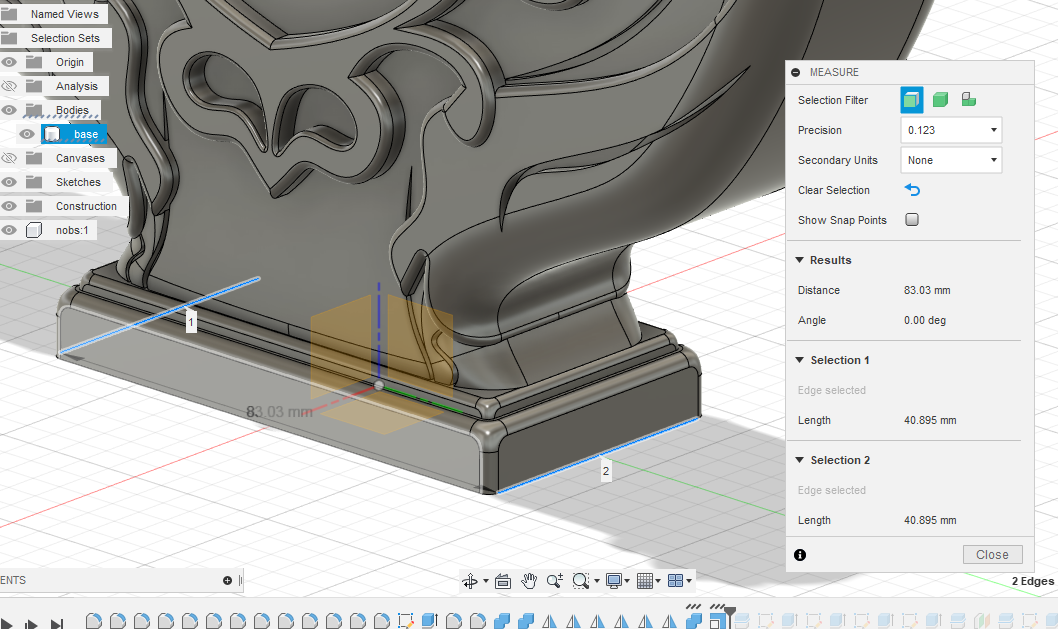
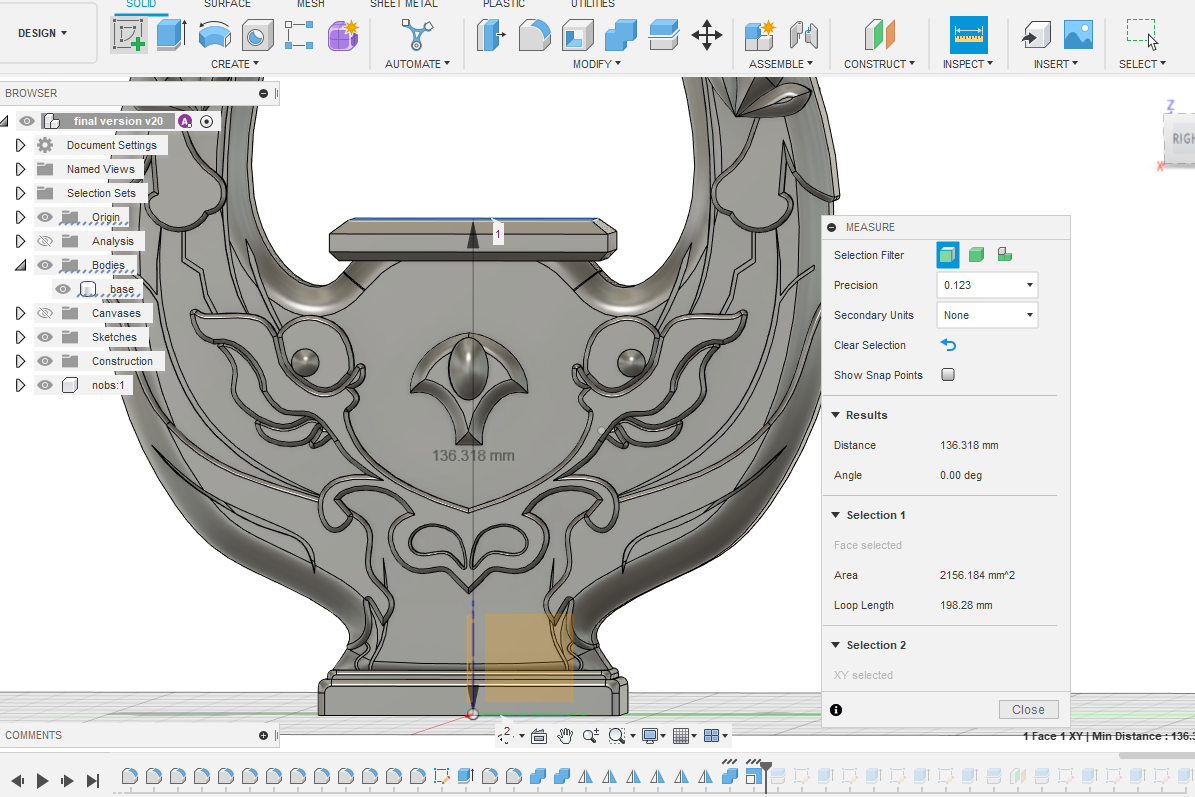
- Combine all bodies
- Scale the lyre
- A few references have been provided for the size the lyre should be
- The base should be about 83.03 mm wide
- The lyre should be about 136.318 mm from the base of the lyre to the top of the middle part
- The entire lyre should be around 360 mm tall, give or take
Inside the Lyre
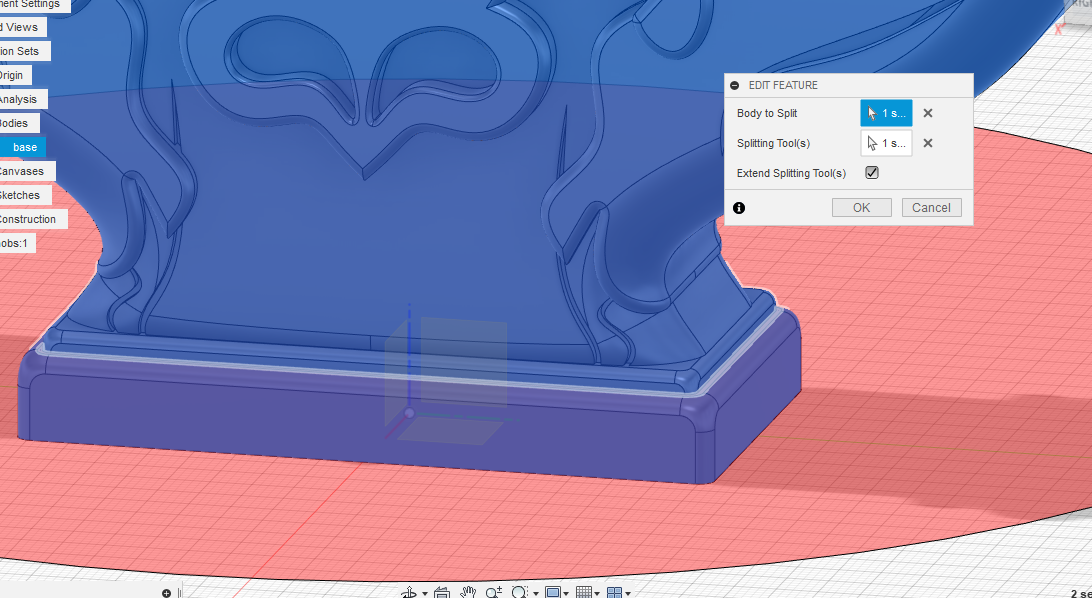
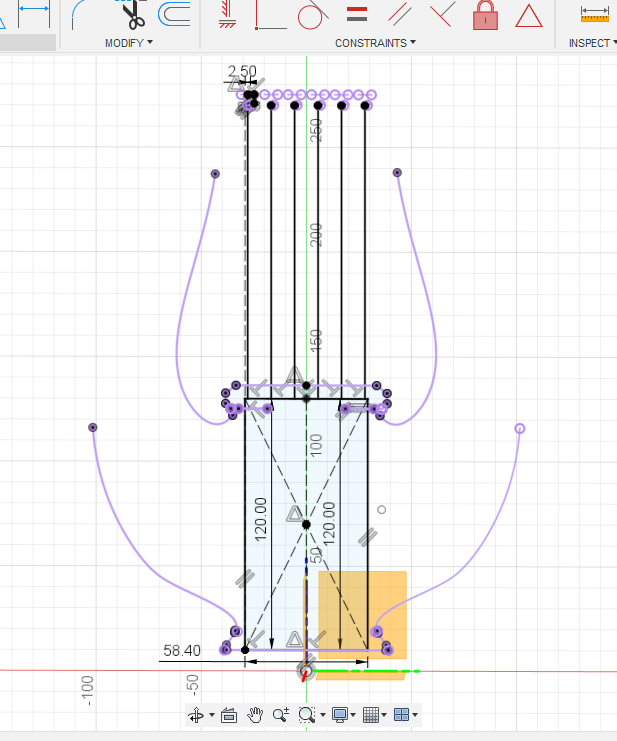
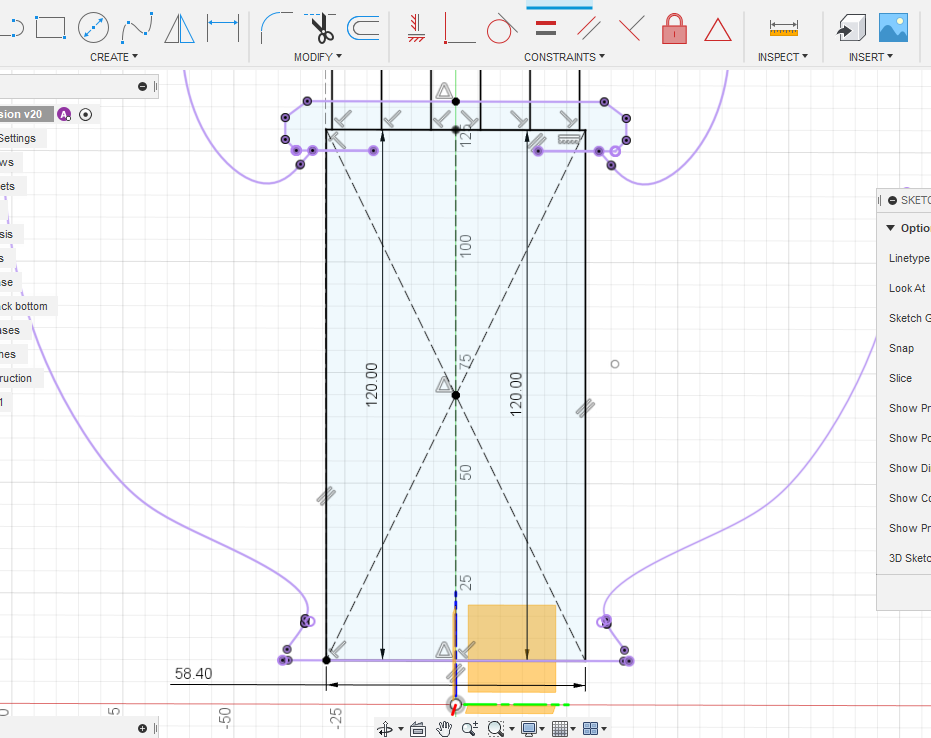
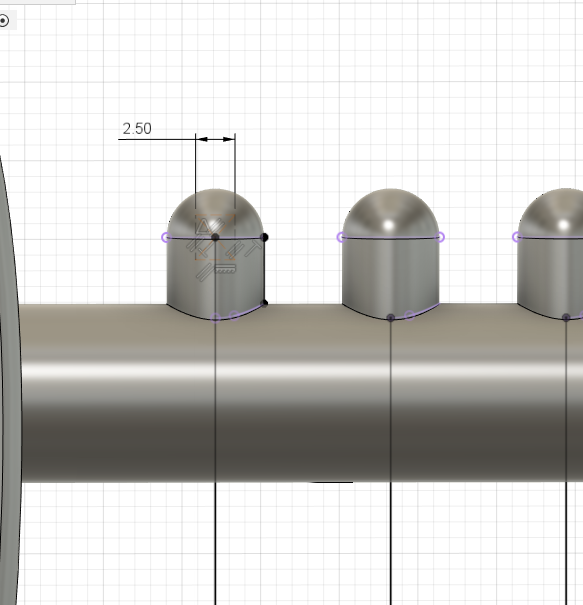
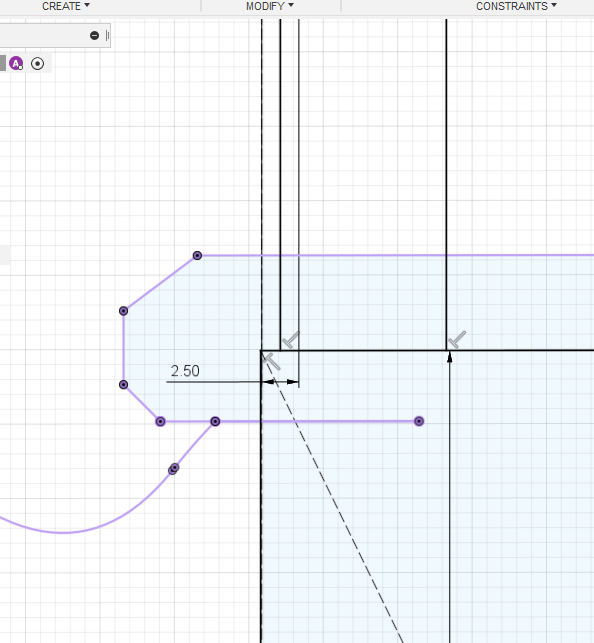
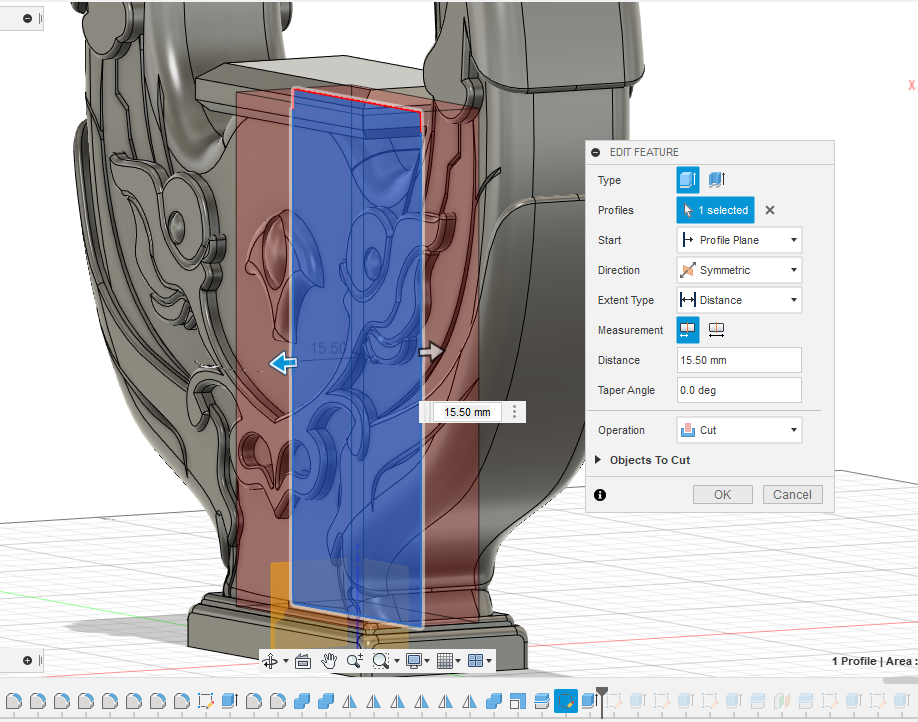
- Split the lyre at this spot on the base
- Make a sketch on the middle plane with the dimensions shown. There should be a line going down the center of each nob
- Finish the sketch
- Do a symmetric extrusion of 15 mm
Base
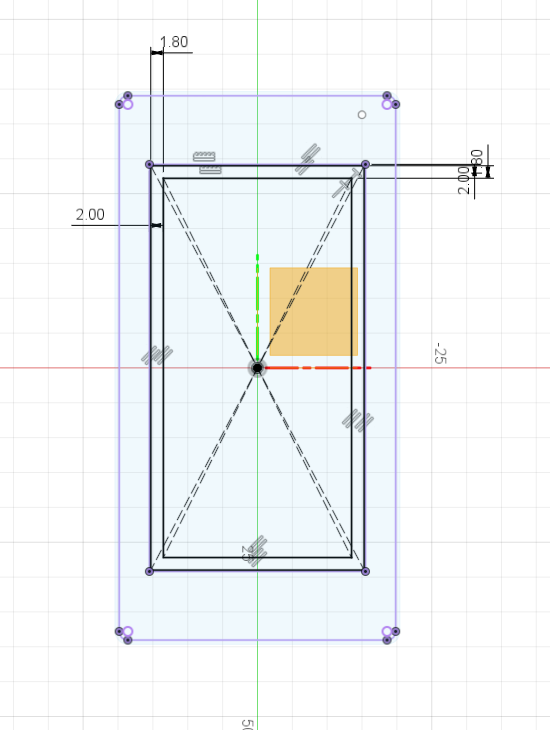
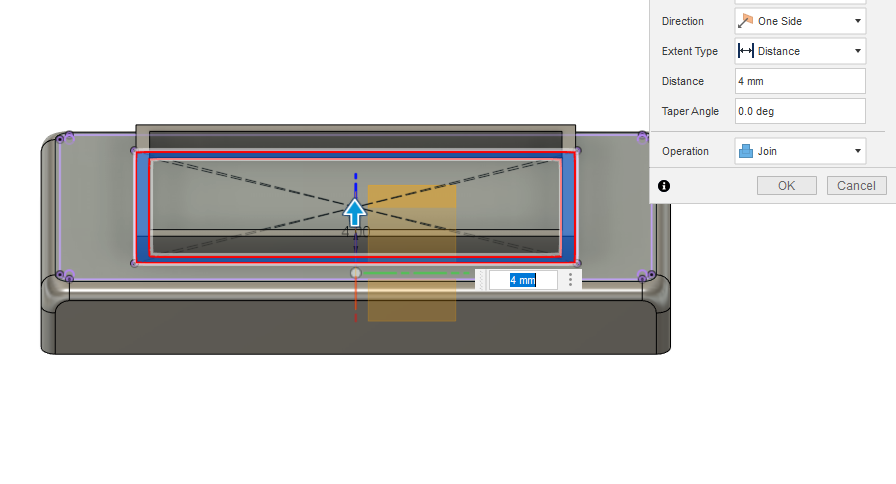
- Create a projection of the two selected edges.
- Make a rectangle within the bounds of the projection. The borders should be 0.2 mm inside of the inner walls of the projection.
- Make a rectangle inside of the one you just made. The dimensions should be at least 54.4 mm by 27 mm.
- Extrude that inner wall by 4 mm.
Top Bar
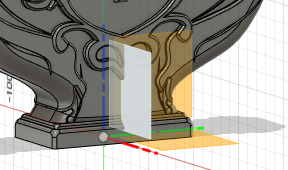
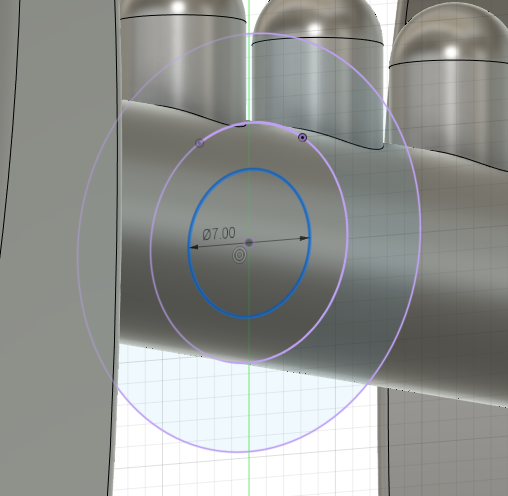
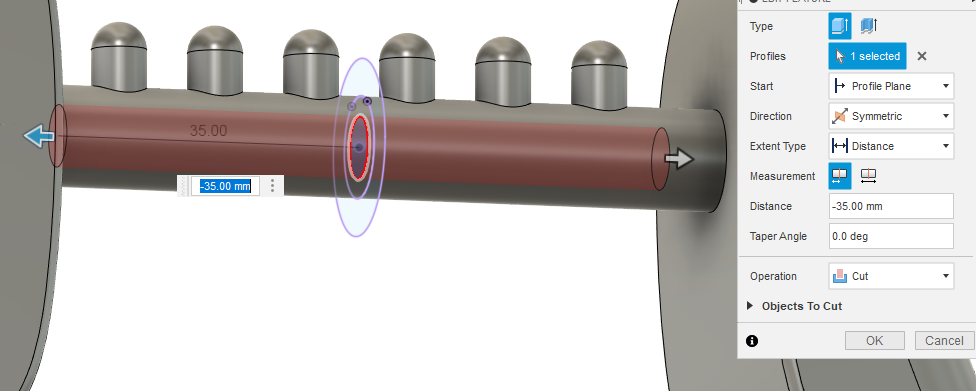
- Create a sketch on the plane that is shown (it cuts the lyre vertically down the middle).
- Create a projection of the bar.
- Create a circle with the same center point and a diameter of 7 mm.
- Create a symmetric extrusion that is a 35 mm cut.
Holes
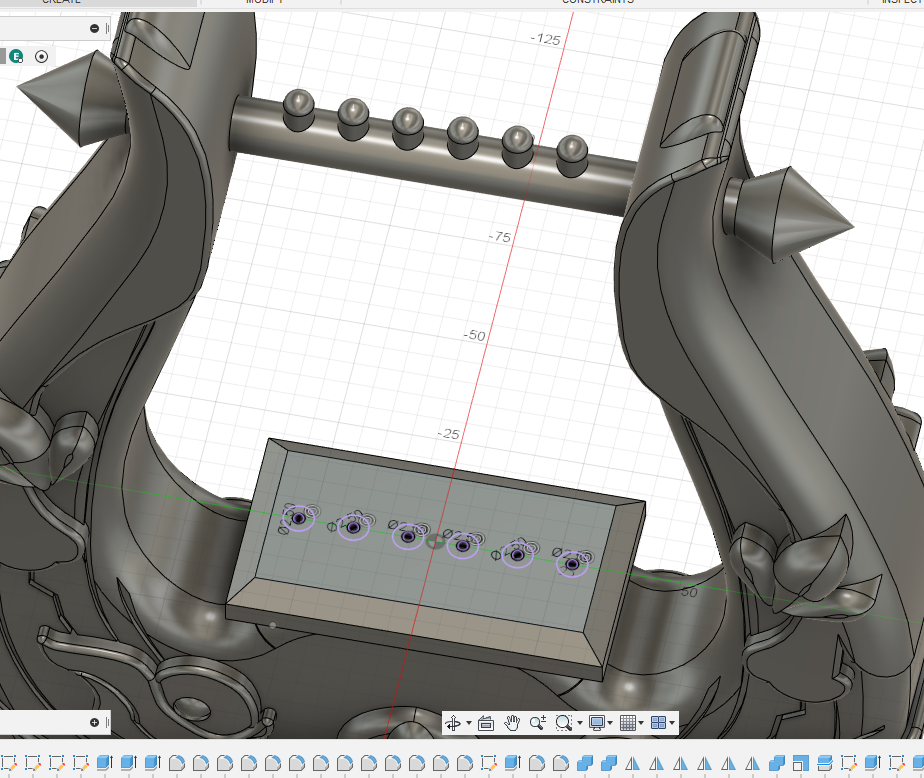
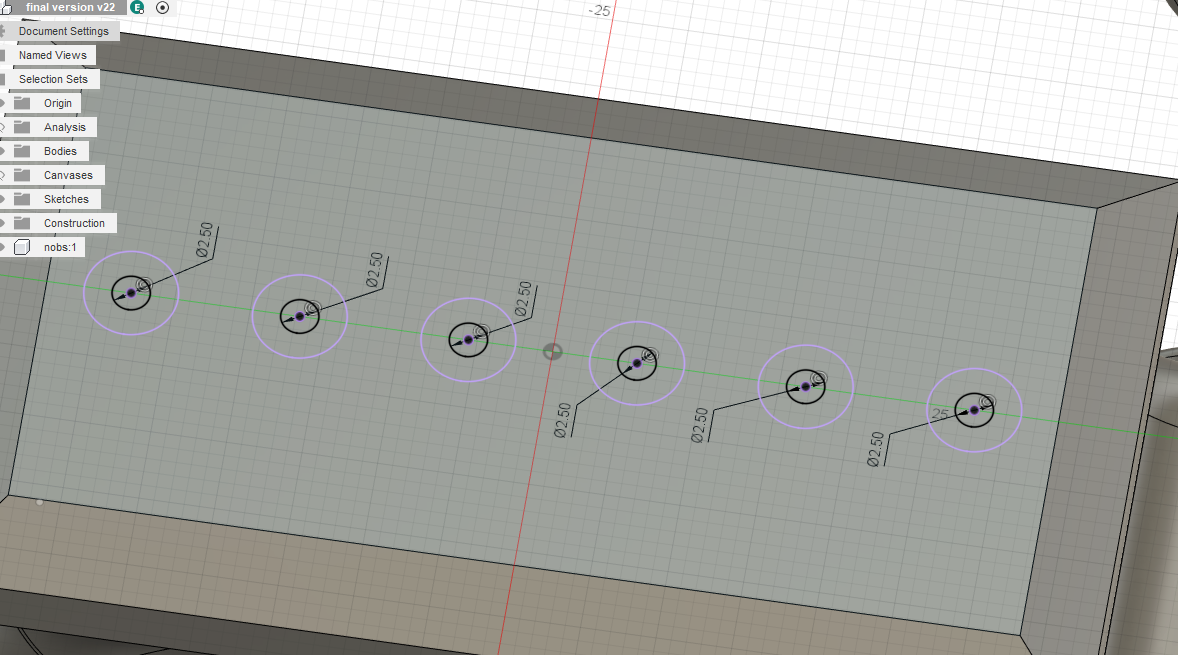
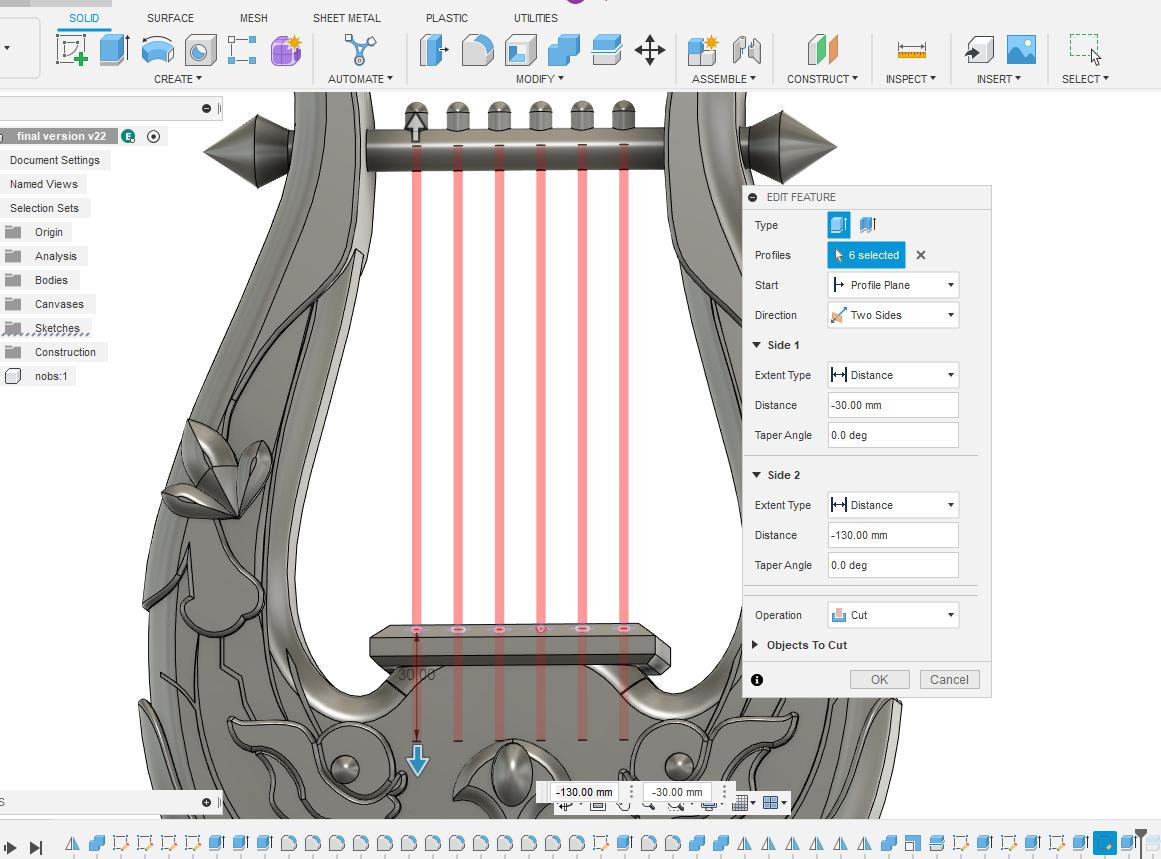
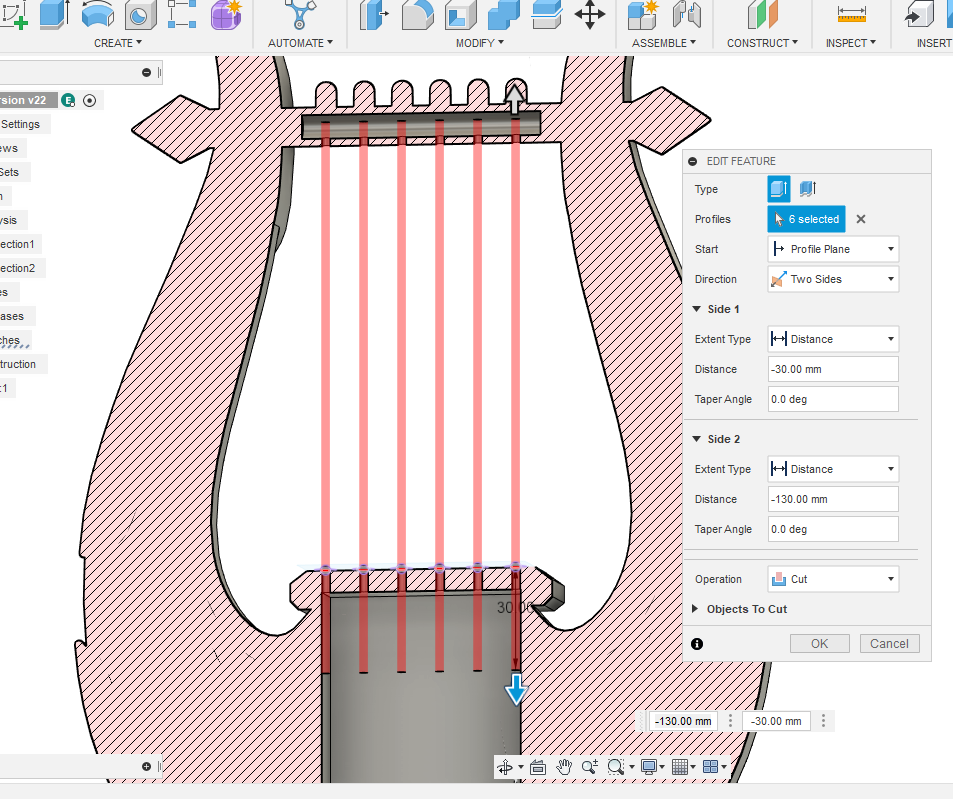
- Create a sketch on the place shown in the first image
- Project the outline of the nobs onto the sketch
- Within those circles make circles of 2.5 mm starting at the center point of the bigger circles
- Finish the sketch
- Use the smaller circles and make a cut that goes through the bottom chamber and the top section.
Split the Body
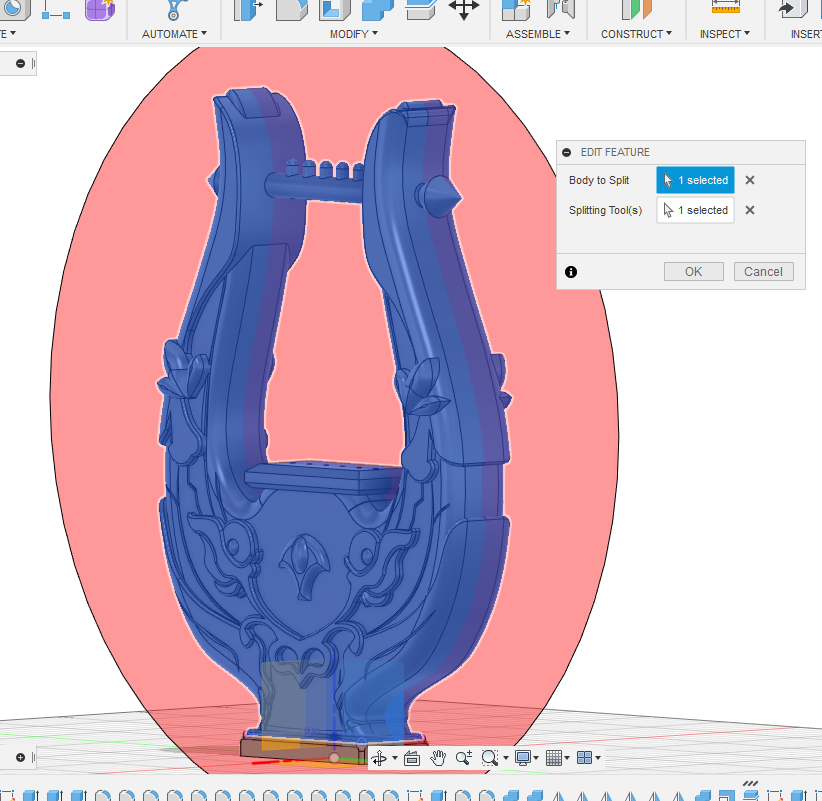
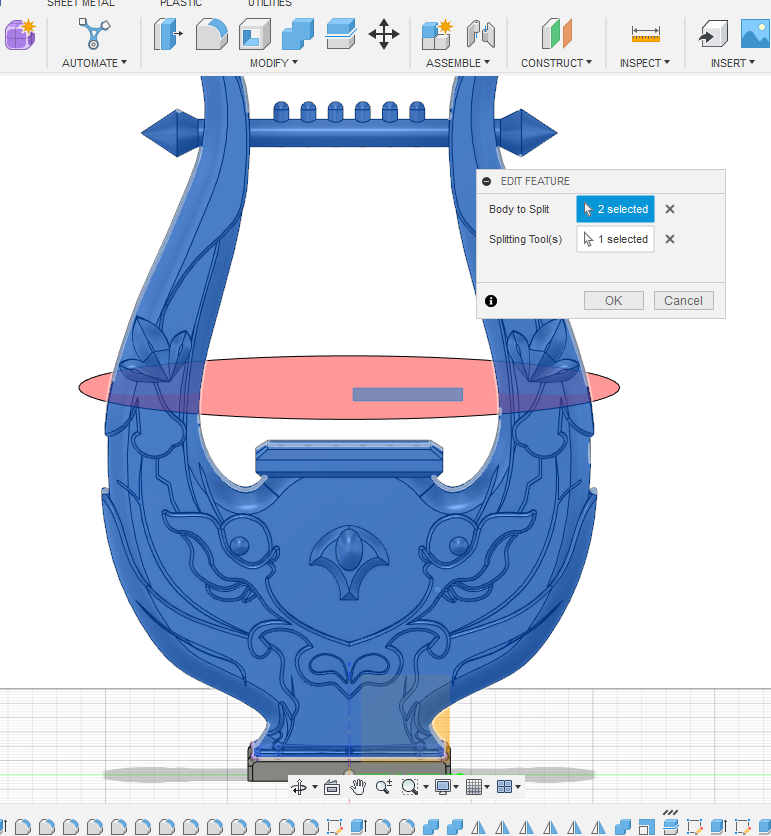
- Make a split through the midplane of the lyre
- Create a construction plane and raise it to around the middle of the lyre
- Use the plane to split the lyre into a top and bottom half
Connections
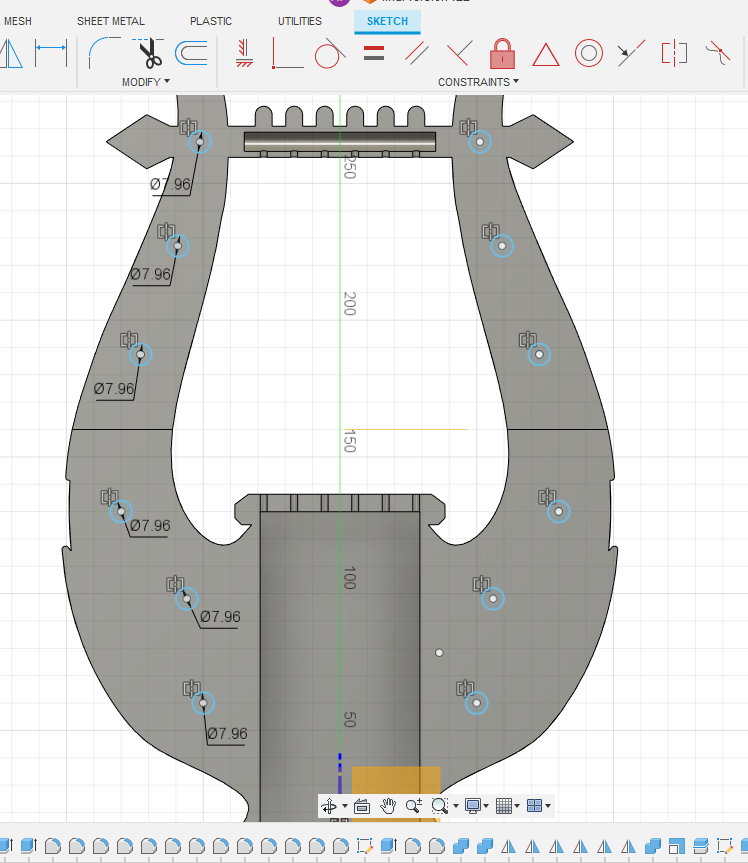
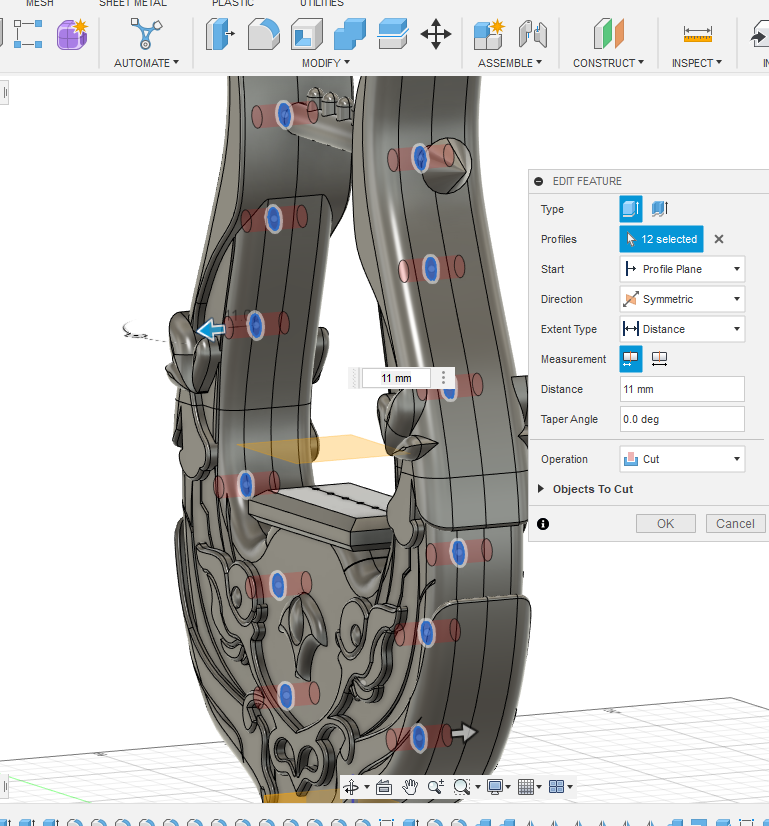
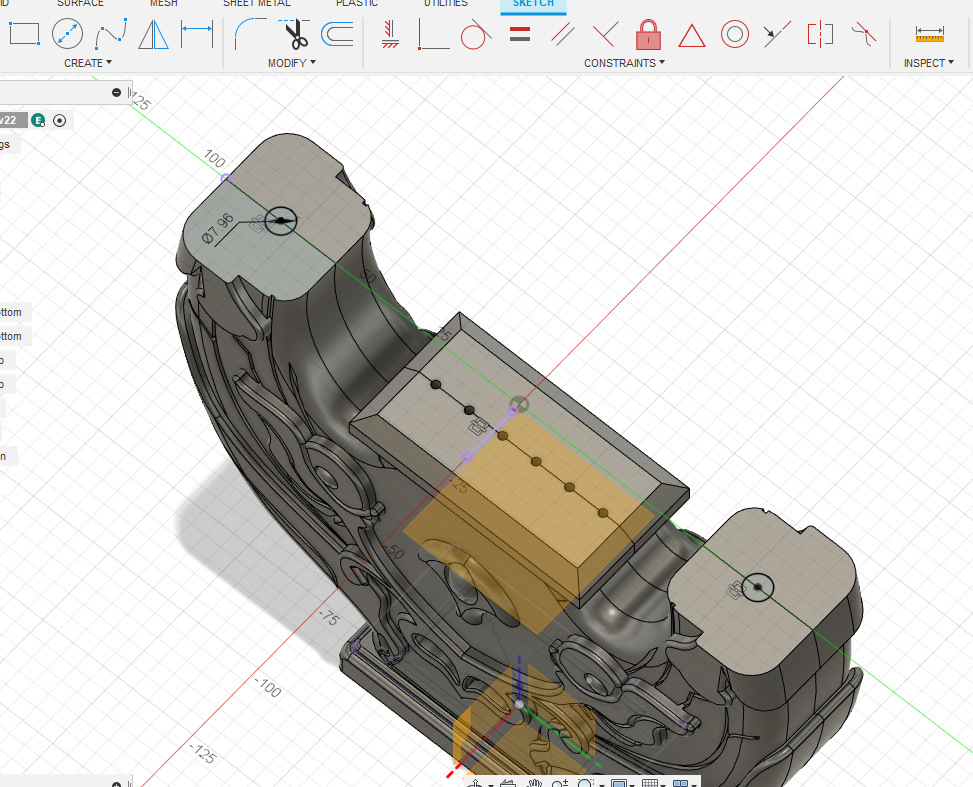
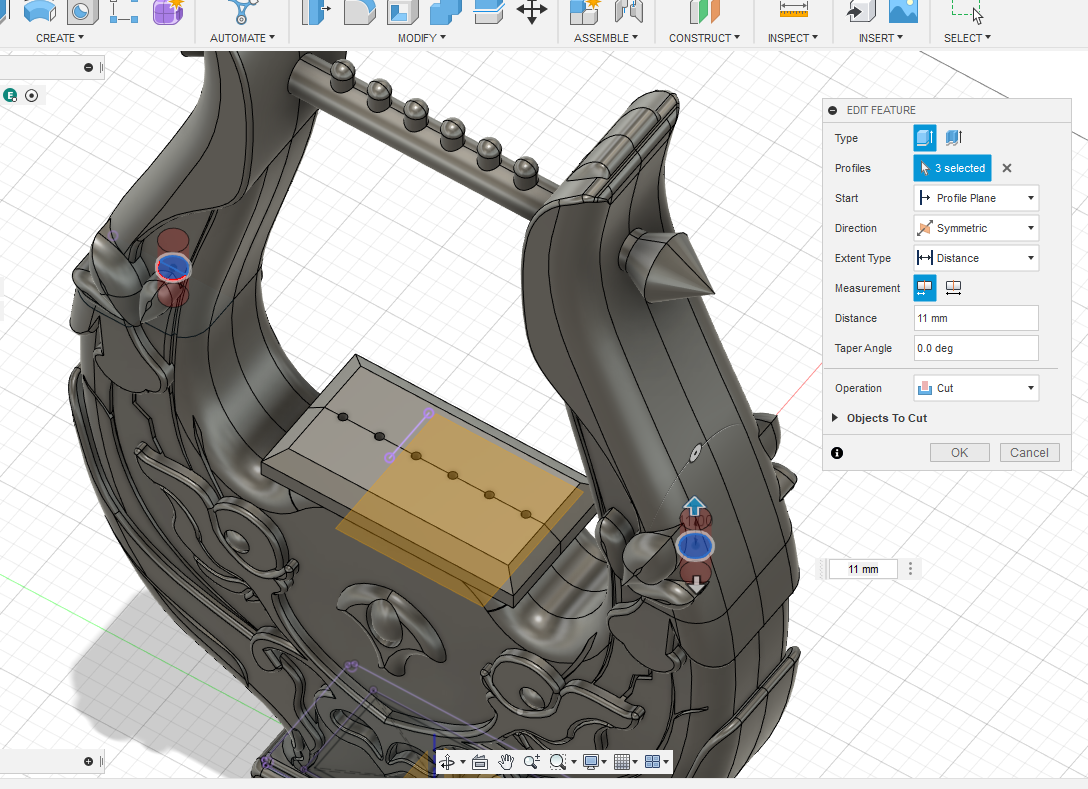
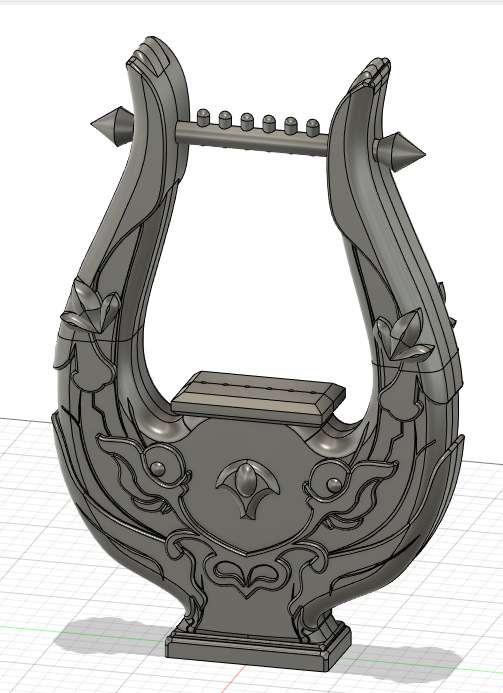
- Measure the diameter of your dowel, we recommend one that is decently sturdy, ours was about 7.7 mm in diameter
- Create a sketch through the middle of the lyre
- Make circles as shown and dimension them to have a diameter 0.2 mm bigger than the diameter of your dowel
- Use the sketch to make a symmetric cut of about 11mm
- Create another sketch on the two bottom half
- Make two more circles and extrude those 11mm
Printing the Lyre
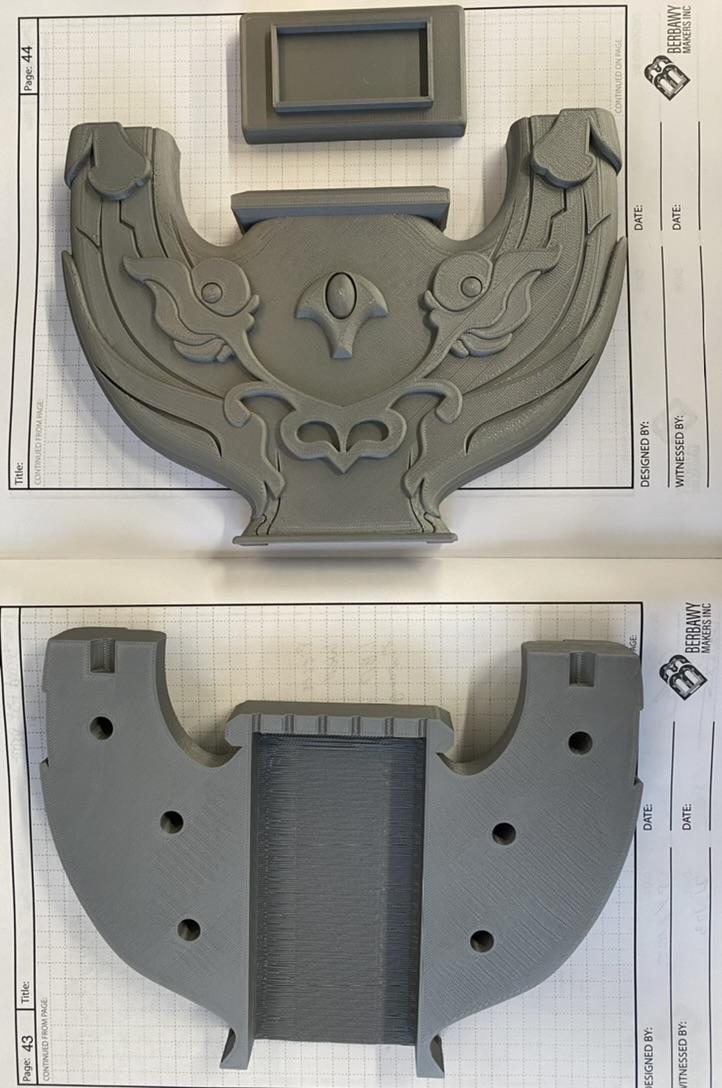
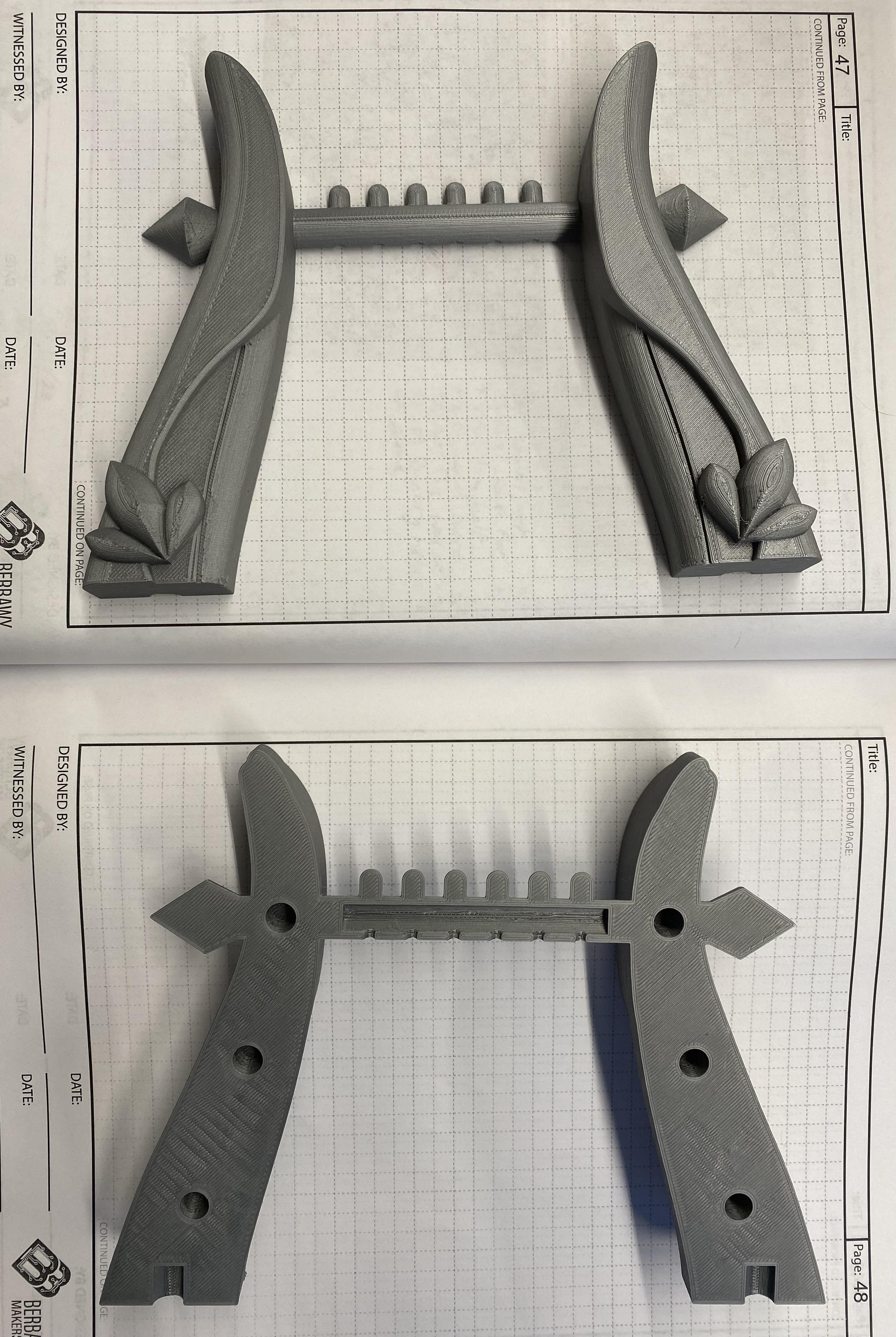
We used Prusa MK3S+ printers to print our lyre, and a Prusament Galaxy Silver PLA filament. Our lyre was printed in a total of 5 parts, two front pieces, two back pieces, and the bottom piece. Theoretically, if you have a big enough printer, the lyre could be printed in only 3 parts, a front, a back, and the bottom piece. Anything less than that would not work, though, as you need to be able to string the lights through the top before closing the lyre.
Start Assembly
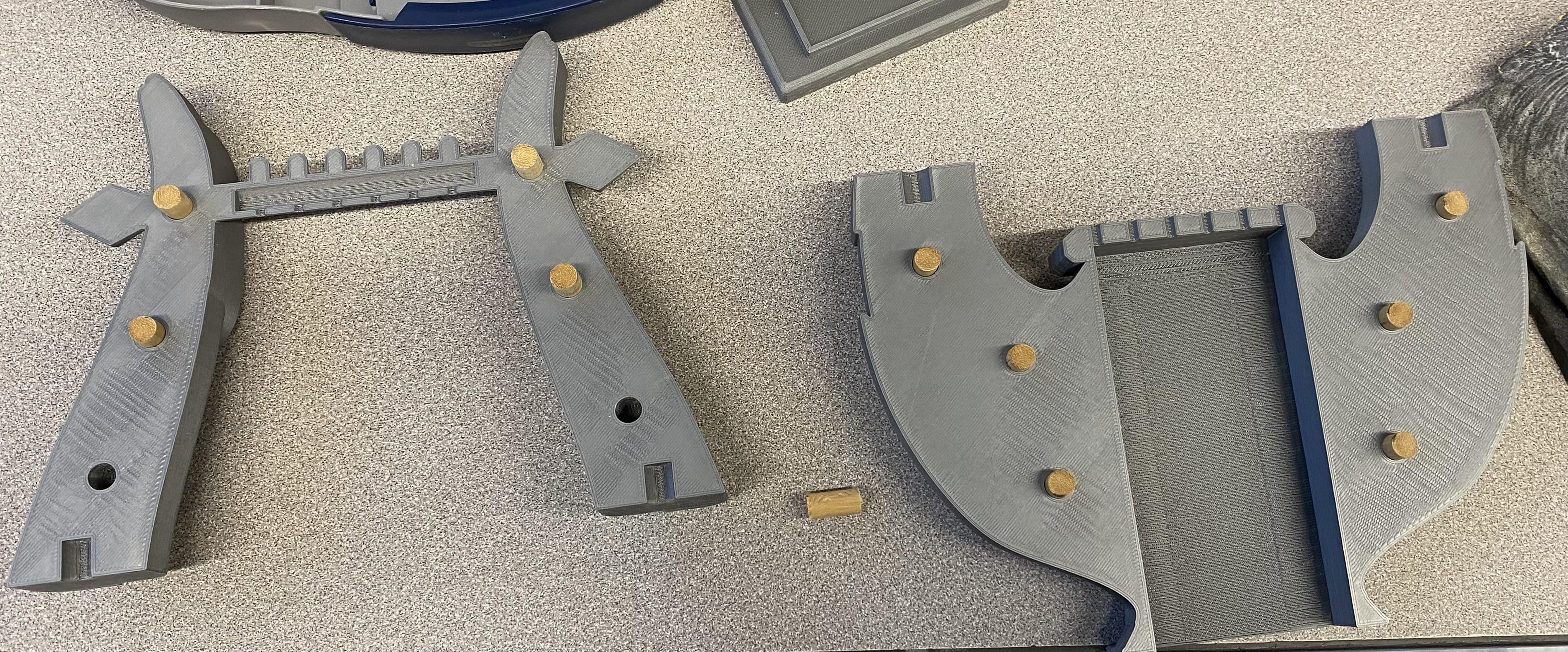
- Once the lyre is fully printed, get a wooden dowel.
- Cut the dowel into short pieces. We used a length of around 8 mm, make sure it is a little less than the length of the holes.
- Put each dowel piece into its respective hole. We started with putting the two bottom halves together horizontally.
Stringing the Lyre
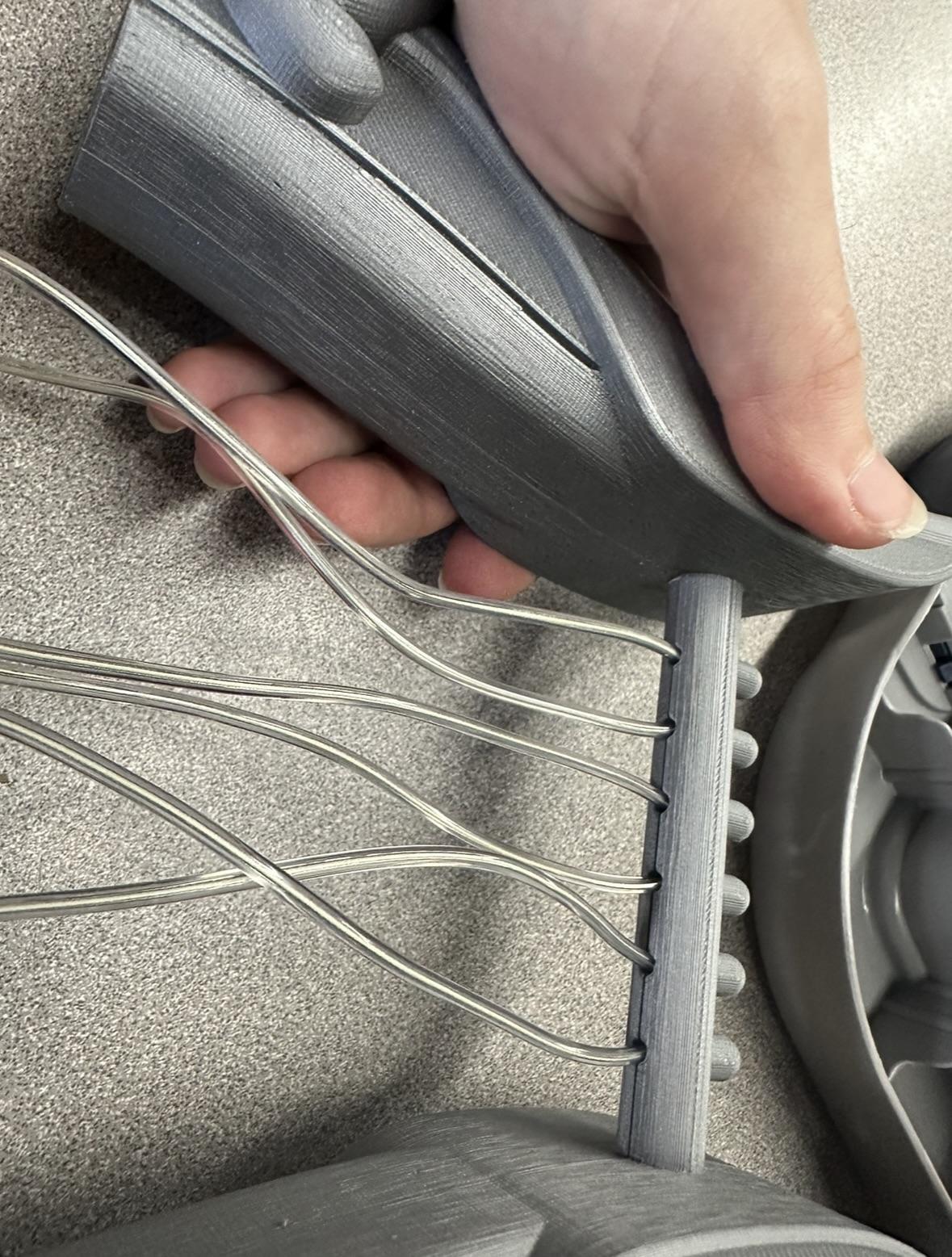
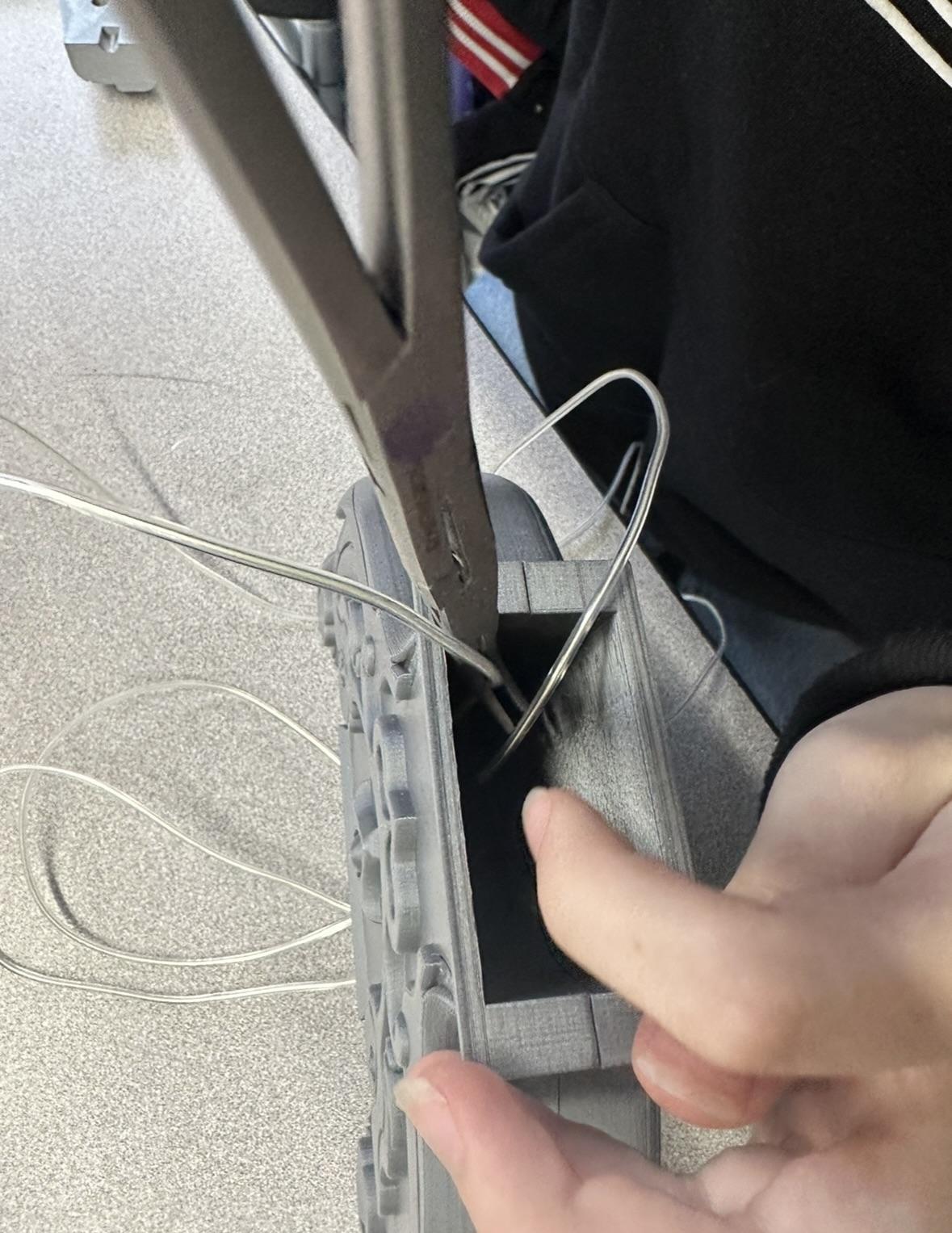
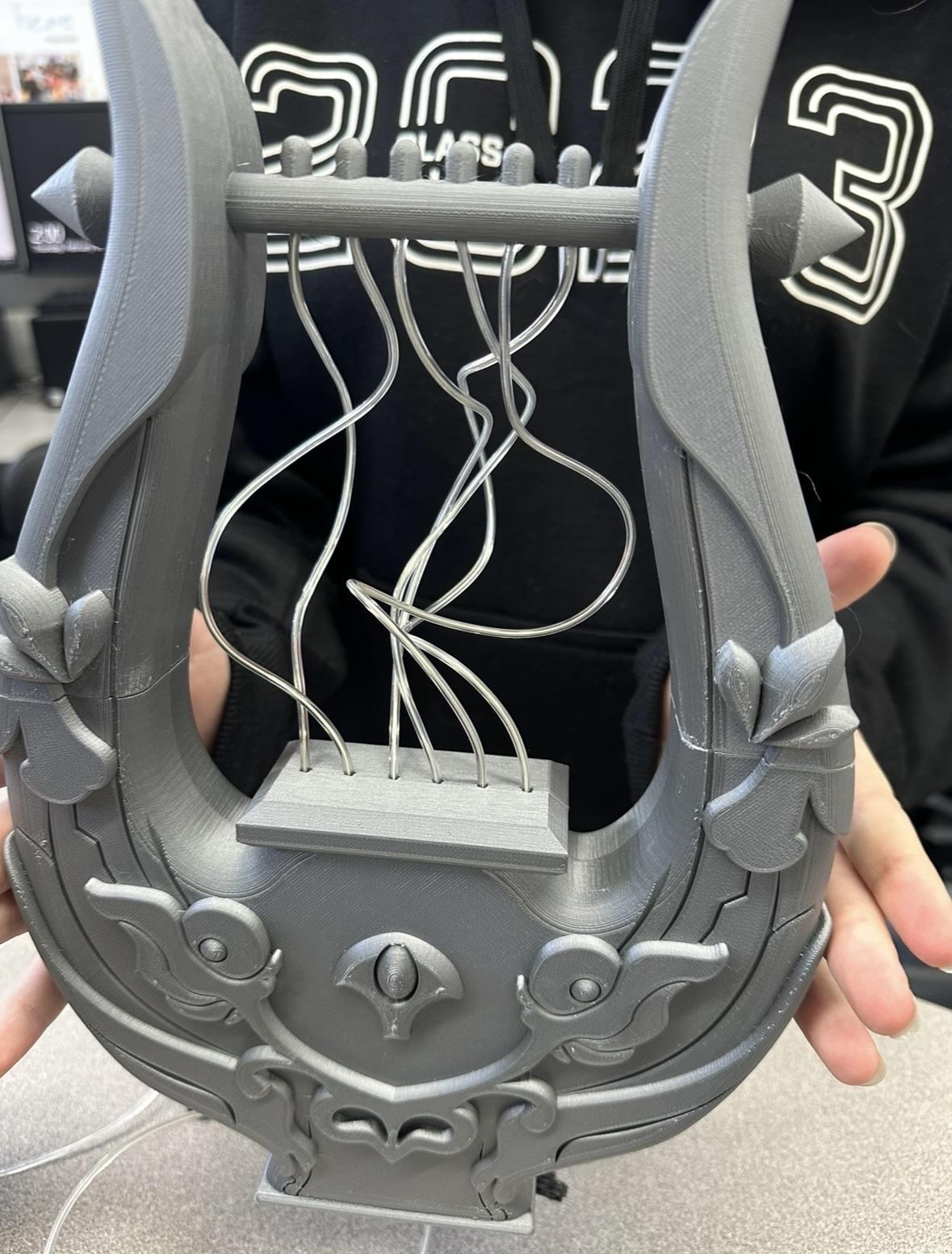
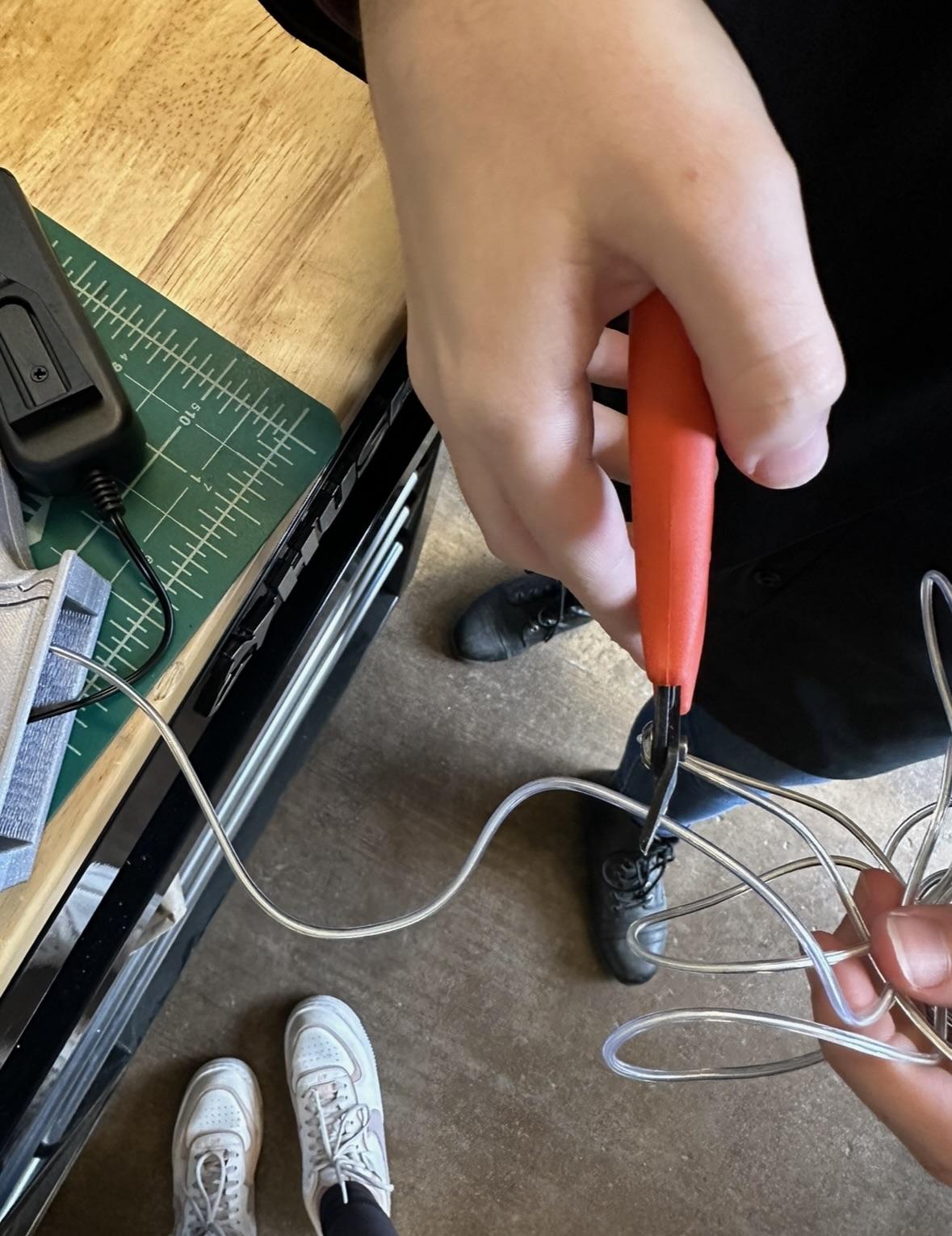
- Take the led lights and string them through the holes in the bottom half that was constructed in the last step. Make sure to alternate the direction the string goes in since the string will start from the bottom, loop in the top area, and come down to the bottom in the opposite direction. Since the holes are so small and the bottom space is very long, we used a hemostat to help us get the led through.
- Once the leds are looped through the bottom, have someone hold the top strings in the correct place (you may need multiple people to do this). Then have another person connect the two top pieces together. The top and bottom halves of the lyre should not be connected yet.
Assembly
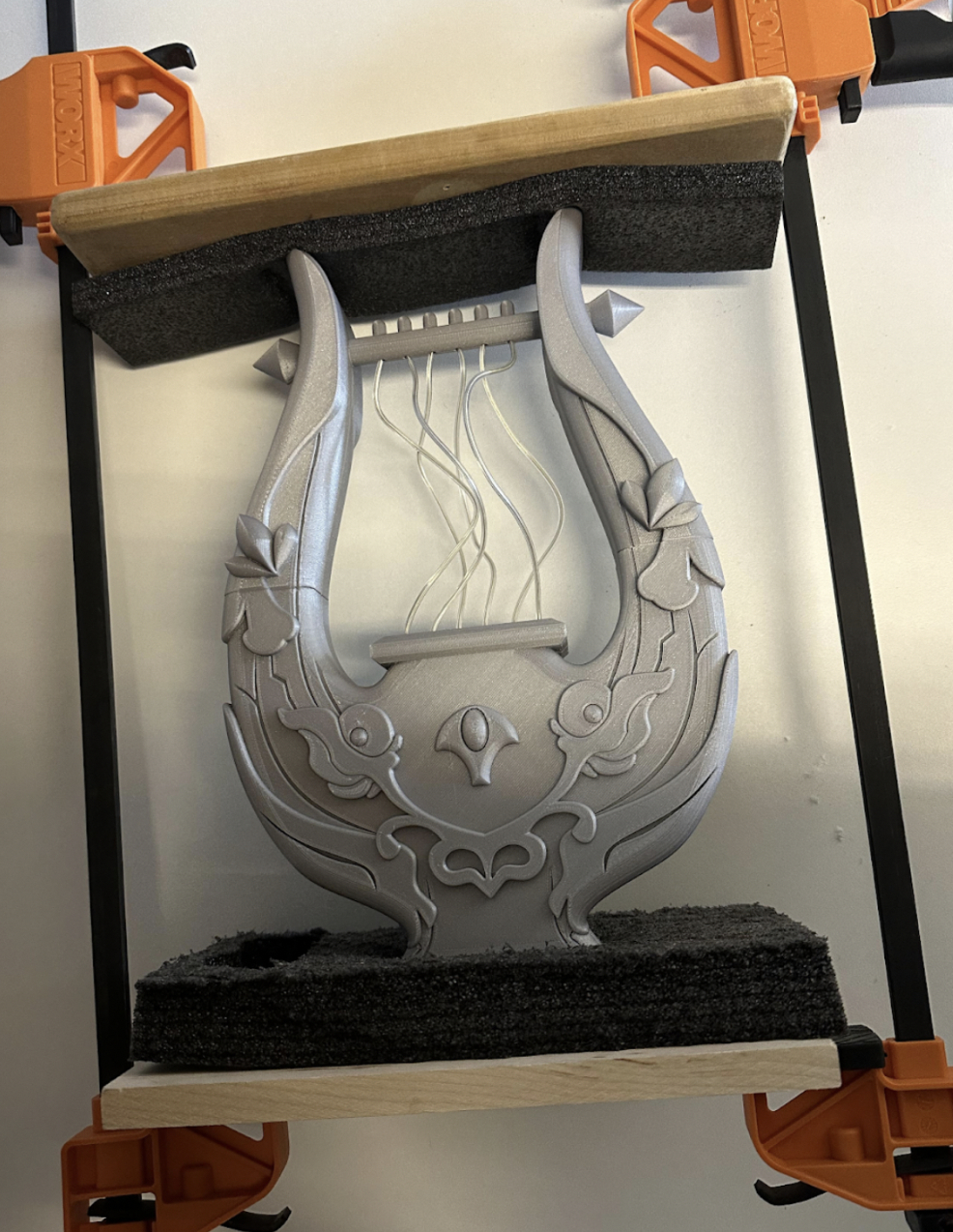
- Sand down any rough edges or extra filament if necessary. (this will help the lyre look more clean once you start painting it).
- Our lyre was a bit loose when connecting the top half and bottom half. So if necessary, super glue the two together. We did this by putting some glue on the dowel piece itself and also directly on the part. We then connected the pieces and clamped the lyre together to dry overnight. If you are using clamps, make sure to use foam and a piece of wood. The clamps will go directly on the piece of wood and place the foam between the wood and the lyre. This is because metal is stronger than plastic and without the foam, the lyre could break.
Adjustments
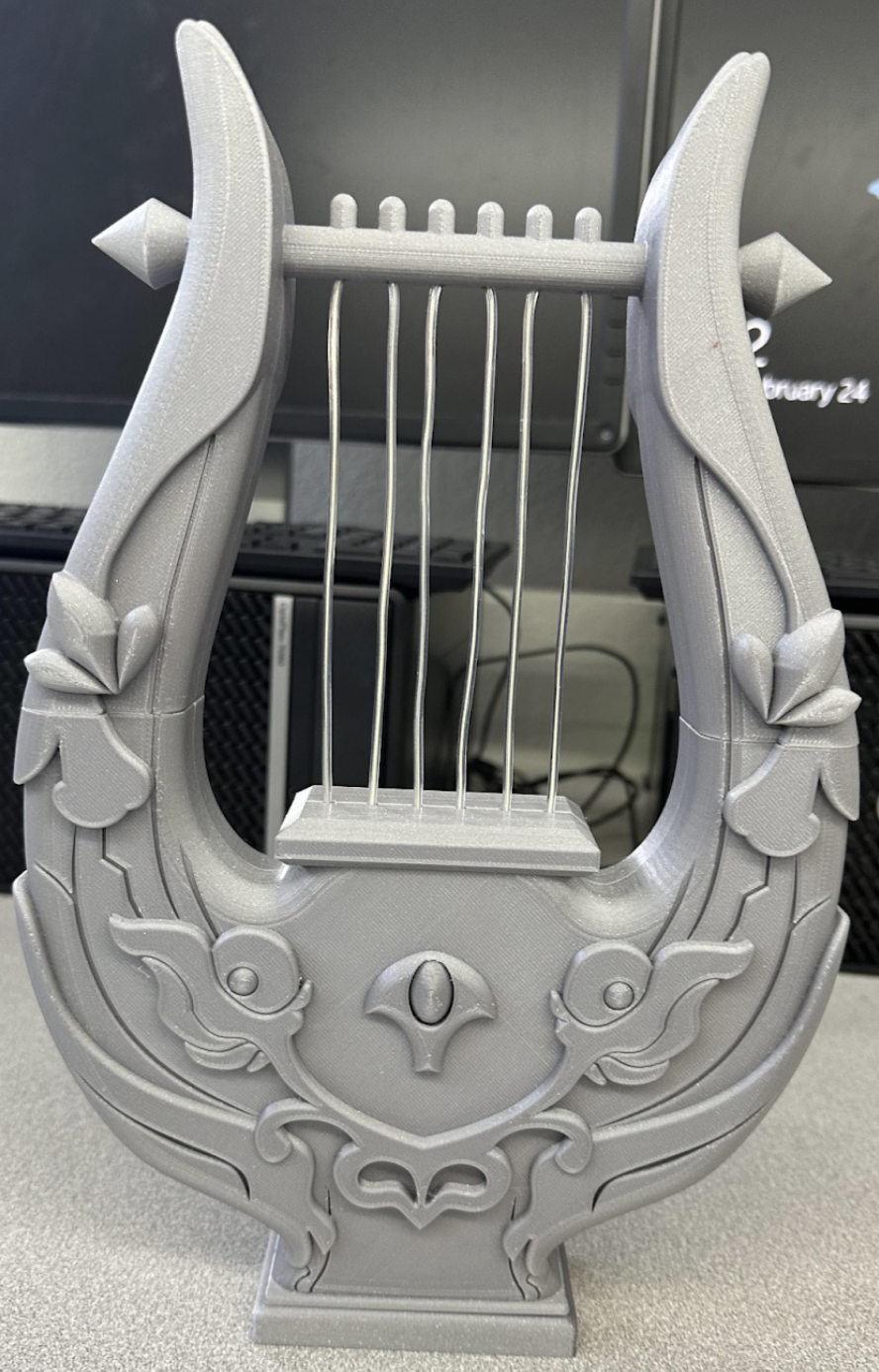
- With the LEDs connected on both ends, tighten the LEDs strings so there is less extra length.
- Connect the top half with the bottom half using the dowels.
- Tighten the LEDs one last time. The lyre should now look complete except for the paint color.
- Trim the extra led from the bottom so it fits into the extra compartment more cleanly.
Painting
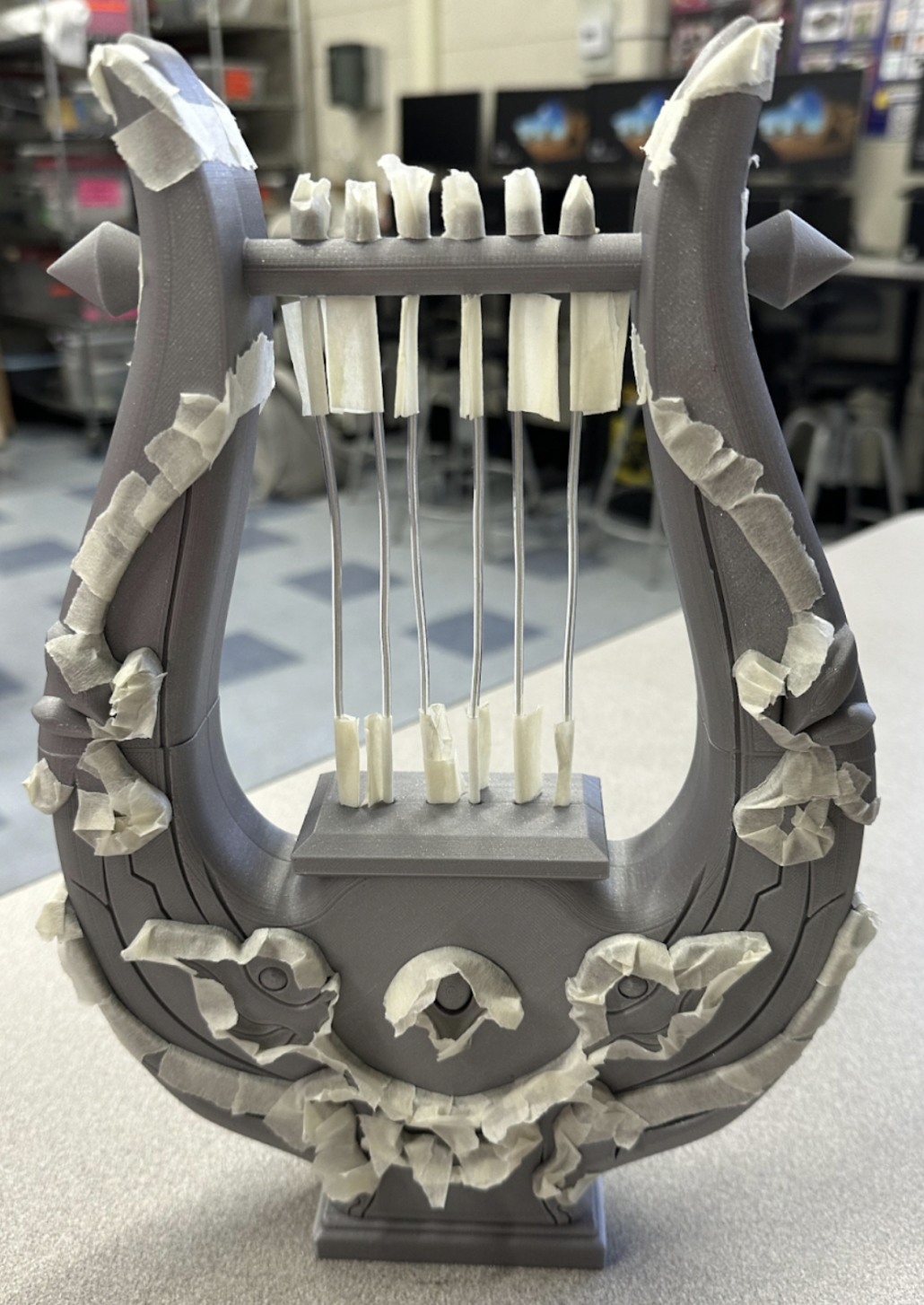
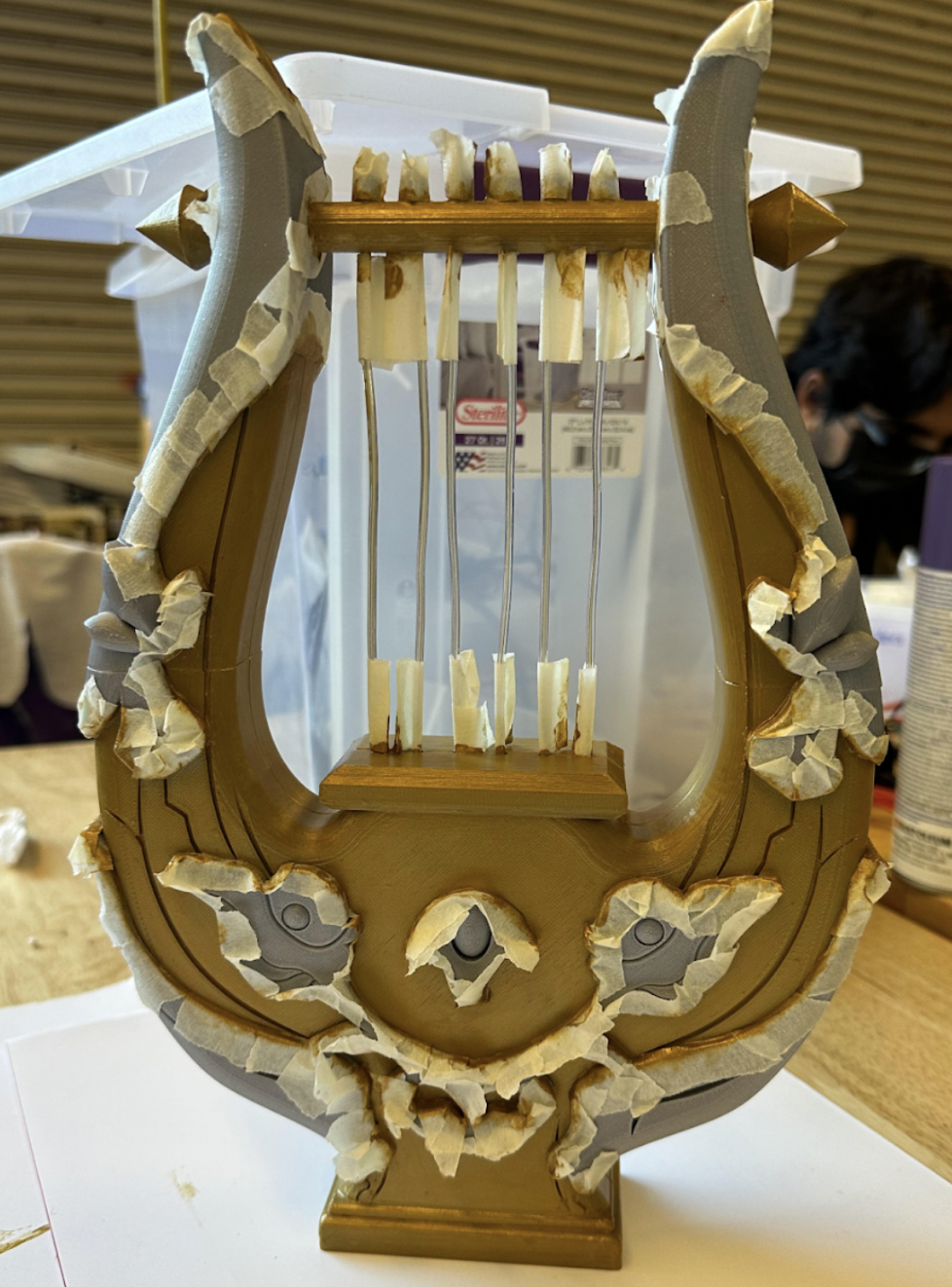
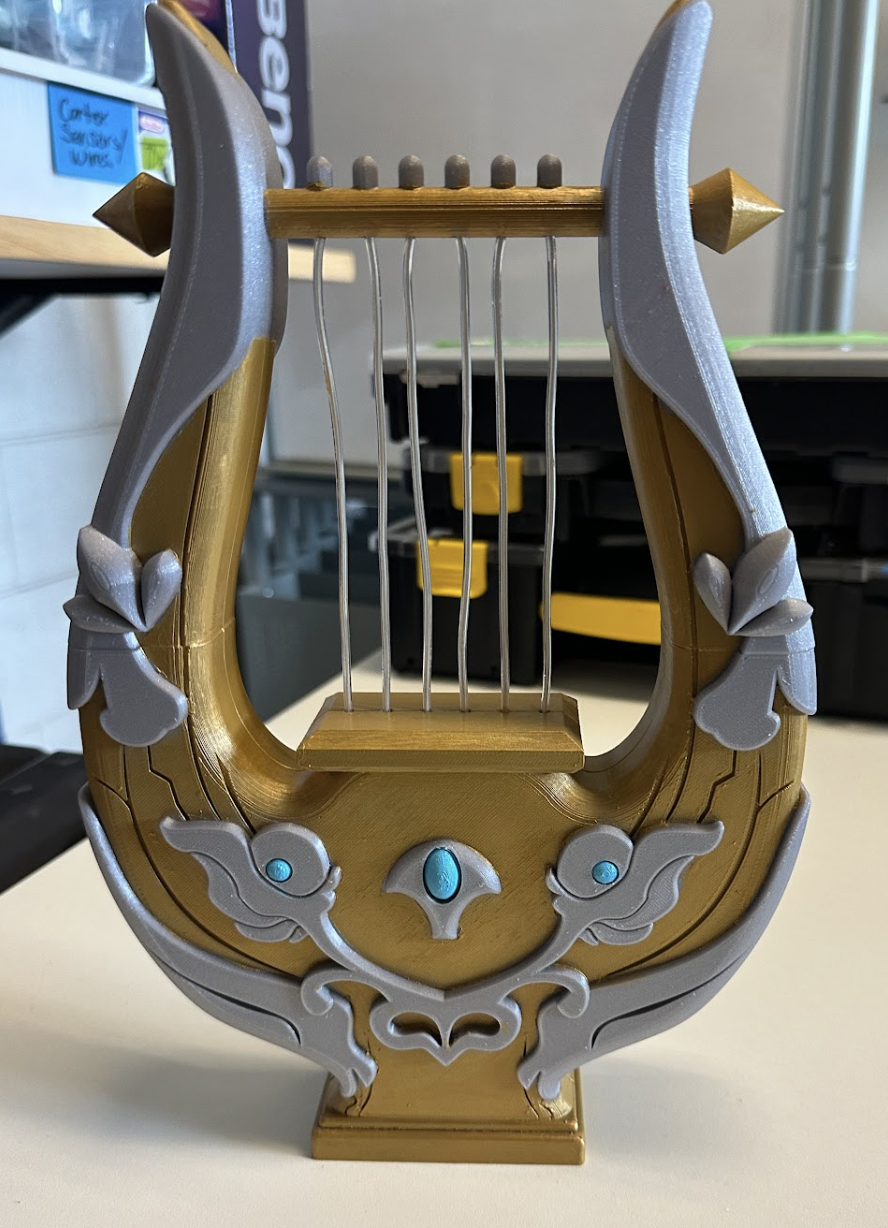
- Find an inspirational picture for what colors you want the lyre to be and what areas you would like to be painted. Our lyre’s base was sparkly silver filament. We decided to paint our details with gold to make it seem like gold wood.
- Once the super glue dries, mask off the areas you don’t want to paint.
- Start painting the desired areas. We used acrylic paint and did around 3 coats of it since it was pretty thin.
- Once the paint has dried, remove the tape.
- Turn on the LEDs and slip on the bottom piece. Your lyre is finally completed!
All Finished!
